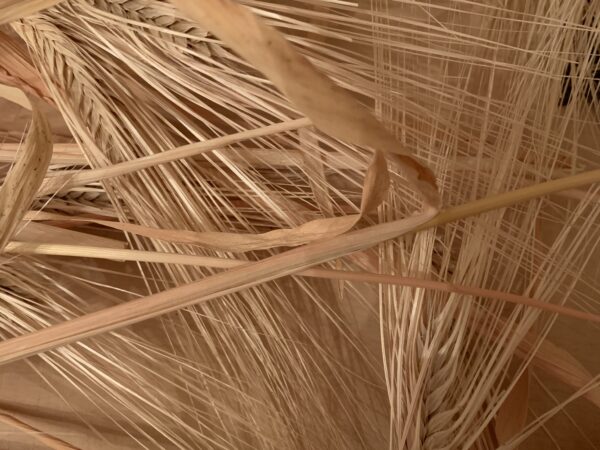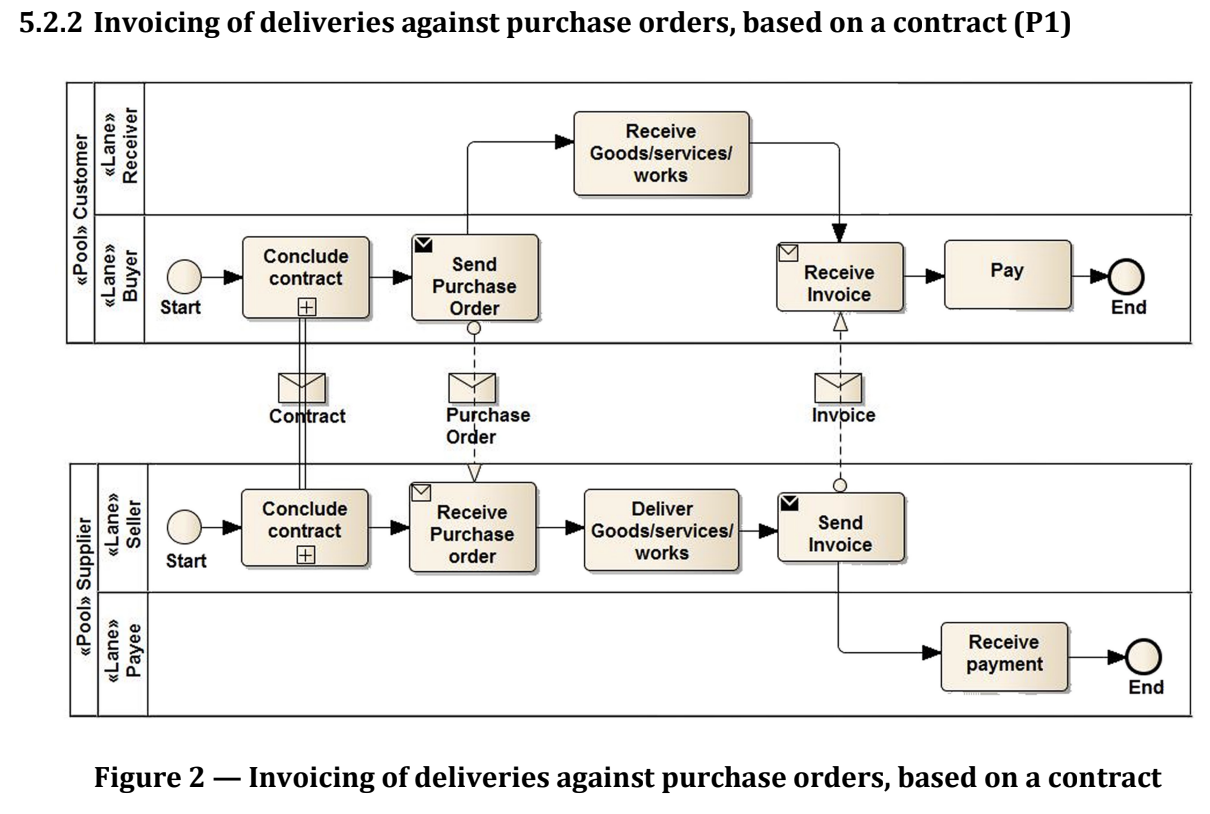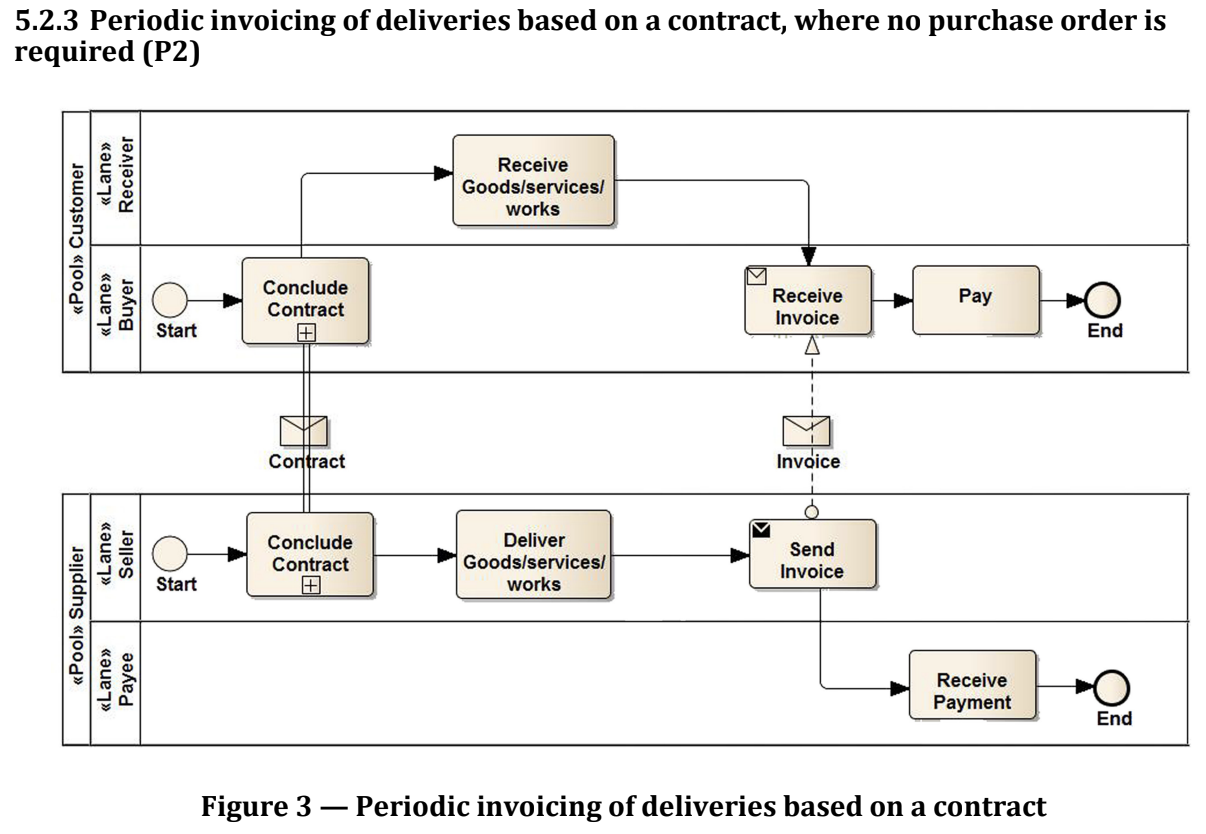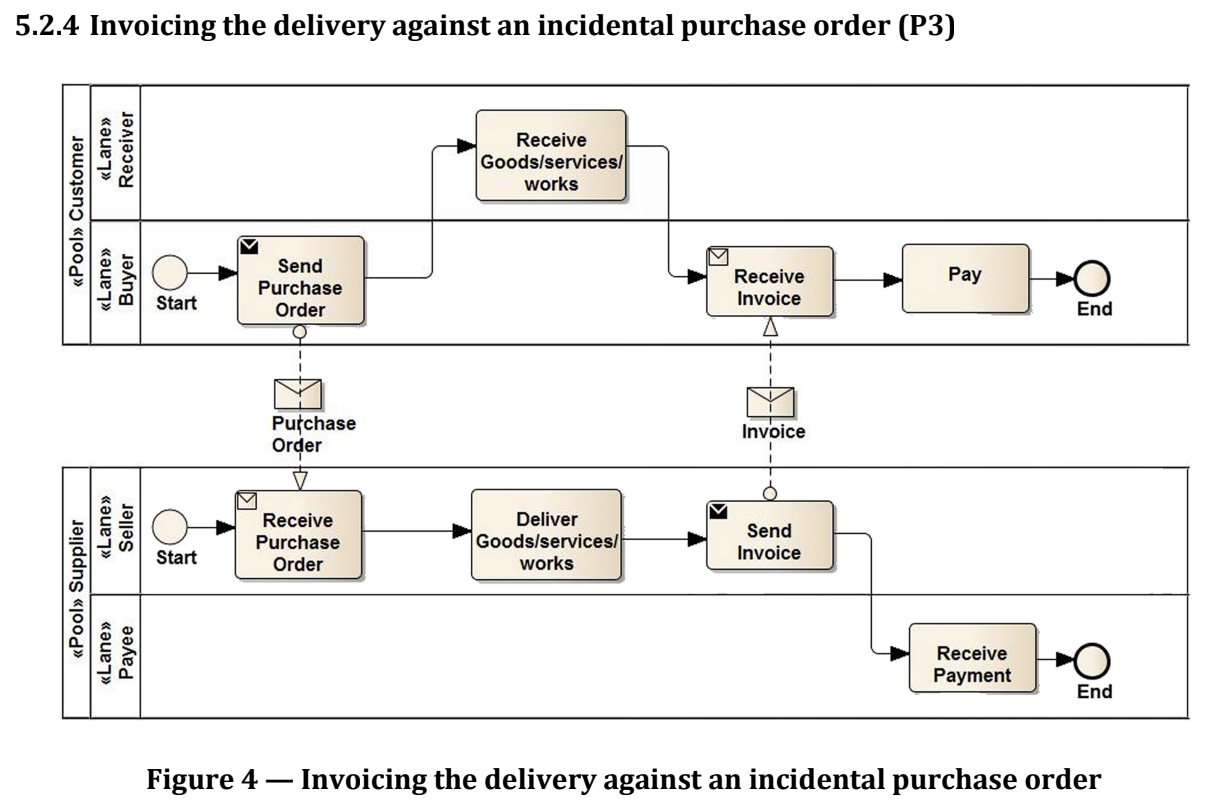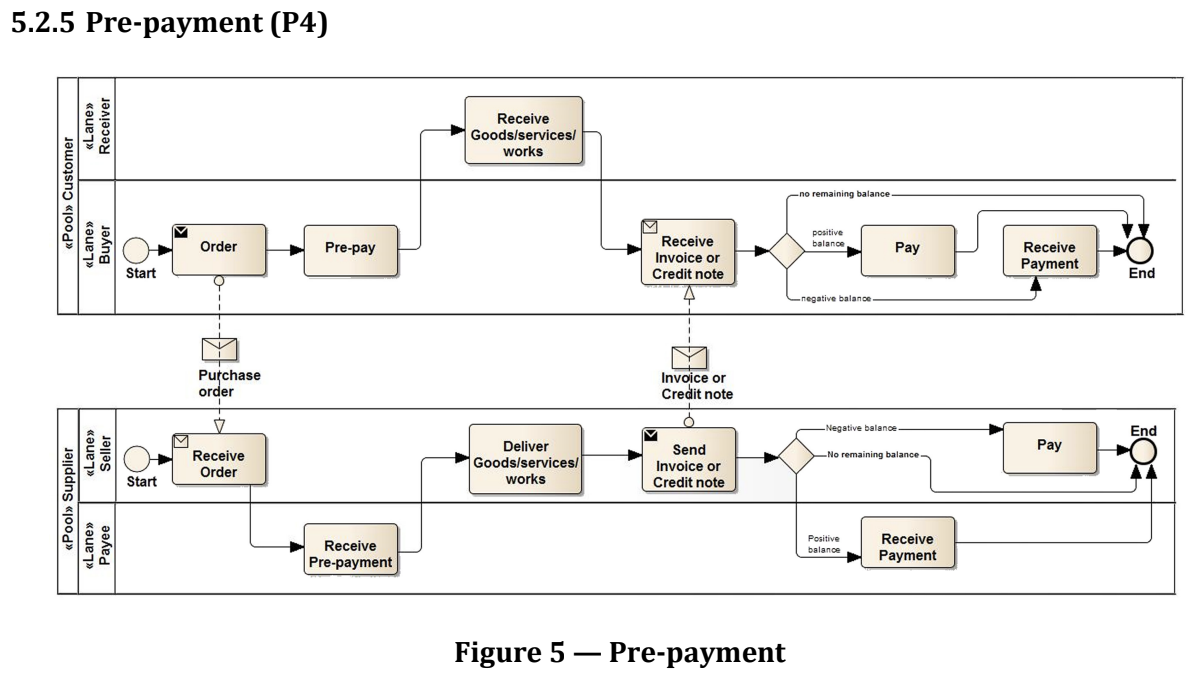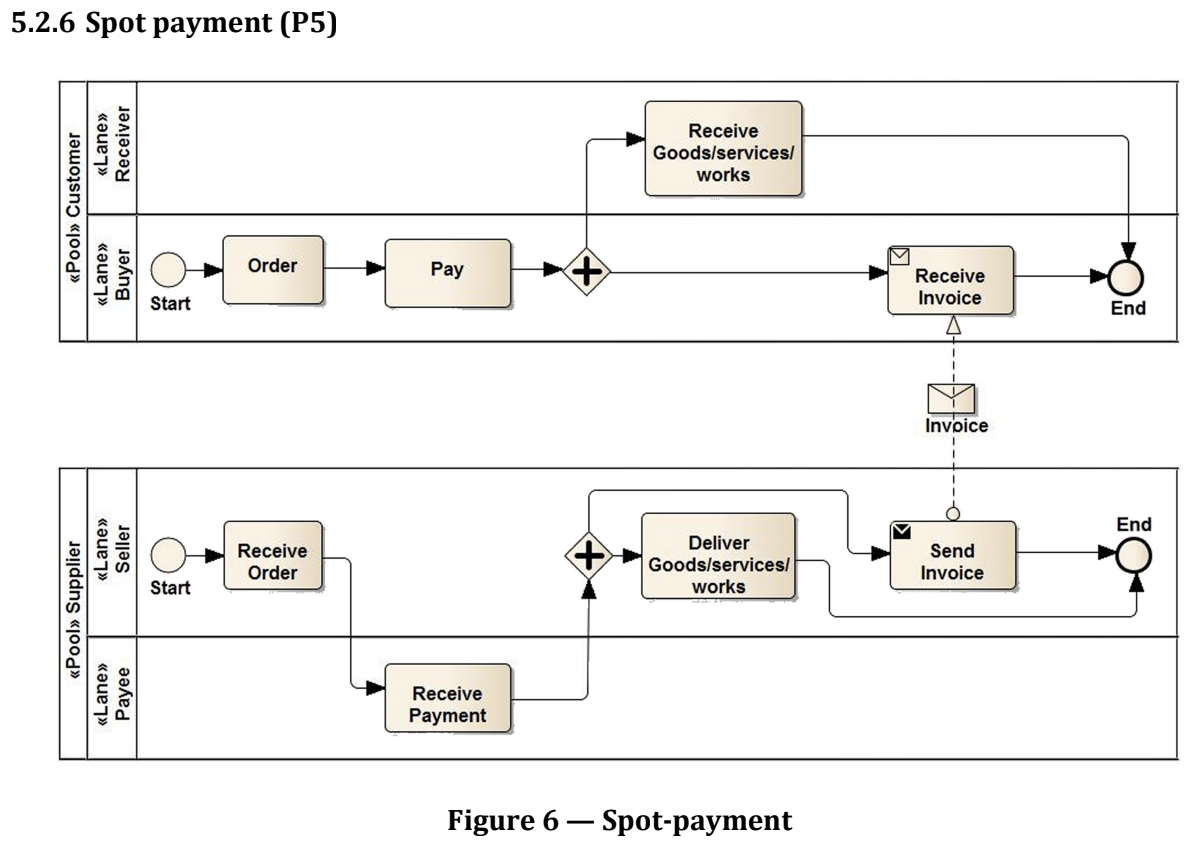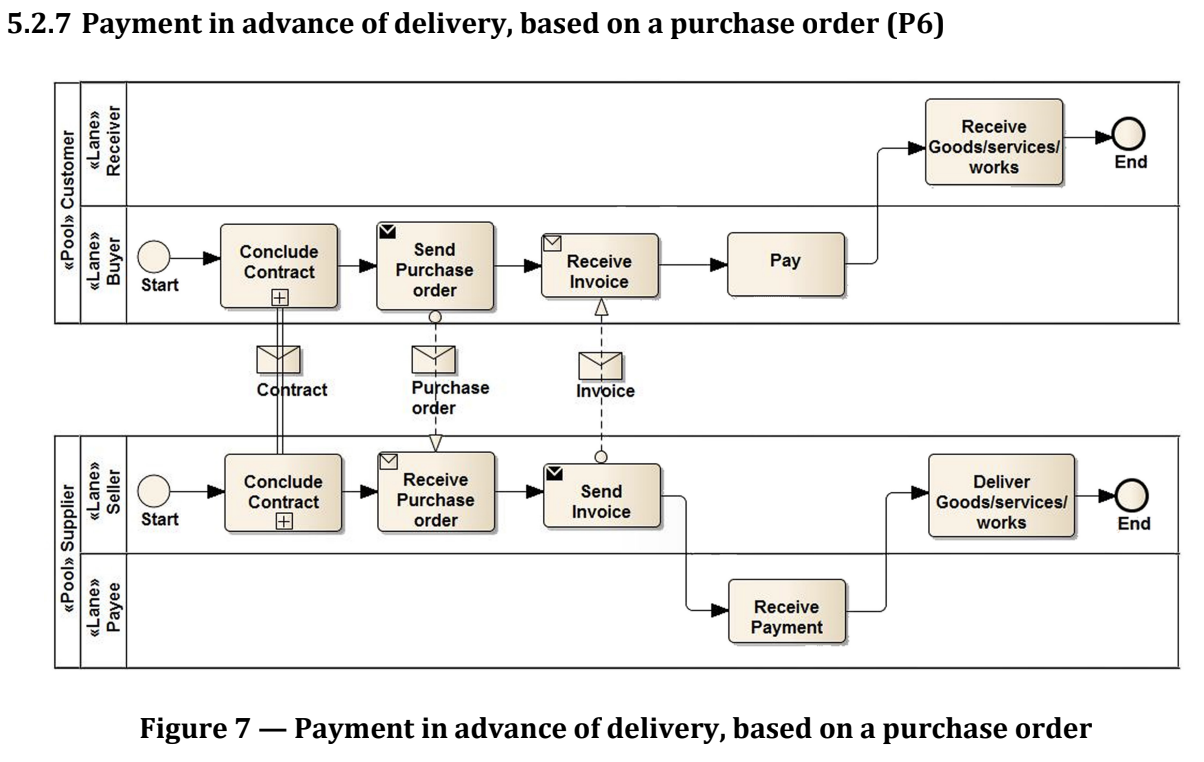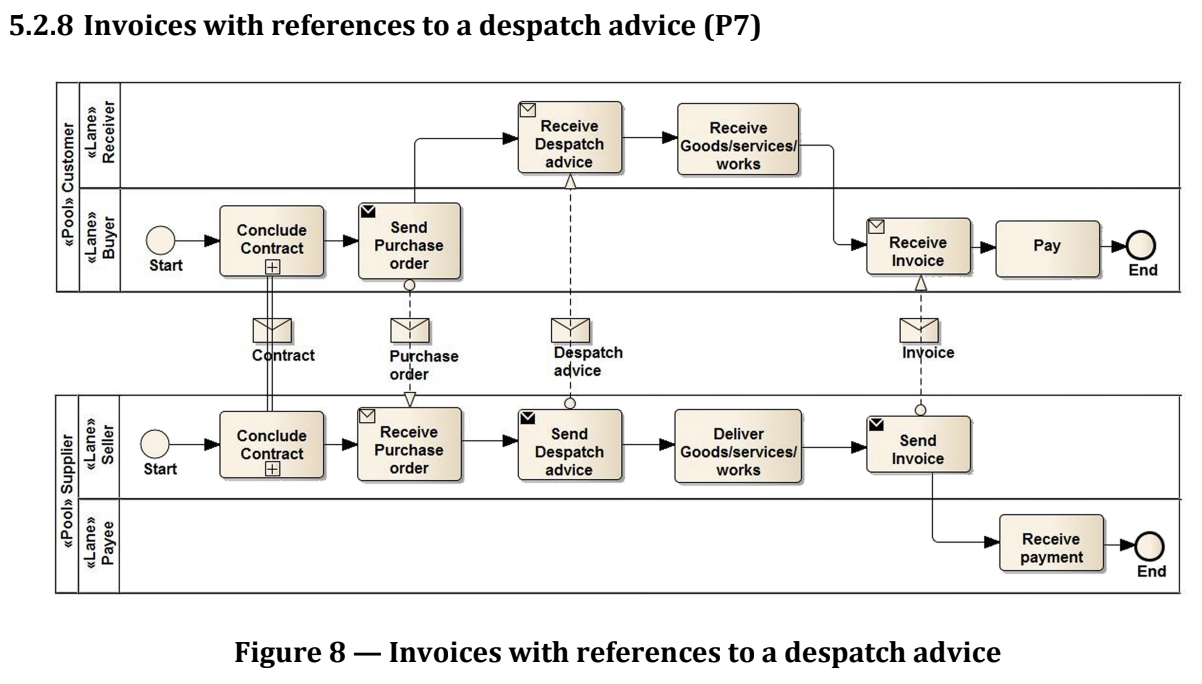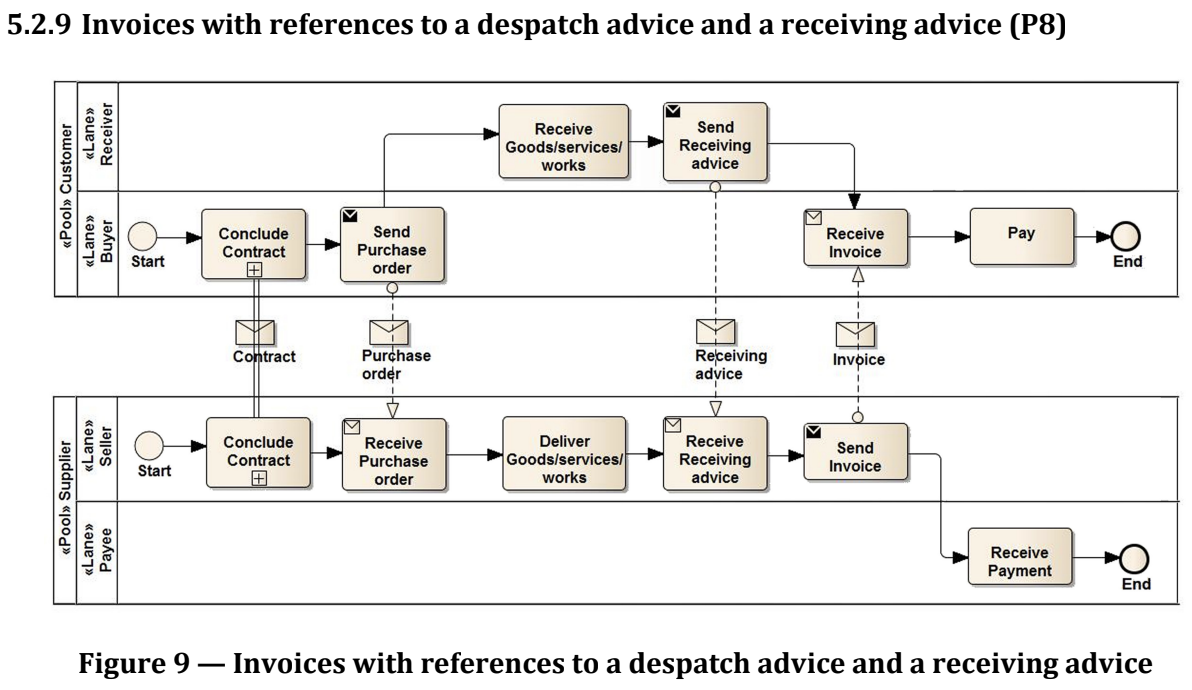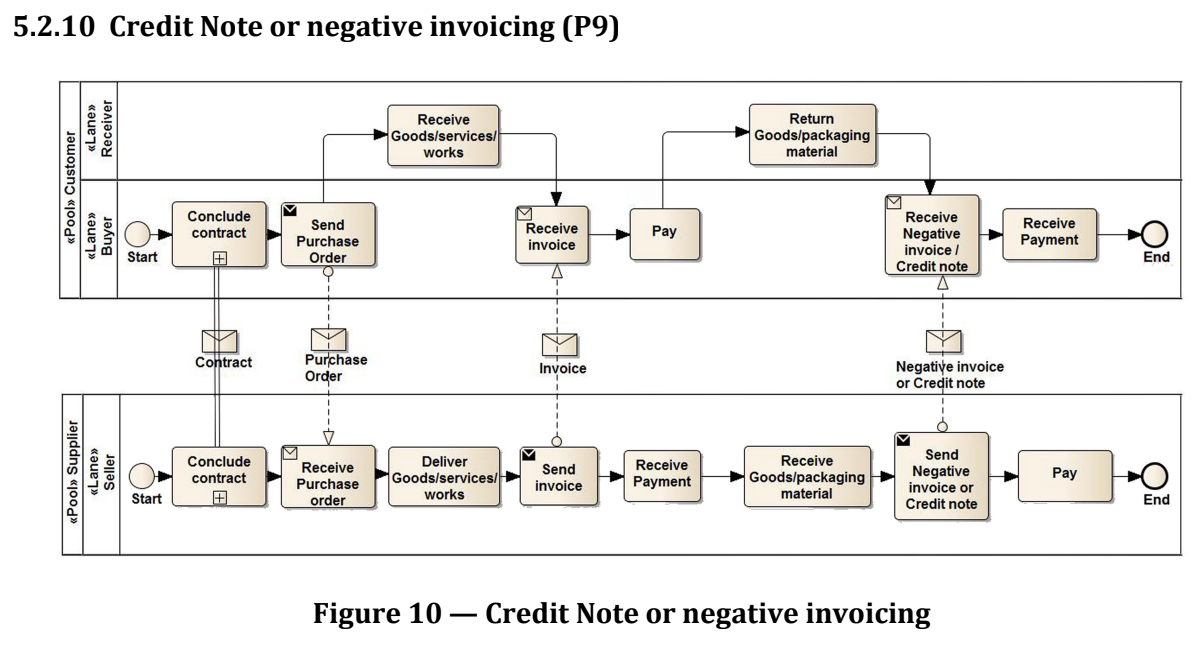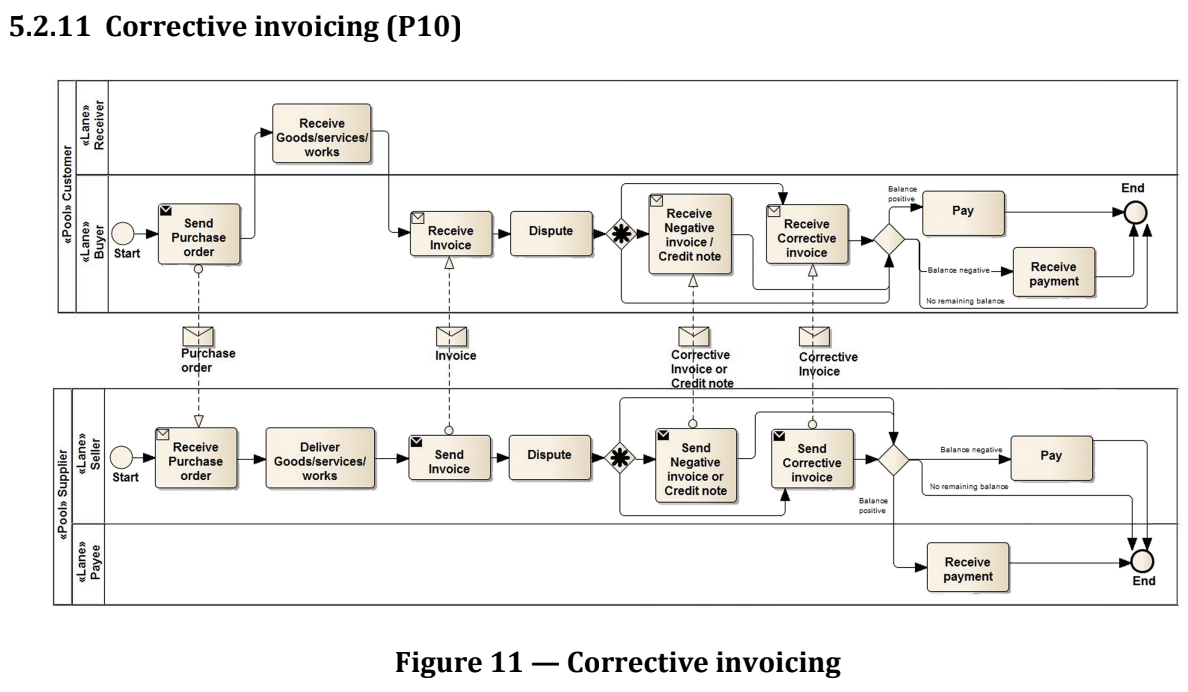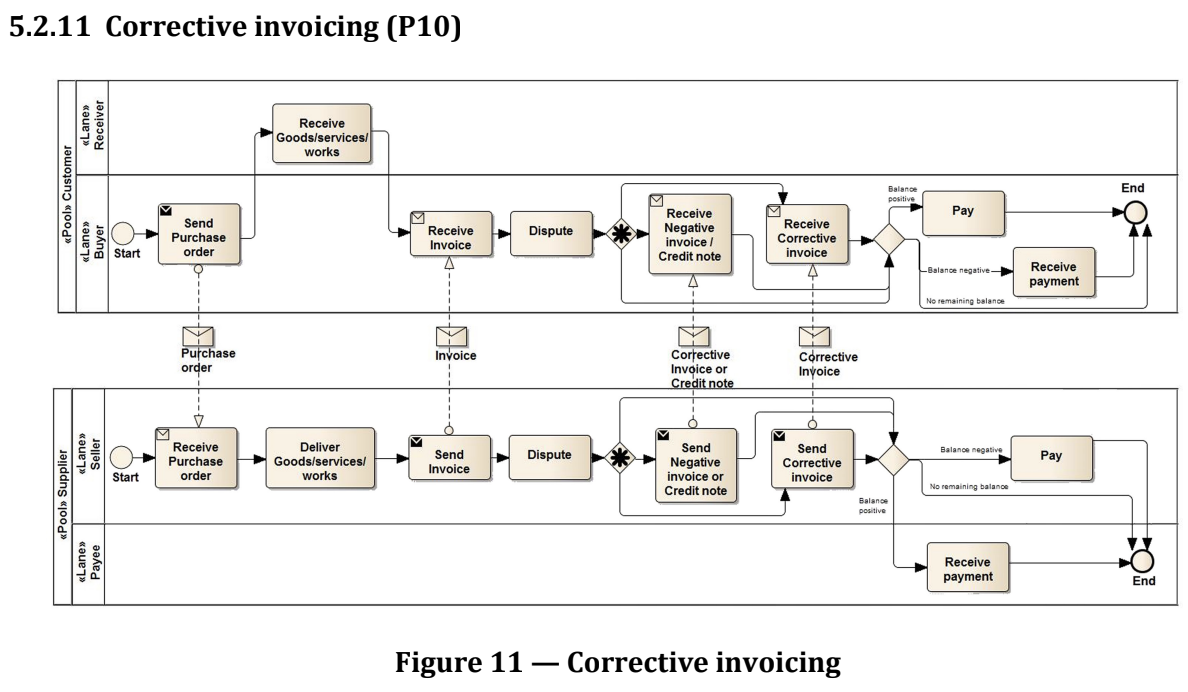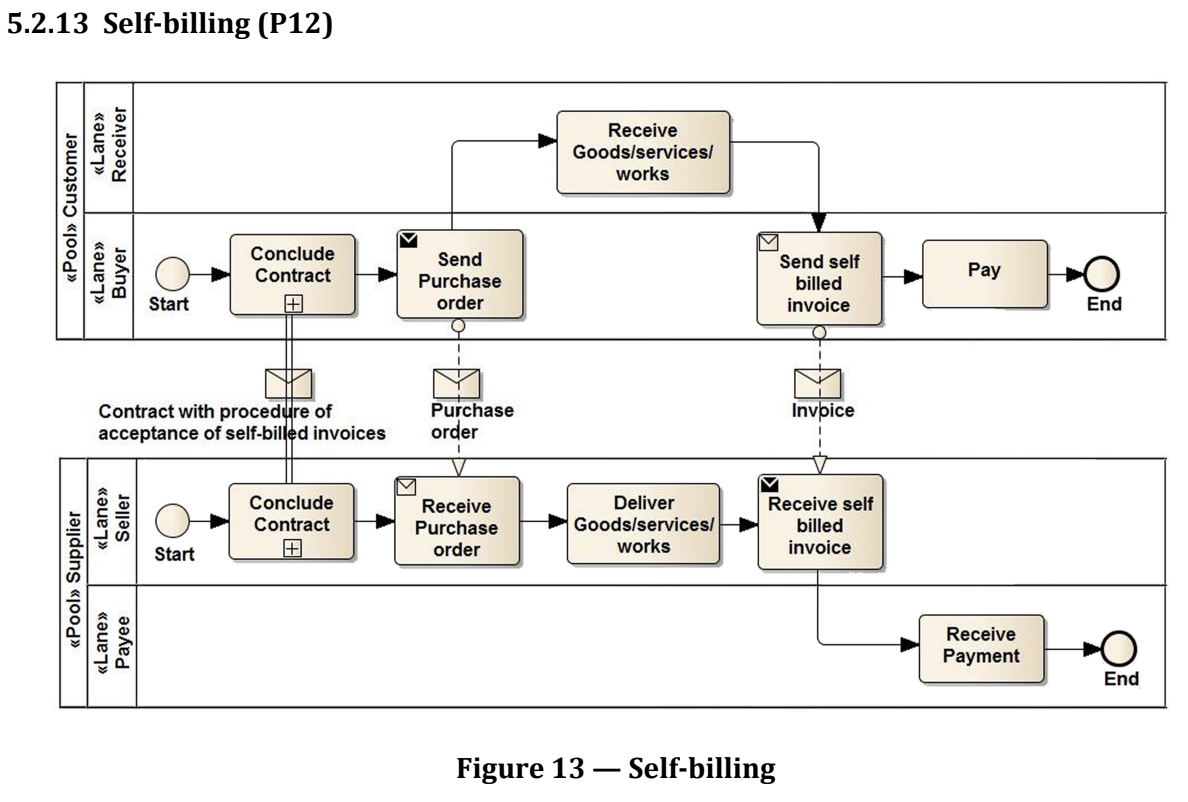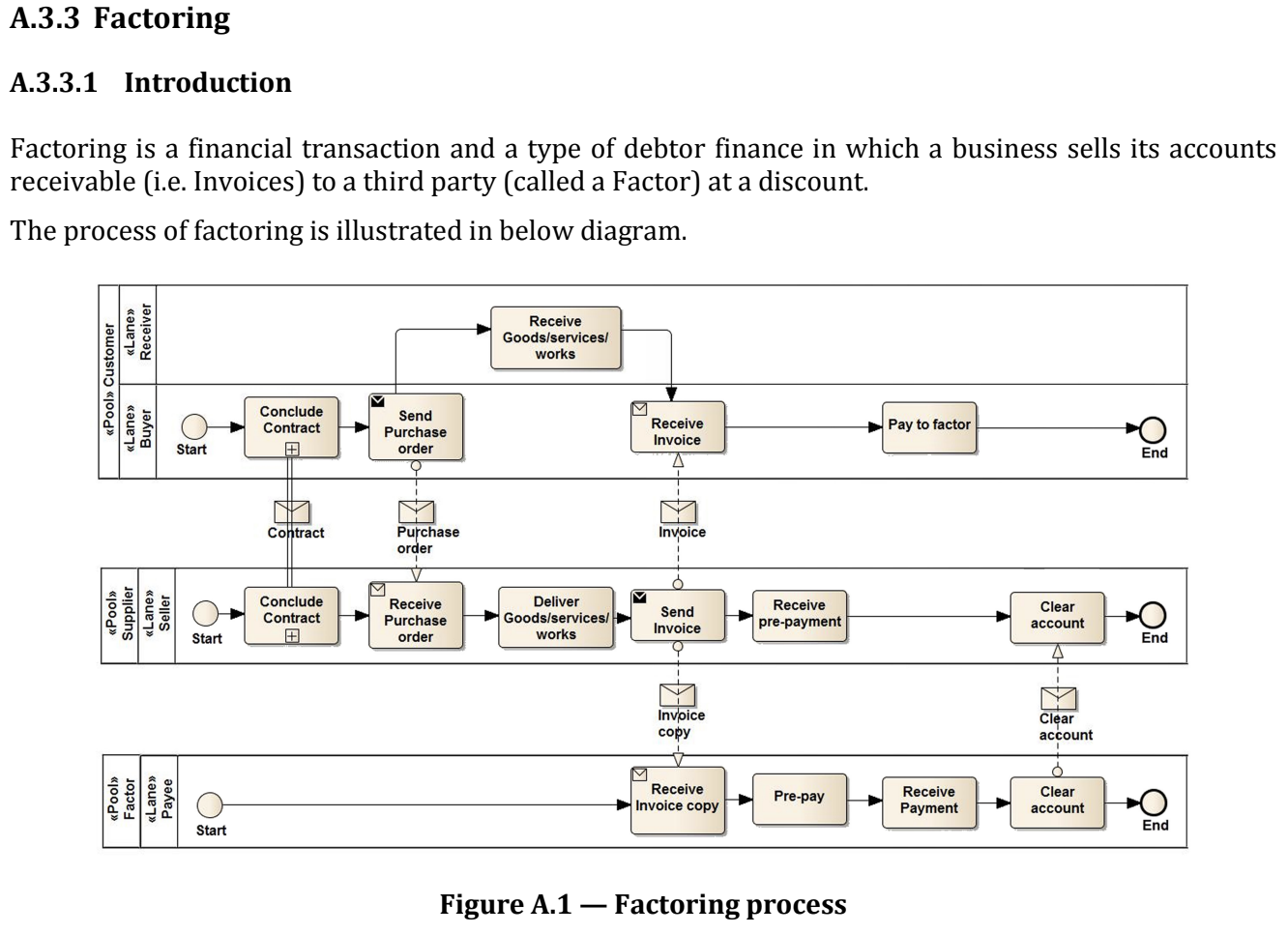Views: 591
- JP PINT 解体新書 1.a 文書レベル
- 1. デジタルインボイスのXML要素について
- 2. デジタルインボイス全体についての情報
- 3. 請求期間
- 4. デジタルインボイスに関係する文書への参照
- 5. 文書間の関連とビジネスプロセス
- 6. 請求するオブジェクトIDおよび添付書類
- 7. 欧州規格 EN 16931-1が規定しているコアインボイスの機能要件
- 8. 入札又はロット参照及びプロジェクト参照
- 9. 売り手
- 10. 買い手
- 11. 支払先
- 12. 売り手税代理人
- 13. 納入先
- 14. 支払指示
- 15. 支払条件
- 16. 請求書レベルの返金
- 17. 請求書レベルの追加請求
- 18. 請求書消費税合計金額
- 19. 会計通貨での請求書消費税合計金額
- 20. 請求書総合計金額
- 21. EN 16931 コアインボイスのセマンティック データ モデル
JP PINT 解体新書 1.a
Nobuyuki SAMBUICHI
ISO/TC295 Audit data services/SG1 Semantic model Convener
Peppol BIS Standard Invoice JP PINT 画面の左下にある Download resources ボタンに気をとめられる方は少ないかもしれませんが、このボタンでダウンロードされる resources.zip ファイルには、パッケージやサービスのJP PINT対応開発に役立ついくつかのファイルが含まれています。
今回の『解体新書』シリーズでは、いくつかのファイルの内容を確認しながらUBL 2.1に基づくJP PINTのXMLインスタンス文書がどのように定義されているのか紹介します。
本シリーズは、システム開発者(プログラマー / システムエンジニア)を対象としており、読者がXMLスキーマを理解していることを前提として記述しています。また、XPathについても基本的な事項を理解されていると想定しています。
第1回目は、Japan PINT Invoice UBL Example.xmlです。この文書は、実例というよりは主要なビジネス用語を網羅して紹介する例として定義されています。
なお、当初の予想を超えて文章が長くなってしまいましたので、明細行レベルについてはページを分けて記述します。後半部分は、こちらの記事 JP PINT 解体新書 1.b をお読みください。
この他のファイルは、具体的な用途別に定義内容を紹介するものです。例えば、Allowance & Charge、Summarized invpice, Tax currency code, etc.といった内容です。
-
Japan PINT Invoice UBL Example.xml JP PINT 解体新書1.a 文書レベル JP PINT 解体新書1.b 明細行レベル
-
Japan PINT Invoice UBL Example1-minimum.xml JP PINT 解体新書2 適格請求書最小構成
-
Japan PINT Invoice UBL Example2-TaxAcctCur.xml
-
Japan PINT Invoice UBL Example3-SumInv1.xml
-
Japan PINT Invoice UBL Example4-SumInv2.xml
-
Japan PINT Invoice UBL Example5-AllowanceCharge.xml JP PINT 解体新書3 返金及び追加請求 (Allowance & Charge)
-
Japan PINT Invoice UBL Example6-CorrInv.xml
-
Japan PINT Invoice UBL Example7-Return.Quan.ItPr.xml
-
Japan PINT Invoice UBL Example9-SumInv1 and O.xml
-
全般
JP PINT 解体新書4 デジタル自動処理と金額の検算ルール
JP PINT V1.0 正誤表
CEF eInvoicingに基づいたJP PINT1.0ルール検証環境とテスト
Japan PINT Invoice UBL Example.xmlをHTML変換表示
『EN 16931-1 Annnex A 電子インボイスの例』 には、欧州規格で紹介されているデジタルインボイスの記載例について紹介していますので併せてご覧ください。
ご参考:
当事務所提供 JP PINT実証研究ページ
(翻訳したセマンティックモデルやUBL2.1からの構文バインディングも含んでいます)
1. デジタルインボイスのXML要素について
<?xml version=”1.0″ encoding=”UTF-8″?>
<Invoice
xmlns=”urn:oasis:names:specification:ubl:schema:xsd:Invoice-2″
xmlns:cac=”urn:oasis:names:specification:ubl:schema:xsd:CommonAggregateComponents-2″
xmlns:cbc=”urn:oasis:names:specification:ubl:schema:xsd:CommonBasicComponents-2″
xmlns:ccts=”urn:un:unece:uncefact:documentation:2″
xmlns:ext=”urn:oasis:names:specification:ubl:schema:xsd:CommonExtensionComponents-2″
xmlns:qdt=”urn:oasis:names:specification:ubl:schema:xsd:QualifiedDatatypes-2″
xmlns:udt=”urn:un:unece:uncefact:data:specification:UnqualifiedDataTypesSchemaModule:2″
xmlns:xsd=”http://www.w3.org/2001/XMLSchema”
xmlns:xsi=”http://www.w3.org/2001/XMLSchema-instance”>
<!–
Japan common commercial invoice, example
-→
<!–
UBL Version is not defined in JP PINT -→
<cbc:UBLVersionID>2.1</cbc:UBLVersionID>
Download filesで提供されるXMLインスタンス文書のルート要素は、Invouve 要素。 要素属性にcacやcbcといった名前空間の定義が含まれています。
Invoice 要素の名前空間は、xmlns=”urn:oasis:names:specification:ubl:schema:xsd:Invoice-2″で定義されています。
ただしこの定義では、”urn:oasis:names:specification:ubl:schema:xsd:Invoice-2″を定義しているXMLスキーマがどこにあるか指定されていないので、通常のXML文書編集ソフトでこのXMLインスタンス文書を開くと次のようなエラーが報告されてしまいます。

これは、Open Peppolでも使用しているOxygen XML Editorが報告する画面です。
JavaでXMLスキーマ検証する際には、次に紹介するようにプログラムで明示的にXMLスキーマの場所を指定するので問題にならないようですが、XML編集ソフトで内容を確認しようとするといきなりこのメッセージが報告されるので驚きました。
通常のXML文書編集ソフトでこのXMLインスタンス文書を開いても自動的にXMLスキーマの箇所を判定させるためには、次のように Invoice 要素の属性に @xsi:schemaLocation を追加定義します。
xsi:schemaLocation=”urn:oasis:names:specification:ubl:schema:xsd:Invoice-2 http://docs.oasis-open.org/ubl/os-UBL-2.1/xsd/maindoc/UBL-Invoice-2.1.xsd”
また、JP PINT v1.0の構文バインディングで現れない要素 <cbc:UBLVersionID>2.1</cbc:UBLVersionID> が定義されています。
この要素は、BIS Billing 3.0でもSyntax bindingで定義されていない要素ですが、実際には BIS Billing 3.0 のスキーマトロンの構文ルールでは、次の UBL-CR-002 (warning) が定義されており、cbc:UBLVersionID を含めるときには、2.1を指定することとされています。
Appendix D: Syntax rules
UBL-CR-002 (warning)
A UBL invoice should not include the UBLVersionID or it should be 2.1
UBL 請求書に UBLVersionID を含めないか、含めるのであればその値を2.1としなければならない。
Appendix D Syntax rules
JP PINT v1.0ではこのルールがありませんので、定義されていない要素は含めてはいけないと思います。 PINT complianceでは、
Sending compliance to PINT based BIS
Seller (C1)
A seller shall not send messages that are not compliant to the specification identified by the invoice specification identifier (ibt-024).
売り手は、請求書仕様識別子 (ibt-024) によって識別される仕様に準拠していないメッセージを送信してはなりません。
とされていますので、どこにも定義されていない要素を含めたXMLインスタンス文書は標準仕様に準拠していない(not complient)と考えますがいかがでしょうか。
なお、JavaプログラムでXMLスキーマ検証する処理は次のようなコーディングです。
package wuwei.japan_core.utils;
import java.io.File;
import java.io.IOException;
import javax.xml.XMLConstants;
import javax.xml.transform.stream.StreamSource;
import javax.xml.validation.Schema;
import javax.xml.validation.SchemaFactory;
import javax.xml.validation.Validator;
import org.xml.sax.SAXException;
/**
* @author SAMBUICHI, Nobuyuki
*
*/
public class XML_SchemeValidation {
/**
* 単体テスト用
* @param args mainの引数
*/ public static void main(String[] args) {
System.out.println("EmployeeRequest.xml validates against Employee.xsd? "
+ validateXMLSchema("UBL-2.1/xsd/maindoc/UBL-Invoice-2.1.xsd", "Japan PINT Invoice UBL Example.xml"));
System.out.println("EmployeeRequest.xml validates against Employee.xsd? "
+ validateXMLSchema("http://docs.oasis-open.org/ubl/os-UBL-2.1/xsd/maindoc/UBL-Invoice-2.1.xsd", "Japan PINT Invoice UBL Example.xml"));
}
/**
* XMLスキーマ検証
* Copied from following page.<br>
* https://www.digitalocean.com/community/tutorials/how-to-validate-xml-against-xsd-in-java
* @param xsdPath XMLスキーマファイル
* @param xmlPath XMLインスタンス文書ファイル
* @return boolean XMLスキーマ検証結果
*/
public static boolean validateXMLSchema(String xsdPath, String xmlPath){
try {
SchemaFactory factory =
SchemaFactory.newInstance(XMLConstants.W3C_XML_SCHEMA_NS_URI);
Schema schema = factory.newSchema(new File(xsdPath));
Validator validator = schema.newValidator();
validator.validate(new StreamSource(new File(xmlPath)));
} catch (IOException | SAXException e) {
System.out.println("Exception: "+e.getMessage());
return false;
}
return true;
}
}JavaのXMLライブラリを使用しています。
* javax.xml.XMLConstants
* javax.xml.transform.stream.StreamSource
* javax.xml.validation.Schema
* javax.xml.validation.SchemaFactory
* javax.xml.validation.Validator
2. デジタルインボイス全体についての情報
<cbc:CustomizationID>urn:fdc:peppol:jp:billing:3.0</cbc:CustomizationID> <!-- IBT-024 Specification identifier --> <cbc:ProfileID>urn:fdc:peppol.eu:2017:poacc:billing:01:1.0</cbc:ProfileID> <!-- IBT-023 Business process type --> <cbc:ID>156</cbc:ID> <!-- IBT-001 Invoice number --> <cbc:IssueDate>2023-10-24</cbc:IssueDate> <!-- IBT-002 Invoice issue date --> <!-- cbc:IssueTime, IBT-168 Invoice issue time --> <cbc:DueDate>2023-11-20</cbc:DueDate> <!-- IBT-009 Payment due date --> <cbc:InvoiceTypeCode>380</cbc:InvoiceTypeCode> <!-- IBT-003 Invoice type code --> <cbc:Note>Ordered at trade show</cbc:Note> <!-- IBT-022 Invoice note --> <!-- cbc:TaxPointDate, IBT-007 TAX point date --> <cbc:DocumentCurrencyCode>JPY</cbc:DocumentCurrencyCode> <!-- IBT-005 Invoice currency code --> <!-- cbc:TaxCurrencyCode, IBT-006 Tax accounting currency --> <cbc:AccountingCost>4217:2323:2323</cbc:AccountingCost> <!-- IBT-019 Buyer accounting reference --> <cbc:BuyerReference>0150abc</cbc:BuyerReference> <!-- IBT-010 Buyer reference -->
| XPath | 構文での繰返し | 論理モデルでの繰返し | ID | ビジネス用語 |
|---|---|---|---|---|
|
/ Invoice / cbc:CustomizationID |
1..1 |
1..1 |
ibt-024 |
• • Specification identifier |
|
/ Invoice / cbc:ProfileID |
1..1 |
1..1 |
ibt-023 |
• • Business process type |
|
/ Invoice / cbc:ID |
1..1 |
1..1 |
ibt-001 |
• Invoice number |
|
/ Invoice / cbc:IssueDate |
1..1 |
1..1 |
ibt-002 |
• Invoice issue date |
|
/ Invoice / cbc:IssueTime |
0..1 |
0..1 |
ibt-168 |
• Invoice issue time |
|
/ Invoice / cbc:DueDate |
0..1 |
0..1 |
ibt-009 |
• Payment due date |
|
/ Invoice / cbc:InvoiceTypeCode |
1..1 |
1..1 |
ibt-003 |
• Invoice type code |
|
/ Invoice / cbc:Note |
0..1 |
0..1 |
ibt-022 |
• Invoice note |
|
/ Invoice / cbc:TaxPointDate |
0..1 |
0..1 |
ibt-007 |
• TAX point date |
|
/ Invoice / cbc:DocumentCurrencyCode |
1..1 |
1..1 |
ibt-005 |
• Invoice currency code |
|
/ Invoice / cbc:TaxCurrencyCode |
0..1 |
0..1 |
ibt-006 |
• Tax accounting currency |
|
/ Invoice / cbc:AccountingCost |
0..1 |
0..1 |
ibt-019 |
• Buyer accounting reference |
|
/ Invoice / cbc:BuyerReference |
0..1 |
0..1 |
ibt-010 |
• Buyer reference |
a. Profiles and messages
ビジネス用語の欄でビジネス用語の前にある • は、論理モデルで定義されている階層レベルを意味しています。ibt-024およびibt-023は、その親の項目ibg-02 PROCESS CONTROLがあるので、レベル 2の項目です。
ibt-023 Business process type は、UBLでは、/Invoice /cbc:Profile で定義される要素
ibt-024 Specification identifier は、UBLでは、/Invoice /cbc:CustomizationID で定義される要素です。
6.1.1. Profiles and messages でこれらの識別子について説明されているのですが、この文章だけを読んでいると、どちらのビジネス用語がどちらのUBL要素に対応しているのか悩んでしまう記述です。上記の対応を念頭に置いていないと正しく理解できません。Syntax bindingで記述されていますし、BIS Billingをすでにサポートしている方々には常識でしょうが、もっと親切な記述が望まれます。
ibt-023 Business process type の値は、urn:fdc:peppol.eu:2017:poacc:billing:01:1.0 とする。+
ibt-024 Specification identifier の値は、urn:fdc:peppol:jp:billing:3.0 とする。
と簡潔に記述していただきたいと思います。
現状では、いきなり次の記載があります。
cbc:CustomizationID の値は、 urn:fdc:peppol:jp:billing:3.0 であり、
cbc:ProfileID の値は、 urn:fdc:peppol.eu:2017:poacc:billing:01:1.0 です。
構文バインディングの説明なく、この説明では初見では理解できません。
この節のタイトルもProfiles and messages でなく論理モデルで定義している PROCESS CONTROL としていただいた方が理解が容易ではないでしょうか。
b. Invoice type code
Code listは、BIS Billing 3.0では、本文中の 11. Code lists の先頭で規定されており、国連コード 1001 との関連も説明がありました。この説明の中では、国連コード 1001 から抜粋してOpen Peppolで使用できるコードについては、次のように説明されています。
表には、さまざまなコードの UBL 構文で使用されるメッセージ タイプに関する情報も示されています。
The table also gives information on what message type is to be used in the UBL syntax for the different codes.
image::https://www.sambuichi.jp/wp-content/uploads/2022/12/4cf591a905f4ad78308ecfbe4116df0f.png[]
以下省略
11. Code lists
Synonym with 380 (380と同義)ということですから、デジタルインボイスで例えば 82 Metered services invoice (電気やガスなどの使用量に基づくインボイス)が来たときにも380と同様に処理しなさいということですね。
JP PINTのs仕様説明では、こうした説明がなくなっていて、一覧表だけが別ページに掲載されています。
こちらのページに掲示されているコードが使用されたデジタルインボイスを受け取ったとときにどうするのか、仕様説明では 380しか説明されていないのだが、といったケースにおいてBIS Billing 3.0と同様にして良いのか、勝手に解釈していい問題でもないと思うのですが。仕様としてBIS Billing 3.0と同様に明確に規定すべきです。
JP PINTが、BIS Billing 3.0も前提とするのであれば、そう規定しなければなりません。BIS Billing 3.0は、欧州規格 EN 16931に準拠していることが明記されていました。
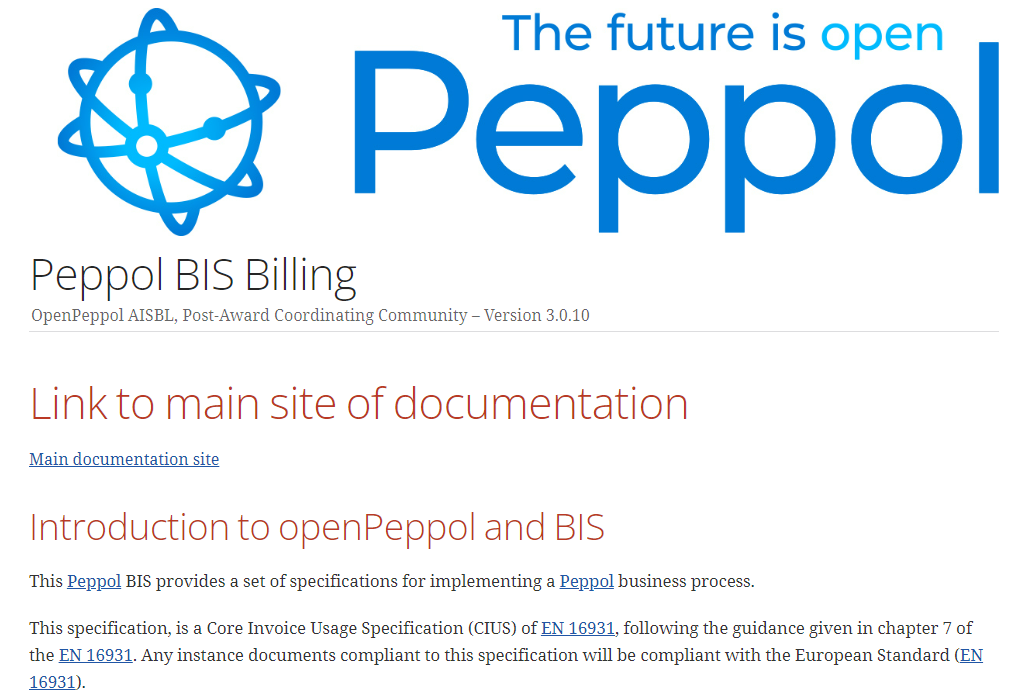
しかし、PINTそのものは、欧州規格 EN 16931に縛られないことを意図しているようです。
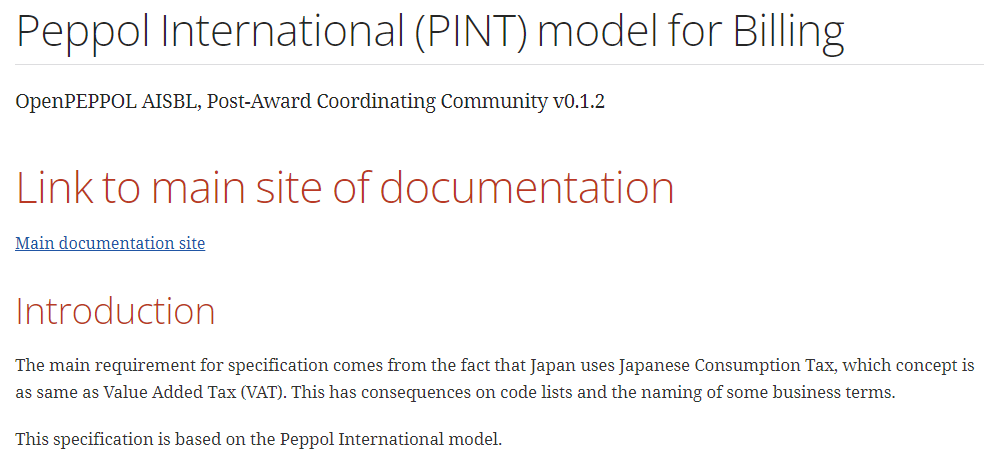
それでは、どのような標準仕様に基づいているのか、ここに書かれている”Peppol International model”を明確に規定している文書が公開されておらず、日本を含めてそれぞれの地域の要請に対してその都度Open Peppolの技術者が対応を模索しているようです。詳しくは、こちらの記事『Open PeppolのPINTは、国際標準ですか』をお読みください。
標準仕様では、その時点での実装仕様が明快に定義されているだけでなく、実装仕様が標準に準拠しているのかが第三者にも客観的に判定できる文書化された枠組みを規定していることが求められます。こうした枠組みが安定していることで、将来にわたって誰が設計しても同じ品質水準の相互運用可能な実装が実現できます。
c. Currency code
UBLでは、金額を記載するXML要素は、その属性に必ず@currencyID属性を指定しなければならないとされています。
デジタルインボイスでは、次の2種類の通貨コードが使えるとされています。どんな場合にどう使い分けるのでしょうか。
ibt-005 Invoice currency code 請求書通貨コード
ibt-006 Tax accounting currency 税会計報告用通貨コード
日本国内の請求書であれば、外貨が記載されていないので全て日本円です。この場合、請求書通貨コードがJPYであり、税会計報告用通貨コードの要素は定義されていません。
海外からのデジタルインボイスの場合、請求書通貨コードが外貨(USDやEURなど)で税会計報告用通貨コードがJPYとなります。この場合、適格請求書でJPYでの金額記載が要請されるのは、税率別の合計税額の項目です。ここで注意すべきは、外貨建てのデジタルインボイスにおいては、JPYでの合計請求金額およびJPYでの税率別の課税対象金額がJP PINTでは記載する項目が定義されていないということです。UBLでも請求書通貨コードでの合計請求金額とともに税会計報告用通貨コードでの合計請求金額を記載できませんので、例えばシンガポールの場合は文字情報項目に税会計報告用通貨コードでの合計請求金額を記載することとしています。日本ではどうすべきでしょうか。
上記の理解でしたが、先日ある方から、「IBT-110とIBT-111のどちらに外貨を記載するのでしょうか」との質問がありました。
これまでは、IBT-110 に外貨(例えばEUR)が記載され、IBT-111には 日本円(JPY)が記載されるものと理解していましたが、
「IBT-111は、売り手の国でのVAT申告の際に求められる通貨単位とされているので、海外からのインボイスでは外貨が記載されるのはこちらではないのでしょうか。」
という質問です。
IBT-110
Invoice total TAX amount
The total TAX amount for the Invoice.IBT-111
Invoice total TAX amount in tax accounting currency
The TAX total amount expressed in the accounting currency accepted or required in the country of the Seller.
BT-111についての定義は、EN 16931-1のビジネス用語の説明でも、BIS Billing 3.0の記載でも同じ
“The TAX total amount expressed in the accounting currency accepted or required in the country of the Seller.”
です。
欧州のVAT申告で売り手の国に申告することもあるようなので、現在確認中です。
従来の解釈をそのまま維持するのであれば、
IBT-111
Invoice total TAX amount in tax accounting currency
The TAX total amount expressed in the accounting currency accepted or required in the country of the BUYER.
としないと間違った定義です。
d. ibt-019 Buyer accounting reference 買い手会計参照
聞き慣れない用語ですが、これは何でしょうか。
A textual value that specifies where to book the relevant data into the Buyer’s financial accounts.
買い手の会計記録に関連データを登録する場所を指定するテキスト値。
欧州規格で確認すると、
BT-19 Buyer accounting reference
Description
A textual value that specifies where to book the relevant data into the Buyer’s financial accounts.Req. ID
R2, R4
UBLの定義では、
The buyer’s accounting code, applied to the Invoice as a whole, expressed as text.
請求書全体に適用される買い手の会計コードで、テキストで表されます。
となっています。
この項目は、買い手の財務勘定科目に関連データを記帳する場所を指定する項目です。買い手のどの勘定に関連データを記帳すべきかを指定するためのテキスト値。調達部門が、購入依頼を発行する際には、その用途が確定しており、購入をどの勘定科目で計上するかも確定していることが多いと思います。デジタルインボイスの採用は、導入企業の経理業務の自動化につながることが期待されています。調達の際に売り手にデジタルインボイスに記帳すべき科目コードが指定できていれば、デジタルインボイスを受け取った後でのワークフローでの自動処理も可能となります。
欧州規格の要求事項で会計に関連するものについては、『EN 16931-1 5.3.2 会計』をご確認ください。
e. ibt-010 Buyer reference 買い手参照
それでは、こちらの項目は何を意味しているのでしょうか。
An identifier assigned by the Buyer used for internal routing purposes.
買い手によって割り当てられたIDで、買い手の請求書精算業務の処理ワークフローで使用する。
という説明があります。
こちらの項目も、買い手企業がどの担当にこのデジタルインボイスを送付するか、その宛先を制御する情報項目です。デジタルインボイスの自動化では、請求内容の確認を誰が行うのかをコンピュータが自動的に振り分けることが大切です。こちらの記事 link:https://www.sambuichi.jp/?p=8230[デジタルインボイス自動処理] もご確認ください。
3. 請求期間
<cac:InvoicePeriod> <!-- IBG-14 INVOICING PERIOD --> <cbc:StartDate>2023-10-18</cbc:StartDate> <!-- IBT-073 Invoicing period start date --> <cbc:EndDate>2023-10-18</cbc:EndDate> <!-- IBT-074 Invoicing period end date --> <!-- cbc:DescriptionCode, IBT-008 TAX point date code --> </cac:InvoicePeriod>
| XPath | 構文での繰返し | 論理モデルでの繰返し | ID | ビジネス用語 |
|---|---|---|---|---|
|
/ Invoice / cac:InvoicePeriod |
0..1 |
0..1 |
ibg-14 |
• INVOICING PERIOD |
|
/ Invoice / cac:InvoicePeriod / cbc:StartDate |
0..1 |
0..1 |
ibt-073 |
• • Invoicing period start date |
|
/ Invoice / cac:InvoicePeriod / cbc:EndDate |
0..1 |
0..1 |
ibt-074 |
• • Invoicing period end date |
4. デジタルインボイスに関係する文書への参照
<cac:OrderReference> <cbc:ID>O-998877</cbc:ID> <!-- IBT-013 Purchase order reference --> <cbc:SalesOrderID>SO-12343</cbc:SalesOrderID> <!-- IBT-014 Sales order reference --> </cac:OrderReference> <cac:BillingReference> <!-- IBG-03 PRECEDING INVOICE REFERENCE --> <cac:InvoiceDocumentReference> <cbc:ID>123</cbc:ID> <!-- IBT-025 Preceding Invoice reference --> <cbc:IssueDate>2023-10-20</cbc:IssueDate> <!-- IBT-026 Preceding Invoice issue date --> </cac:InvoiceDocumentReference> </cac:BillingReference> <cac:DespatchDocumentReference> <cbc:ID>despadv-3</cbc:ID> <!-- IBT-016 Despatch advice reference --> </cac:DespatchDocumentReference> <cac:ReceiptDocumentReference> <cbc:ID>resadv-1</cbc:ID> <!-- IBT-015 Receiving advice reference --> </cac:ReceiptDocumentReference> <cac:ContractDocumentReference> <cbc:ID>framework no 1</cbc:ID> <!-- IBT-012 Contract reference --> </cac:ContractDocumentReference>
| XPath | 構文での繰返し | 論理モデルでの繰返し | ID | ビジネス用語(備考) |
|---|---|---|---|---|
|
/ Invoice / cac:OrderReference |
0..1 |
(ibt-013の親要素。ibt-013を使用しないときには、この親要素を定義しない。) |
||
|
/ Invoice / cac:OrderReference / cbc:ID |
1..1 |
0..1 |
ibt-013 |
• Purchase order reference |
|
/ Invoice / cac:OrderReference / cbc:SalesOrderID |
0..1 |
0..1 |
ibt-014 |
• Sales order reference |
|
/ Invoice / cac:BillingReference |
0..n |
0..n |
ibg-03 |
• PRECEDING INVOICE REFERENCE |
|
/ Invoice / cac:BillingReference / cac:InvoiceDocumentReference |
1..1 |
(ibt-025の親要素) |
||
|
/ Invoice / cac:BillingReference / cac:InvoiceDocumentReference / cbc:ID |
1..1 |
1..1 |
ibt-025 |
• • Preceding Invoice reference |
|
/ Invoice / cac:BillingReference / cac:InvoiceDocumentReference / cbc:IssueDate |
0..1 |
0..1 |
ibt-026 |
• • Preceding Invoice issue date |
|
/ Invoice / cac:DespatchDocumentReference |
0..1 |
(ibt-016の親要素。ibt-016を使用しないときには、この親要素を定義しない。) |
||
|
/ Invoice / cac:DespatchDocumentReference / cbc:ID |
1..1 |
0..1 |
ibt-016 |
• Despatch advice reference |
|
/ Invoice / cac:ReceiptDocumentReference |
0..1 |
(ibt-015の親要素。ibt-015を使用しないときには、この親要素を定義しない。) |
||
|
/ Invoice / cac:ReceiptDocumentReference / cbc:ID |
1..1 |
0..1 |
ibt-015 |
• Receiving advice reference |
|
/ Invoice / cac:ContractDocumentReference |
0..1 |
(ibt-012の親要素。ibt-012を使用しないときには、この親要素を定義しない。) |
||
|
/ Invoice / cac:ContractDocumentReference / cbc:ID |
1..1 |
0..1 |
ibt-012 |
• Contract reference |
この部分には、デジタルインボイスの内容を突き合わせるべき対象の文書がどれかを指定する情報が列挙されています。実際のデジタルインボイスでは、これらの項目のどれが使用されるかは、Open Peppolがサポートしているビジネスプロセスに応じて変わってきます。こちらの記事、デジタルインボイス自動処理 もご確認ください。
5. 文書間の関連とビジネスプロセス
P1 ~ P12およびA.3.3のそれぞれの business process において、デジタルインボイスの根拠となる文書との対応関係が図示されている。
どんな文書と関係しているのか、すなわちどのビジネスプロセスで発行されたデジタルインボイスかに応じでどの項目が記載されていなければいけないのか、逆の観点からは、記載されている項目によってどのビジネスプロセスにおけるデジタルインボイスか判定しても良いのか、先に紹介した Invoice type codeとの関係は、など具体的の事例を想定した検証作業が実用のために不可欠です。
P1 Invoicing of deliveries against purchase orders, based on a contract
P2 Periodic invoicing of deliveries based on a contract, where no purchase order is required
P3 Invoicing the delivery against an incidental purchase order
P4 Pre-payment
P5 Spot payment
P6 Payment in advance of delivery, based on a purchase order
P7 Invoices with references to a despatch advice
P8 Invoices with references to a despatch advice and a receiving advice
P9 Credit Note or negative invoicing
P10 Corrective invoicing
P11 Partial and final invoicing
P12 Self-billing
A.3.3 Factoring
これらの参考文書を参照する識別子は、 EN 16931-1 5.3.3 請求書の確認 で示されているように、それぞれのビジネスプロセスに対してどの情報を確認するか規定されていますので、該当項目を確認してください。
6. 請求するオブジェクトIDおよび添付書類
どちらのビジネス用語もXML要素としては、cac:AdditionalDocumentReference を使用する。
違いは、下位要素の cbc:DocumentTypeCode の値に’130’が指定されているかどうかであり、指定されていれば請求するオブジェクトIDと解釈します。
XPathを使用するとこの違いを明確に定義できます。
/ Invoice / cac:AdditionalDocumentReference [ cbc:DocumentTypeCode = ‘130’ ] は、請求するオブジェクトID
/ Invoice / cac:AdditionalDocumentReference [ not(cbc:DocumentTypeCode = ‘130’) ] は、添付書類
a. 請求するオブジェクトID
<cac:AdditionalDocumentReference> <cbc:ID schemeID="ABT">DR35141</cbc:ID> <!-- IBT-018 Invoiced object identifier, IBT-018-1 The identification scheme identifier of the Invoiced object identifier --> <cbc:DocumentTypeCode>130</cbc:DocumentTypeCode> <!-- IBT-018 qualifier --> </cac:AdditionalDocumentReference>
| XPath | 構文での繰返し | 論理モデルでの繰返し | ID | ビジネス用語 |
|---|---|---|---|---|
|
/ Invoice / cac:AdditionalDocumentReference [ cbc:DocumentTypeCode = ‘130’ ] |
0..n |
|||
|
/ Invoice / cac:AdditionalDocumentReference [ cbc:DocumentTypeCode = ‘130’ ] / cbc:ID |
1..1 |
0..1 |
ibt-018 |
• Invoiced object identifier |
|
/ Invoice / cac:AdditionalDocumentReference [ cbc:DocumentTypeCode = ‘130’ ] / cbc:ID / @schemeID |
0..1 |
0..1 |
ibt-018-1 |
• The identification scheme identifier of the Invoiced object identifier. |
|
/ Invoice / cac:AdditionalDocumentReference [ cbc:DocumentTypeCode = ‘130’ ] / cbc:DocumentTypeCode |
0..1 |
(この cac:AdditionalDocumentReference が請求するオブジェクトIDであることを示す文書タイプコード 130 ) |
このとき、ibt-018-1 The identification scheme identifier of the Invoiced object identifier. 請求するオブジェクトIDのスキーマID の値にどんな値を指定するのかについて次の記述があります。
If it may be not clear for the receiver what scheme is used for the identifier, a conditional scheme identifier should be used that shall be chosen from the UNTDID 1153 code list [6] entries.
この文章は、EN 16931-1の6.3 The semantic modelで定義されているTable 2 — Semantic data model of the core elements of an electronic invoiceのUsage Noteからそのまま引用されており、UNTDID 1153 code list [6]と表現されている[6]は、欧州規格のBibriograpyにある次の文書を参照する番号です。
[6] United Nations Trade Data Interchange Directory (UNTDID)
http://www.unece.org/fileadmin/DAM/trade/untdid/d16b/tred/tredi2.htm
UN/CEFACT code list 1153 D16.B 2016年後半に制定されたコード表ですので、最新版のD22.Bが使えるような表現にするため[6]を削除し、UNTDID 1153 code list としていただきたいものです。
BIS Billing 3.0では、Code listについて節を設けて説明していますが、PINTの記載は宝探しのようで、前提となるEN 16931シリーズやBIS Billing 3.0の知識がないとすぐには見つかりません。

b. 添付書類
<cac:AdditionalDocumentReference> <cbc:ID>doc1</cbc:ID> <!-- IBT-122 Supporting document reference --> <cbc:DocumentDescription>Usage summary</cbc:DocumentDescription> <!-- IBT-123 Supporting document description --> <cac:Attachment> <cbc:EmbeddedDocumentBinaryObject filename="report.csv" mimeCode="text/csv">aHR0cHM6Ly90ZXN0LXZlZmEuZGlmaS5uby9wZXBwb2xiaXMvcG9hY2MvYmlsbGluZy8zLjAvYmlzLw==</cbc:EmbeddedDocumentBinaryObject> <!-- IBT-125 Attached document, IBT-125-1 Attached document Mime code, IBT-125-2 Attached document Filename --> <cac:ExternalReference> <cbc:URI>http://www.salescompany.com/summary001.html</cbc:URI> <!-- IBT-124 External document location --> </cac:ExternalReference> </cac:Attachment> </cac:AdditionalDocumentReference> <cac:AdditionalDocumentReference> <cbc:ID>doc2</cbc:ID> <!-- IBT-122 Supporting document reference --> <cbc:DocumentDescription>Usage breakdown</cbc:DocumentDescription> <!-- IBT-123 Supporting document description --> <cac:Attachment> <cac:ExternalReference> <cbc:URI>http://www.salescompany.com/breakdown001.html</cbc:URI> <!-- IBT-124 External document location --> </cac:ExternalReference> </cac:Attachment> </cac:AdditionalDocumentReference>
| XPath | 構文での繰返し | 論理モデルでの繰返し | ID | ビジネス用語 |
|---|---|---|---|---|
|
/ Invoice / cac:AdditionalDocumentReference [ not(cbc:DocumentTypeCode = ‘130’) ] |
0..n |
0..n |
ibg-24 |
• ADDITIONAL SUPPORTING DOCUMENTS |
|
/ Invoice / cac:AdditionalDocumentReference [ not(cbc:DocumentTypeCode = ‘130’) ] / cbc:ID |
1..1 |
1..1 |
ibt-122 |
• • Supporting document reference |
|
/ Invoice / cac:AdditionalDocumentReference [ not(cbc:DocumentTypeCode = ‘130’) ] / cbc:DocumentDescription |
0..1 |
0..1 |
ibt-123 |
• • Supporting document description |
|
/ Invoice / cac:AdditionalDocumentReference [ not(cbc:DocumentTypeCode = ‘130’) ] / cac:Attachment |
0..1 |
(添付書類 cbc:EmbeddedDocumentBinaryObject の親要素) |
||
|
/ Invoice / cac:AdditionalDocumentReference [ not(cbc:DocumentTypeCode = ‘130’) ] / cac:Attachment / cbc:EmbeddedDocumentBinaryObject |
0..1 |
0..1 |
ibt-125 |
• • Attached document |
|
/ Invoice / cac:AdditionalDocumentReference [ not(cbc:DocumentTypeCode = ‘130’) ] / cac:Attachment / cbc:EmbeddedDocumentBinaryObject /@mimeCode |
0..1 |
0..1 |
ibt-125-1 |
• • • Attached document Mime code |
|
/ Invoice / cac:AdditionalDocumentReference [ not(cbc:DocumentTypeCode = ‘130’) ] / cac:Attachment / cbc:EmbeddedDocumentBinaryObject / @filename |
0..1 |
0..1 |
ibt-125-2 |
• • • Attached document Filename |
|
/ Invoice / cac:AdditionalDocumentReference [ not(cbc:DocumentTypeCode = ‘130’) ] / cac:Attachment / cac:ExternalReference |
0..1 |
(外部ドキュメントのロケーション cbc:URI の親要素) |
||
|
/ Invoice / cac:AdditionalDocumentReference [ not(cbc:DocumentTypeCode = ‘130’) ] / cac:Attachment / cac:ExternalReference / cbc:URI |
1..1 |
0..1 |
ibt-124 |
• • External document location |
添付文書では、Selector条件が not(cbc:DocumentTypeCode = ‘130’) とされているので、文書タイプコードを指定しないか、指定するのであれば 130 以外の値とするのですが、どのコード表を使用するのか明記されていません。
インボイスの文書タイプコードの抽出元になっているUN/CEFACTのコード表 1001には、
130 Invoicing data sheet
Document/message issued within an enterprise containing data about goods sold, to be used as the basis for the preparation of an invoice.50 Validated priced tender
A validated priced tender.
が定義されていますのでこちらのコード表から選択するのが自然だと思われます。
7. 欧州規格 EN 16931-1が規定しているコアインボイスの機能要件
欧州規格制定の背景となった欧州指令2014/55/EU(こちらの記事『電子請求についての欧州指令2014/55/EUとコアインボイス』 参照)では、請求書をデジタル化する標準形式を規定するだけでなく、業務のデジタル化に役立つことも要請されており、欧州規格ではこの要請に対していかに具体化しているかを記載しています。
以下ではその該当部分の翻訳を紹介します。
それぞれの項目の位置づけや用途を理解し日本でのデジテルな業務改善を実現する上でも、日本との違いを把握して活用する上で、欧州における項目定義の背景の理解が重要です。
また、ここで提示されている要件 Rnn は、製品/サービスの開発における総合テストや運用テストのチェックリストとしても活用可能だと思います。
a. EN 16931-1 5.3 請求機能のサポート
EN 16931-1 5.3.1 はじめに
請求書は、多くの関連する (内部) ビジネス プロセスに関連する機能をサポートする場合があります。
コアインボイスモデルは、次の機能をサポートする必要があります。
* 会計;
* 契約書、発注書、納品された商品およびサービスに対する請求書の検証;
* VAT 報告;
* 監査;
* 支払い。
この 5.3 節では、上記の各機能に必要な情報と、それがコアインボイスモデルの範囲内か範囲外かについて評価が行われます。
スコープ内にあり、モデルによってサポートされている機能には、識別子 (R1 など) が割り当てられ、説明が与えられています。
次の機能 (ただし、これらに限定されません) の明示的なサポートは、コアインボイスモデルの範囲外ですが、コアインボイスモデルの情報要素がこれらの機能のサポートを提供する場合があります。
* 在庫管理;
* 配送プロセス;
* 通関;
* マーケティング;
* 報告.
要件識別子は、必ずしも連続していたり、連続していたりする必要はありません。
EN 16931-1 5.3.2 会計
ビジネス トランザクションを組織の帳簿に記録することは、請求書の主な目的の 1 つです。 財務会計のベスト プラクティスと VAT 規則に従って、すべての課税対象者は、VAT が適用され、その適用が税務当局によってチェックされるのに十分な詳細を記録しておく必要があります。 そのため、請求書は、借方側と貸方側の両方で記帳を可能にする文書レベルおよび明細行レベルの情報を提供する必要があります。
コアインボイスモデルの範囲:
R1 売り手と異なる場合、受取人の識別を可能にする文書レベルの情報 (P9 を除くすべてのプロセス)。
R2 借方側と貸方側の両方 (すべてのプロセス) で記帳を可能にするドキュメントレベルの情報。
R3 借方側 (すべてのプロセス) での記帳を可能にする請求明細行レベルの情報。
R4 買い手固有の予約情報 (勘定科目番号) (すべてのプロセス)。
コアインボイスモデルの範囲外:
* 請求書の明細行の下位の明細;
* 明細行の下位の明細行レベルでの予約情報.
EN 16931-1 5.3.3 請求書の確認
このプロセスは、買い手の内部ビジネス管理の一部を形成します。 請求書は、本物の商取引を参照するものとします。 請求書の検証のサポートは、請求書の重要な機能です。
請求書には、関連する既存の文書 (電子または紙など) を検索するのに十分な情報が記載されている必要があります。
* 関連する発注書;
* その契約書;
* 契約の根拠となった入札の募集;
* 買い手の参照;
* 商品またはサービスの受領確認.
請求書には、受領した請求書を、検証と承認のために、責任のある当局、担当者、または部門に転送できるようにするための十分な情報も含まれている必要があります。
コアインボイスモデルの範囲:
R5 文書レベルから 1 つの関連する注文書を突き合わせるための情報 (P2 と P5 を除くすべてのプロセス);
R6 請求書明細から単一の関連する発注書明細を突き合わせるための情報 (P2 と P5 を除くすべてのプロセス);
R7 情報を突き合わせて、単一の契約と、文書レベルからの基本的な入札の呼びかけ (P3 と P5 を除くすべてのプロセス);
R8 買い手が文書レベルで提供する参照 (すべてのプロセス);
R9 文書レベルからの単一の発送通知と突き合わせるための情報 (プロセス P7 および P8);
R10 文書レベルから単一の受領通知と突き合わせるための情報 (プロセス P8);
R11 文書レベルから修正される関連する請求書と突き合わせるための情報 (プロセス P10);
R12 最終請求書からの複数の部分請求書への参照 (プロセス P12);
R13 請求書および関連文書を、検証および承認 (すべてのプロセス) のために、責任のある当局、事業者、個人または部門に転送できるようにするための情報;
R14 請求書明細行レベルでの正味価格と価格の基準となる数量に関する情報。総価格や価格割引などを突き合わせるための情報が追加される場合があります (すべてのプロセス);
R15 文書レベルと請求明細行レベル (すべてのプロセス) の両方での返金と追加請求に関する記述およびコード化された情報;
R16 文書レベル (すべてのプロセス) で明細金額に含まれない、VAT 情報を含む追加請求、(VAT 以外の) 税金、関税、課徴金に関する情報;
R17 料金、(VAT 以外の) 税金、関税、課税額を構成し、個別の請求明細行の単価には含まれない追加請求に関する情報、および適切な識別および/または説明 (すべてのプロセス);
R18 明細金額の一部としての請求書明細行レベルでの追加請求に関する情報 (すべてのプロセス);
R19 文書および請求明細行レベル (すべてのプロセス) での返金と追加請求の金額;
R20 請求明細書レベルでの請求された商品およびサービスのテキストによる説明 (すべてのプロセス);
R21 請求書明細行レベルでの販売者の品目番号による、請求された商品およびサービスの識別 (すべてのプロセス);
R22 請求書明細行レベルでの買い手の品目番号による請求書の商品およびサービスの識別 (すべてのプロセス);
R23 買い手と売り手が合意した請求明細行レベルでの適格な標準品目識別子による、請求された商品およびサービスの識別 (すべてのプロセス);
R24 請求書明細行レベルで売り手と買い手の間で合意された、該当する分類識別子とスキーマ参照による、請求された商品とサービスの分類 (すべてのプロセス);
R25 通常の請求明細行 (すべてのプロセス) として記載されている、返品可能な資産またはパッケージ (パレットなど) およびパッケージ料金についての情報;
R26 通常の請求明細行 (すべてのプロセス) として記載されている、返品可能な資産の料金に関する情報;
R27 返品に関する情報。通常の請求明細行として記載されています (すべてのプロセス);
R28 請求明細行レベルでの商品およびサービスの属性に関する記述情報 (すべてのプロセス);
R29 請求明細行レベルでの商品およびサービスの原産国に関する情報 (すべてのプロセス);
R30 請求書明細行レベルでの請求書明細期間 (プロセス P2、P11);
R31 文書レベルでの 1 つの納入日 (すべてのプロセス);
R32 文書レベルでの 1 つの配送場所または住所 (すべてのプロセス);
R33 文書レベルおよび明細行レベルでの請求オブジェクトの識別 (プロセス P2);
R34 文書レベルでの納入/請求期間 (プロセス P2、P11);
R35 限定された一連のファイル タイプ (すべてのプロセス) の添付ドキュメント;
R36 文書レベルでの複数の添付文書または参照文書 (すべてのプロセス);
R37 請求書明細行レベルでの VAT課税分類と税率 (すべてのプロセス);
R38 文書レベル (すべてのプロセス) での課税分類ごとのVATの合計;
R39 請求明細行レベルでの数量と正味金額 (VAT を除く) (すべてのプロセス);
R40 請求書の合計金額と支払期日を構成する文書レベルおよび請求書明細行レベルのすべての金額 (すべてのプロセス);
R41 売り手が文書レベルで発行した受注書への参照 (すべてのプロセス);
R42 ドキュメントおよび請求書明細行レベルでの手当/手数料率および基本金額 (すべてのプロセス);
R44 受け取った電子請求書の自動検証を可能にするための情報 (すべてのプロセス).
コアインボイスモデルの範囲外:
* 関連する複数の注文書への言及;
* ヘッダー レベルでの 1 つまたは複数の関連する発注書明細への参照;
* 明細行レベルで関連する複数の発注明細への参照;
* 複数の契約への言及;
* 1 つまたは複数の価格表への参照;
* 複数の発送通知書または発送通知への言及;
* 配送の正確な時間への参照;
* 請求書明細行レベルでの 1 つまたは複数の納品書、出荷通知、または発送通知または明細への参照;
* 複数の案内を受けることへの言及;
* 請求書明細行レベルでの 1 つまたは複数の受領通知明細への参照;
* 請求書明細行レベルでのサポート文書への参照;
* 1 つまたは複数の消費レポートまたはパフォーマンス記録への参照;
* 前払いのための 1 つまたは複数の請求書への参照;
* 複数の受注書への参照 (売り手が発行);
* 手当と料金の詳細行;
* 請求された数量と異なる場合、商品およびサービスの納入数量;
* 請求された数量と異なる場合、商品およびサービスの注文数量;
* 請求された数量と異なる場合、商品およびサービスの取り寄せ数量;
* 商品およびサービスのコード化された属性;
* 商品またはサービスの特定のコード化された品質情報;
* 構造化された測定値;
* 商品およびサービスのロット番号(フリーテキストを除く);
* シリアル番号またはその他の識別番号 (サービスを提供する人物など) (フリーテキストを除く);
* 複数の配送への言及;
* 請求明細行レベルでの配送への参照.
EN 16931-1 5.3.4 VAT 報告
欧州とは異なるので省略
EN 16931-1 5.3.5 監査
企業は、内部統制の手段として内部監査するか、法的義務の一環として外部の監査人によって監査される場合があります。
会計は定期的で継続的なプロセスですが、監査は会計が正しく行われたことを確認するための個別のレビュープロセスです。
監査プロセスでは、請求書に特定の情報要件が課されます。
これらの要件は主に、会計取引の真正性と完全性の検証を可能にすることに関連しています。
監査要件は、上記のすべてのプロセスに適用されます。
コアインボイスモデルに準拠した請求書は、次の十分な情報を提供することにより、監査プロセスをサポートします。
* 関連する買い手と売り手の識別;
* 説明、価値、数量を含む、取引された製品およびサービスの識別;
* 請求書を支払いに結び付けるための情報;
* 請求書を契約書や発注書などの関連文書に結び付けるための情報.
コアインボイスモデルの範囲:
R56 以下に関する監査プロセスをサポートするのに十分な情報:
* 請求書の識別;
* 請求書の発行日の識別;
* 説明、価値、数量を含む、取引された製品およびサービスの識別;
* 請求書をその決済に関連付けるための情報;
* 請求書を契約書、発注書、発送通知書などの関連文書に関連付けるための情報;
* 請求書訂正の理由に関する情報 (プロセス P10).
R57 請求書レベルで次の役割を果たす事業者の識別 (正式な名前と住所を含む):
* 売り手 (売り手の商号を含む);
* 買い手;
* 配送先(買い手と異なる場合);
* 受取人(売り手と異なる場合);
* 売り手の税務代理人.
コアインボイスモデルの範囲外:
以下の識別:
* 搬送事業者;
* 債権者(受取人と異なる場合);
* 債務者 (買い手と異なる場合);
* 買い手が発行した、売り手のサービスまたは事業単位の識別;
* 行の一部の小計.
EN 16931-1 5.3.6 支払い
請求書は、支払い請求を表します。
請求書の発行は、支払いが実行される前または後に行われます。支払い前に請求書が発行される場合、それは買い手への支払い要求を表しますが、以前の契約で、または買い手に別途提出された支払い指示によって既に同意されている場合、請求書には通常、債務者の役割で買い手が支払いの転送を正しく開始できるようにするための情報が含まれています。
注文プロセスに支払い指示が含まれていた場合や、クレジットカード、オンラインまたは電話での購入で支払う場合など、支払い後に請求書が発行される場合、請求書には、買い手の請求書と支払いの調整を容易にするために行われた支払いに関する情報が含まれる場合があります。
注文を確認するために前払いが行われる場合など、発行前に請求書の一部が支払われる場合があります。
コアインボイスモデルに準拠した請求書は、請求書の決済のための支払い方法を特定し、要求された支払い額を明確に示す必要があります。
彼らは、ユーロでの支払いのための単一ユーロ支払い地域 (SEPA) および他の通貨のための関連する国内支払い慣行に従って、銀行振込をサポートするために必要な詳細を提供する必要があります。
クレジット転送、口座引き落とし、および支払いカードによる支払いは、コアインボイスモデルに準拠した請求書の支払いの範囲内です。
すべてのプロセスで支払い情報が必要です。
コアインボイスモデルの範囲:
R58 決済手段の識別;
R59 要求された支払期日;
R60 支払期日;
R61 SEPA および国のシステムに従って銀行振込をサポートするために必要な詳細;
R62 支払いに含まれる参照番号と追加の参照データ;
R63 支払いを請求書に関連付けるために、支払いに含まれる参照番号および追加の参照データ;
R64 請求書を決済に使用される支払いカードに関連付けるための情報;
R65 国内取引で使用する国内決済システムをサポートするための基本情報;
R66 前払いされた金額に関する情報;
R67 合計金額がゼロの請求書;
R68 支払う金額がゼロの請求書;
R69 口座引落しをサポートするために必要な詳細;
R70 前払い請求書.
コア請求書モデルの範囲外:
* 分割払い;
* 前払いへの言及;
* 構造化された方法での早期支払い手当;
* 構造化された方法での延滞ペナルティスキーム;
* 引用または参照された体系化された支払い条件.
8. 入札又はロット参照及びプロジェクト参照
<cac:OriginatorDocumentReference> <cbc:ID>ppid-123</cbc:ID> <!-- IBT-017 Tender or lot reference --> </cac:OriginatorDocumentReference> <cac:ProjectReference> <cbc:ID>project333</cbc:ID> <!-- IBT-011 Project reference --> </cac:ProjectReference>
| XPath | 構文での繰返し | 論理モデルでの繰返し | ID | ビジネス用語(備考) |
|---|---|---|---|---|
|
/ Invoice / cac:OriginatorDocumentReference |
0..1 |
(ibt-017の親要素) |
||
|
/ Invoice / cac:OriginatorDocumentReference / cbc:ID |
1..1 |
0..1 |
ibt-017 |
• Tender or lot reference |
|
/ Invoice / cac:ProjectReference |
0..1 |
(ibt-011の親要素) |
||
|
/ Invoice / cac:ProjectReference / cbc:ID |
1..1 |
0..1 |
ibt-011 |
• Project reference |
JP PINT 3.3.7 Project Referenceには次の説明があるだけで、いったい何のプロジェクトについての情報か理解に苦しむところですが、ここでヒントになるのが cbc:DocumentTypeCode=’50’ というSelectorです。
50 Validated priced tender
A validated priced tender.
が定義されていますので、公共調達の入札に関連したプロジェクトのことだと理解できました。
9. 売り手
<cac:AccountingSupplierParty> <!-- IBG-04 SELLER --> <cac:Party> <cbc:EndpointID schemeID="0188">1234567890123</cbc:EndpointID> <!-- IBT-034 Seller electronic address, IBT-034-1 Scheme identifier --> <cac:PartyIdentification> <cbc:ID schemeID="0147">123456:000123:0147:1</cbc:ID> <!-- IBT-029 Seller identifier, IBT-029-1 Scheme identifier --> </cac:PartyIdentification> <cac:PartyName> <cbc:Name>株式会社 〇〇商事</cbc:Name> <!-- IBT-028 Seller trading name --> </cac:PartyName> <cac:PostalAddress> <!-- IBG-05 SELLER POSTAL ADDRESS --> <cbc:StreetName>四谷4-29-X</cbc:StreetName> <!-- IBT-035 Seller address line 1 --> <cbc:AdditionalStreetName>〇〇商事ビル</cbc:AdditionalStreetName> <!-- IBT-036 Seller address line 2 --> <cbc:CityName>新宿区</cbc:CityName> <!-- IBT-037 Seller city --> <cbc:PostalZone>1600044</cbc:PostalZone> <!-- IBT-038 Seller post code --> <cbc:CountrySubentity>東京都</cbc:CountrySubentity> <!-- IBT-039 Seller country subdivision --> <cac:AddressLine> <cbc:Line>Third address line</cbc:Line> <!-- IBT-162 Seller address line 3 --> </cac:AddressLine> <cac:Country> <cbc:IdentificationCode>JP</cbc:IdentificationCode> <!-- IBT-040 Seller country code --> </cac:Country> </cac:PostalAddress> <cac:PartyTaxScheme> <cbc:CompanyID>T1234567890123</cbc:CompanyID> <!-- IBT-031 Seller TAX identifier --> <cac:TaxScheme> <cbc:ID>VAT</cbc:ID> <!-- IBT-031, qualifier --> </cac:TaxScheme> </cac:PartyTaxScheme> <cac:PartyLegalEntity> <cbc:RegistrationName>株式会社 〇〇商事</cbc:RegistrationName> <!-- IBT-027 Seller name --> <cbc:CompanyID schemeID="0188">1234567890123</cbc:CompanyID> <!-- IBT-030 Seller legal registration identifier, IBT-030-1 Scheme identifier --> <cbc:CompanyLegalForm>Private Limited Company</cbc:CompanyLegalForm> <!-- IBT-033 Seller additional legal information --> </cac:PartyLegalEntity> <cac:Contact> <!-- IBG-06 SELLER CONTACT --> <cbc:Name>青木 志郎</cbc:Name> <!-- IBT-041 Seller contact point --> <cbc:Telephone>03-3xxx-0001</cbc:Telephone> <!-- IBT-042 Seller contact telephone number --> <cbc:ElectronicMail>shirou_aoki@〇〇co.jp</cbc:ElectronicMail> <!-- IBT-043 Seller contact email address --> </cac:Contact> </cac:Party> </cac:AccountingSupplierParty>
| XPath | 構文での繰返し | 論理モデルでの繰返し | ID | ビジネス用語 (備考) |
|---|---|---|---|---|
|
/ Invoice / cac:AccountingSupplierParty |
1..1 |
1..1 |
ibg-04 |
• SELLER |
|
/ Invoice / cac:AccountingSupplierParty / cac:Party |
1..1 |
(ibt-034他の親要素) |
||
|
/ Invoice / cac:AccountingSupplierParty / cac:Party / cbc:EndpointID |
1..1 |
1..1 |
ibt-034 |
• • Seller electronic address |
|
/ Invoice / cac:AccountingSupplierParty / cac:Party / cbc:EndpointID / @schemeID |
0..1 |
1..1 |
ibt-034-1 |
• • • Scheme identifier of the Seller electronic address |
|
/ Invoice / cac:AccountingSupplierParty / cac:Party / cac:PartyIdentification [ cbc:ID / @schemeID = ‘SEPA’ ] |
0..n |
(ibt-090の親要素) |
||
|
/ Invoice / cac:AccountingSupplierParty / cac:Party / cac:PartyIdentification / cbc:ID [ @schemeID = ‘SEPA’ ] |
1..1 |
0..1 |
ibt-090 |
• • Bank assigned creditor identifier |
|
/ Invoice / cac:AccountingSupplierParty / cac:Party / cac:PartyIdentification / cbc:ID [ @schemeID = ‘SEPA’ ] / @schemeID |
0..1 |
(固定値 ‘SEPA’) |
||
|
/ Invoice / cac:AccountingSupplierParty / cac:Party / cac:PartyIdentification [ cbc:ID / not( @schemeID = ‘SEPA’ ) ] |
0..n |
(ibt-029の親要素) |
||
|
/ Invoice / cac:AccountingSupplierParty / cac:Party / cac:PartyIdentification / cbc:ID [ not( @schemeID = ‘SEPA’ ) ] |
1..1 |
0..n |
ibt-029 |
• • Seller identifier |
|
/ Invoice / cac:AccountingSupplierParty / cac:Party / cac:PartyIdentification / cbc:ID [ not( @schemeID = ‘SEPA’ ) ] / @schemeID |
0..1 |
0..1 |
ibt-029-1 |
• • • Scheme identifier of the Seller identifier |
|
/ Invoice / cac:AccountingSupplierParty / cac:Party / cac:PartyName |
0..1 |
(ibt-028の親要素) |
||
|
/ Invoice / cac:AccountingSupplierParty / cac:Party / cac:PartyName / cbc:Name |
1..1 |
0..1 |
ibt-028 |
• • Seller trading name |
|
/ Invoice / cac:AccountingSupplierParty / cac:Party / cac:PostalAddress |
1..1 |
1..1 |
ibg-05 |
• • SELLER POSTAL ADDRESS |
|
/ Invoice / cac:AccountingSupplierParty / cac:Party / cac:PostalAddress / cbc:StreetName |
0..1 |
0..1 |
ibt-035 |
• • • Seller address line 1 |
|
/ Invoice / cac:AccountingSupplierParty / cac:Party / cac:PostalAddress / cbc:AdditionalStreetName |
0..1 |
0..1 |
ibt-036 |
• • • Seller address line 2 |
|
/ Invoice / cac:AccountingSupplierParty / cac:Party / cac:PostalAddress / cbc:CityName |
0..1 |
0..1 |
ibt-037 |
• • • Seller city |
|
/ Invoice / cac:AccountingSupplierParty / cac:Party / cac:PostalAddress / cbc:PostalZone |
0..1 |
0..1 |
ibt-038 |
• • • Seller post code |
|
/ Invoice / cac:AccountingSupplierParty / cac:Party / cac:PostalAddress / cbc:CountrySubentity |
0..1 |
0..1 |
ibt-039 |
• • • Seller country subdivision |
|
/ Invoice / cac:AccountingSupplierParty / cac:Party / cac:PostalAddress / cac:AddressLine |
0..1 |
(ibt-162の親要素) |
||
|
/ Invoice / cac:AccountingSupplierParty / cac:Party / cac:PostalAddress / cac:AddressLine / cbc:Line |
1..1 |
0..1 |
ibt-162 |
• • • Seller address line 3 |
|
/ Invoice / cac:AccountingSupplierParty / cac:Party / cac:PostalAddress / cac:Country |
1..1 |
(ibt-040の親要素) |
||
|
/ Invoice / cac:AccountingSupplierParty / cac:Party / cac:PostalAddress / cac:Country / cbc:IdentificationCode |
1..1 |
1..1 |
ibt-040 |
• • • Seller country code |
|
/ Invoice / cac:AccountingSupplierParty / cac:Party / cac:PartyTaxScheme [ cac:TaxScheme / cbc:ID = ‘VAT’ ] |
0..1 |
(ibt-031の親要素) |
||
|
/ Invoice / cac:AccountingSupplierParty / cac:Party / cac:PartyTaxScheme [ cac:TaxScheme / cbc:ID = ‘VAT’ ] / cbc:CompanyID |
0..1 |
0..1 |
ibt-031 |
• • Seller TAX identifier |
|
/ Invoice / cac:AccountingSupplierParty / cac:Party / cac:PartyTaxScheme [ cac:TaxScheme / cbc:ID = ‘VAT’ ] / cac:TaxScheme |
1..1 |
(ibt-031のqualifierの親要素) |
||
|
/ Invoice / cac:AccountingSupplierParty / cac:Party / cac:PartyTaxScheme [ cac:TaxScheme / cbc:ID = ‘VAT’ ] / cac:TaxScheme / cbc:ID |
0..1 |
(ibt-031のqualifier 固定値 ‘VAT’) |
||
|
/ Invoice / cac:AccountingSupplierParty / cac:Party / cac:PartyTaxScheme [ cac:TaxScheme / not( cbc:ID = ‘VAT’ ) ] |
0..1 |
(ibt-032の親要素) |
||
|
/ Invoice / cac:AccountingSupplierParty / cac:Party / cac:PartyTaxScheme [ cac:TaxScheme / not( cbc:ID = ‘VAT’ ) ] / cbc:CompanyID |
0..1 |
0..1 |
ibt-032 |
• • Seller TAX registration identifier |
|
/ Invoice / cac:AccountingSupplierParty / cac:Party / cac:PartyTaxScheme [ cac:TaxScheme / not( cbc:ID = ‘VAT’ ) ] / cac:TaxScheme |
1..1 |
(ibt-032のqualifierの親要素) |
||
|
/ Invoice / cac:AccountingSupplierParty / cac:Party / cac:PartyTaxScheme [ cac:TaxScheme / not( cbc:ID = ‘VAT’ ) ] / cac:TaxScheme / cbc:ID |
0..1 |
(qualifier) |
||
|
/ Invoice / cac:AccountingSupplierParty / cac:Party / cac:PartyLegalEntity |
0..n |
(ibt-027の親要素) |
||
|
/ Invoice / cac:AccountingSupplierParty / cac:Party / cac:PartyLegalEntity / cbc:RegistrationName |
0..1 |
1..1 |
ibt-027 |
• • Seller name |
|
/ Invoice / cac:AccountingSupplierParty / cac:Party / cac:PartyLegalEntity / cbc:CompanyID |
0..1 |
0..1 |
ibt-030 |
• • Seller legal registration identifier |
|
/ Invoice / cac:AccountingSupplierParty / cac:Party / cac:PartyLegalEntity / cbc:CompanyID / @schemeID |
0..1 |
0..1 |
ibt-030-1 |
• • • Scheme identifier of the Seller legal registration identifier |
|
/ Invoice / cac:AccountingSupplierParty / cac:Party / cac:PartyLegalEntity / cbc:CompanyLegalForm |
0..1 |
0..1 |
ibt-033 |
• • Seller additional legal information |
|
/ Invoice / cac:AccountingSupplierParty / cac:Party / cac:Contact |
0..1 |
0..1 |
ibg-06 |
• • SELLER CONTACT |
|
/ Invoice / cac:AccountingSupplierParty / cac:Party / cac:Contact / cbc:Name |
0..1 |
0..1 |
ibt-041 |
• • • Seller contact point |
|
/ Invoice / cac:AccountingSupplierParty / cac:Party / cac:Contact / cbc:Telephone |
0..1 |
0..1 |
ibt-042 |
• • • Seller contact telephone number |
|
/ Invoice / cac:AccountingSupplierParty / cac:Party / cac:Contact / cbc:ElectronicMail |
0..1 |
0..1 |
ibt-043 |
• • • Seller contact email address |
a. 事業者の識別番号
事業者についての識別番号にはつぎのものがあります。
-
ibt-034 Seller electronic address 売り手電子アドレス
/ Invoice / cac:AccountingSupplierParty / cac:Party / cbc:EndpointID -
ibt-029 Seller identifier 売り手ID
/ Invoice / cac:AccountingSupplierParty / cac:Party / cac:PartyIdentification / cbc:ID [ not( @schemeID = ‘SEPA’ ) ] -
ibt-090 Bank assigned creditor identifier 銀行が採番した債権者の識別子
/ Invoice / cac:AccountingSupplierParty / cac:Party / cac:PartyIdentification / cbc:ID [ @schemeID = ‘SEPA’ ] -
ibt-031 Seller TAX identifier 売り手税ID
/ Invoice / cac:AccountingSupplierParty / cac:Party / cac:PartyTaxScheme [ cac:TaxScheme / cbc:ID = ‘VAT’ ] / cbc:CompanyID -
ibt-032 Seller TAX registration identifier 売り手税登録ID
/ Invoice / cac:AccountingSupplierParty / cac:Party / cac:PartyTaxScheme [ cac:TaxScheme / not( cbc:ID = ‘VAT’ ) ] / cbc:CompanyID -
ibt-030 Seller legal registration identifier 売り手法人ID
/ Invoice / cac:AccountingSupplierParty / cac:Party / cac:PartyLegalEntity / cbc:CompanyID
適格請求書では、ibt-031 Seller TAX identifier 売り手税ID が必須項目です。この項目においては、登録事業者番号を発行する組織は選択の余地がありませんので、他の事業者識別番号のように発番機関を指定する @schemeID 属性は必要ありませんが、どの種類の税に関する登録事業者番号なのかを指定するために cac:TaxScheme / cbc:ID を指定しなければいけません。これが VAT であれば、ibt-031を使用し、GSTなどの VAT 以外であれば、ibt-032を使用します。この要素に対応したビジネス要素は定義されていませんので設定もれの内容に注意してください。
また、事業者の識別番号がどの発番機関が発行したものなのかを指定しているのが @schemeID です。
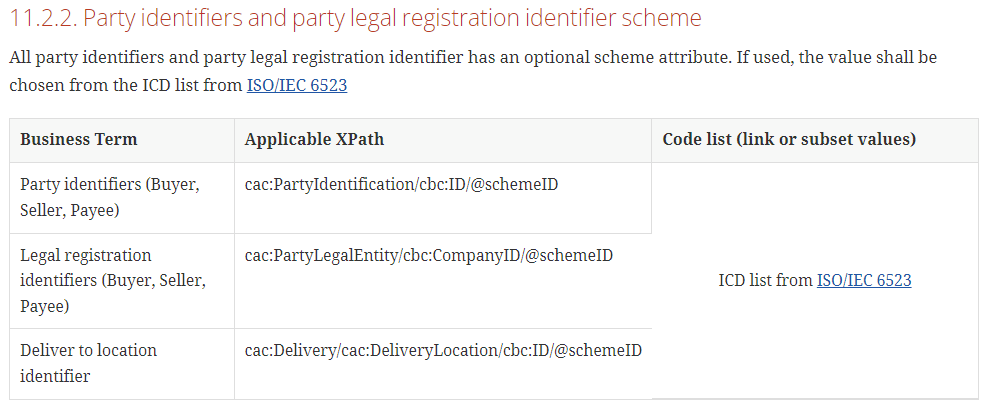
ISO 6523-2の発番機関として登録された組織を指定します。
より詳細なこちらの記事 『Open Peppolの利用者IDの前提となるEASとISO 6523 ICD』 をご確認ください。
ここで、UBL 2.1 が cac:Party要素をどのように定義しているか確認しておきましょう。
<xsd:complexType name="PartyType"> <xsd:sequence> <xsd:element ref="cbc:MarkCareIndicator" minOccurs="0" maxOccurs="1"/> <xsd:element ref="cbc:MarkAttentionIndicator" minOccurs="0" maxOccurs="1"/> <xsd:element ref="cbc:WebsiteURI" minOccurs="0" maxOccurs="1"/> <xsd:element ref="cbc:LogoReferenceID" minOccurs="0" maxOccurs="1"/> <xsd:element ref="cbc:EndpointID" minOccurs="0" maxOccurs="1"/> <xsd:element ref="cbc:IndustryClassificationCode" minOccurs="0" maxOccurs="1"/> <xsd:element ref="cac:PartyIdentification" minOccurs="0" maxOccurs="unbounded"/> <xsd:element ref="cac:PartyName" minOccurs="0" maxOccurs="unbounded"/> <xsd:element ref="cac:Language" minOccurs="0" maxOccurs="1"/> <xsd:element ref="cac:PostalAddress" minOccurs="0" maxOccurs="1"/> <xsd:element ref="cac:PhysicalLocation" minOccurs="0" maxOccurs="1"/> <xsd:element ref="cac:PartyTaxScheme" minOccurs="0" maxOccurs="unbounded"/> <xsd:element ref="cac:PartyLegalEntity" minOccurs="0" maxOccurs="unbounded"/> <xsd:element ref="cac:Contact" minOccurs="0" maxOccurs="1"/> <xsd:element ref="cac:Person" minOccurs="0" maxOccurs="unbounded"/> <xsd:element ref="cac:AgentParty" minOccurs="0" maxOccurs="1"/> <xsd:element ref="cac:ServiceProviderParty" minOccurs="0" maxOccurs="unbounded"/> <xsd:element ref="cac:PowerOfAttorney" minOccurs="0" maxOccurs="unbounded"/> <xsd:element ref="cac:FinancialAccount" minOccurs="0" maxOccurs="1"/> </xsd:sequence> </xsd:complexType>
| Element name | minOccurs | maxOccurs | ID | ビジネス用語 |
|---|---|---|---|---|
|
cbc:EndpointID |
0 |
1 |
ibt-034 |
Seller electronic address |
|
cac:PartyIdentification |
0 |
unbounded |
ibt-029 ibt-090 |
Seller identifier |
|
cac:PartyTaxScheme |
0 |
unbounded |
ibt-031 ibt-032 |
Seller TAX identifier |
|
cac:PartyLegalEntity |
0 |
unbounded |
ibt-030 |
Seller legal registration identifier |
JP PINTが定義している構文バインディングでは、左に論理モデルのビジネス用語、右にUBL構文でのXML要素の定義を記載しています。
ibt-029 Seller identifier 売り手ID のXPathは、
/ Invoice / cac:AccountingSupplierParty / cac:Party / cac:PartyIdentification / cbc:ID [ not( @schemeID = ‘SEPA’ ) ]
ibt-090 Bank assigned creditor identifier 銀行が採番した債権者の識別子 のXPathは、
/ Invoice / cac:AccountingSupplierParty / cac:Party / cac:PartyIdentification / cbc:ID [ @schemeID = ‘SEPA’ ]
ibt-090のときには、@schemeID は固定値 ‘SEPA’ ですので、@schemeIDにBusiness termを定義していません。
この定義表では、<cacPartyTaxScheme>および<cacTaxScheme>の Syntax Cardinality が、UBL 2.1の構文定義とは異なった値で表示されています。正しくは、次のように 1..1 ではなくて 0..1 です。
<cac:PartyTaxScheme>の定義では、/ Invoice / cac:AccountingSupplierParty / cac:Party / cac:PartyTaxScheme / cbc:CompanyID の定義は 0..1 です。
<xsd:complexType name="PartyTaxSchemeType"> <xsd:sequence> <xsd:element ref="cbc:RegistrationName" minOccurs="0" maxOccurs="1"/> <xsd:element ref="cbc:CompanyID" minOccurs="0" maxOccurs="1"/> <xsd:element ref="cbc:TaxLevelCode" minOccurs="0" maxOccurs="1"/> <xsd:element ref="cbc:ExemptionReasonCode" minOccurs="0" maxOccurs="1"/> <xsd:element ref="cbc:ExemptionReason" minOccurs="0" maxOccurs="unbounded"/> <xsd:element ref="cac:RegistrationAddress" minOccurs="0" maxOccurs="1"/> <xsd:element ref="cac:TaxScheme" minOccurs="1" maxOccurs="1"/> </xsd:sequence> </xsd:complexType>
<cac:TaxScheme>の定義では、/ Invoice / cac:AccountingSupplierParty / cac:Party / cac:PartyTaxScheme / cac:TaxScheme / cbc:ID の定義は 0..1 です。
それでは、この定義表のSyntax Cardinality は、何を意図しているのでしょうか。正確に表記するとこの項目は、 Restricted syntax cardinality です。UBLのXMLスキーマで定義している繰り返し回数についての制限情報ではなく、プログラマが業務システムとデジタルインボイスのXMLインスタンス文書の変換処理をコーディングする際に守らなくてはいけない繰り返し回数についての制限情報です。この回数制限に違反しているとスキーマトロンのチェック条件違反が広告されることがあります。
なお、BIS Billing 3.0 では、BISで規定していない項目が使用されているときに警告メッセージが報告されていましたが、JP PINTでは、こうした警告が発行されなくなっていますので、意図しない間違いを含んだデジタルインボイスが送付されてくることもありますので、デジタルインボイスを受け取ったC4での受信データチェックが必要となります。単に無視すれば済むという問題ではなく、何らかの意図で間違った項目にデータが設定されているかもしれませんので、送信元に警告通知すべきでしょう。
<xsd:complexType name="TaxSchemeType"> <xsd:sequence> <xsd:element ref="cbc:ID" minOccurs="0" maxOccurs="1"/> <xsd:element ref="cbc:Name" minOccurs="0" maxOccurs="1"/> <xsd:element ref="cbc:TaxTypeCode" minOccurs="0" maxOccurs="1"/> <xsd:element ref="cbc:CurrencyCode" minOccurs="0" maxOccurs="1"/> <xsd:element ref="cac:JurisdictionRegionAddress" minOccurs="0" maxOccurs="unbounded"/> </xsd:sequence> </xsd:complexType>
また、ibt-031とibt-032を区別する条件として記載されている次の表記は間違いです。訂正したSelector式を次の表で示します。
| ID | 誤ったSelector式 | 正しいelector式 |
|---|---|---|
|
ibt-031 |
[ cac:TaxScheme = ‘VAT’ ] |
[ cac:TaxScheme / cbc:ID = ‘VAT’ ] |
|
ibt-032 |
[ cac:TaxScheme != ‘VAT’ ) ] |
[ cac:TaxScheme / not( cbc:ID = ‘VAT’ ) ] |
b. 住所
ibt-040 Seller country code 売り手国コード だけが必須項目です。住所の文字表記がなくても必要です。
10. 買い手
<cac:AccountingCustomerParty> <!-- IBG-07 BUYER --> <cac:Party> <cbc:EndpointID schemeID="0188">3210987654321</cbc:EndpointID> <!-- IBT-049 Buyer electronic address, IBT-049-1 Scheme identifier --> <cac:PartyIdentification> <cbc:ID schemeID="0147">654321:000321:0147:1</cbc:ID> <!-- IBT-046 Buyer identifier, IBT-046-1 Scheme identifier --> </cac:PartyIdentification> <cac:PartyName> <cbc:Name>株式会社 〇〇物産</cbc:Name> <!-- IBT-045 Buyer trading name --> </cac:PartyName> <cac:PostalAddress> <!-- IBG-08 BUYER POSTAL ADDRESS --> <cbc:StreetName>北区</cbc:StreetName> <!-- IBT-050 Buyer address line 1 --> <cbc:AdditionalStreetName>北十二条西76-X</cbc:AdditionalStreetName> <!-- IBT-051 Buyer address line 2 --> <cbc:CityName>札幌市</cbc:CityName> <!-- IBT-052 Buyer city --> <cbc:PostalZone>0010012</cbc:PostalZone> <!-- IBT-053 Buyer post code --> <cbc:CountrySubentity>北海道</cbc:CountrySubentity> <!-- IBT-054 Buyer country subdivision --> <cac:AddressLine> <cbc:Line>Third line</cbc:Line> <!-- IBT-163 Buyer address line 3 --> </cac:AddressLine> <cac:Country> <cbc:IdentificationCode>JP</cbc:IdentificationCode> <!-- IBT-055 Buyer country code --> </cac:Country> </cac:PostalAddress> <cac:PartyTaxScheme> <cbc:CompanyID>T3210987654321</cbc:CompanyID> <!-- IBT-048 Buyer TAX identifier --> <cac:TaxScheme> <cbc:ID>VAT</cbc:ID> <!-- IBT-048, qualifier --> </cac:TaxScheme> </cac:PartyTaxScheme> <cac:PartyLegalEntity> <cbc:RegistrationName>株式会社 〇〇物産</cbc:RegistrationName> <!-- IBT-044 Buyer name --> <cbc:CompanyID schemeID="0147">654321:000321:0147:1</cbc:CompanyID> <!-- IBT-047 Buyer legal registration identifier, IBT-047-1 Scheme identifier --> </cac:PartyLegalEntity> <cac:Contact> <!-- IBG-09 BUYER CONTACT --> <cbc:Name>株式会社 〇〇物産</cbc:Name> <!-- IBT-056 Buyer contact point --> <cbc:Telephone>011-757-1xxx</cbc:Telephone> <!-- IBT-057 Buyer contact telephone number --> <cbc:ElectronicMail>purchaser@oobussan.co.jp</cbc:ElectronicMail> <!-- IBT-058 Buyer contact email address --> </cac:Contact> </cac:Party>
| XPath | 構文での繰返し | 論理モデルでの繰返し | ID | ビジネス用語 (備考) |
|---|---|---|---|---|
|
/ Invoice / cac:AccountingCustomerParty |
1..1 |
1..1 |
ibg-07 |
• BUYER |
|
/ Invoice / cac:AccountingCustomerParty / cac:Party |
1..1 |
(ibt-049他の親要素) |
||
|
/ Invoice / cac:AccountingCustomerParty / cac:Party / cbc:EndpointID |
1..1 |
1..1 |
ibt-049 |
• • Buyer electronic address |
|
/ Invoice / cac:AccountingCustomerParty / cac:Party / cac:PartyIdentification |
0..1 |
(ibt-046の親要素) |
||
|
/ Invoice / cac:AccountingCustomerParty / cac:Party / cac:PartyIdentification / cbc:ID |
1..1 |
0..1 |
ibt-046 |
• • Buyer identifier |
|
/ Invoice / cac:AccountingCustomerParty / cac:Party / cac:PartyName |
0..1 |
(ibt-045の親要素) |
||
|
/ Invoice / cac:AccountingCustomerParty / cac:Party / cac:PartyName / cbc:Name |
1..1 |
0..1 |
ibt-045 |
• • Buyer trading name |
|
/ Invoice / cac:AccountingCustomerParty / cac:Party / cac:PostalAddress |
1..1 |
1..1 |
ibg-08 |
• • BUYER POSTAL ADDRESS |
|
/ Invoice / cac:AccountingCustomerParty / cac:Party / cac:PostalAddress / cbc:StreetName |
0..1 |
0..1 |
ibt-050 |
• • • Buyer address line 1 |
|
/ Invoice / cac:AccountingCustomerParty / cac:Party / cac:PostalAddress / cbc:AdditionalStreetName |
0..1 |
0..1 |
ibt-051 |
• • • Buyer address line 2 |
|
/ Invoice / cac:AccountingCustomerParty / cac:Party / cac:PostalAddress / cbc:CityName |
0..1 |
0..1 |
ibt-052 |
• • • Buyer city |
|
/ Invoice / cac:AccountingCustomerParty / cac:Party / cac:PostalAddress / cbc:PostalZone |
0..1 |
0..1 |
ibt-053 |
• • • Buyer post code |
|
/ Invoice / cac:AccountingCustomerParty / cac:Party / cac:PostalAddress / cbc:CountrySubentity |
0..1 |
0..1 |
ibt-054 |
• • • Buyer country subdivision |
|
/ Invoice / cac:AccountingCustomerParty / cac:Party / cac:PostalAddress / cac:AddressLine |
0..1 |
(ibt-163の親要素) |
||
|
/ Invoice / cac:AccountingCustomerParty / cac:Party / cac:PostalAddress / cac:AddressLine / cbc:Line |
1..1 |
0..1 |
ibt-163 |
• • • Buyer address line 3 |
|
/ Invoice / cac:AccountingCustomerParty / cac:Party / cac:PostalAddress / cac:Country |
1..1 |
(ibt-055の親要素) |
||
|
/ Invoice / cac:AccountingCustomerParty / cac:Party / cac:PostalAddress / cac:Country / cbc:IdentificationCode |
1..1 |
1..1 |
ibt-055 |
• • • Buyer country code |
|
/ Invoice / cac:AccountingCustomerParty / cac:Party / cac:PartyTaxScheme |
0..1 |
(ibt-048の親要素) |
||
|
/ Invoice / cac:AccountingCustomerParty / cac:Party / cac:PartyTaxScheme / cbc:CompanyID |
1..1 |
0..1 |
ibt-048 |
• • Buyer TAX identifier |
|
/ Invoice / cac:AccountingCustomerParty / cac:Party / cac:PartyTaxScheme / cac:TaxScheme |
1..1 |
(qualifierの親要素) |
||
|
/ Invoice / cac:AccountingCustomerParty / cac:Party / cac:PartyTaxScheme / cac:TaxScheme / cbc:ID |
1..1 |
(qualifier 固定値 ‘VAT’) |
||
|
/ Invoice / cac:AccountingCustomerParty / cac:Party / cac:PartyLegalEntity |
1..1 |
(ibt-044の親要素) |
||
|
/ Invoice / cac:AccountingCustomerParty / cac:Party / cac:PartyLegalEntity / cbc:RegistrationName |
1..1 |
1..1 |
ibt-044 |
• • Buyer name |
|
/ Invoice / cac:AccountingCustomerParty / cac:Party / cac:PartyLegalEntity / cbc:CompanyID |
0..1 |
0..1 |
ibt-047 |
• • Buyer legal registration identifier |
|
/ Invoice / cac:AccountingCustomerParty / cac:Party / cac:Contact |
0..1 |
0..1 |
ibg-09 |
• • BUYER CONTACT |
|
/ Invoice / cac:AccountingCustomerParty / cac:Party / cac:Contact / cbc:Name |
0..1 |
0..1 |
ibt-056 |
• • • Buyer contact point |
|
/ Invoice / cac:AccountingCustomerParty / cac:Party / cac:Contact / cbc:Telephone |
0..1 |
0..1 |
ibt-057 |
• • • Buyer contact telephone number |
|
/ Invoice / cac:AccountingCustomerParty / cac:Party / cac:Contact / cbc:ElectronicMail |
0..1 |
0..1 |
ibt-058 |
• • • Buyer contact email address |
a. 事業者の識別番号
売り手の場合と同様ですが、ibt-046 Buyer identifier 買い手ID についてのqualifier cac:TaxScheme / cbc:ID には、VATを指定する。
b. 住所
ibt-055 Buyer country code 買い手国コード だけが必須項目です。住所の文字表記がなくても必要です。
11. 支払先
<cac:PayeeParty> <!-- IBG-10 PAYEE --> <cac:PartyIdentification> <cbc:ID schemeID="0147">123456:000124:0147:1</cbc:ID> <!-- IBT-060 Payee identifier, IBT-060-1 Scheme identifier, must not be same as ibt-029 --> </cac:PartyIdentification> <cac:PartyName> <cbc:Name>Payee party</cbc:Name> <!-- IBT-059 Payee name, must not be same as ibt-028 --> </cac:PartyName> <cac:PartyLegalEntity> <cbc:CompanyID schemeID="0147">123456:000124:0147:1</cbc:CompanyID> <!-- IBT-061 Payee legal registration identifier, IBT-061-1 Scheme identifier --> </cac:PartyLegalEntity> </cac:PayeeParty>
| XPath | 構文での繰返し | 論理モデルでの繰返し | ID | ビジネス用語 (備考) |
|---|---|---|---|---|
|
/ Invoice / cac:PayeeParty |
0..1 |
0..1 |
ibg-10 |
• PAYEE |
|
/ Invoice / cac:PayeeParty / cac:PartyIdentification |
0..1 |
(ibt-060の親要素) |
||
|
/ Invoice / cac:PayeeParty / cac:PartyIdentification / cbc:ID |
1..1 |
0..1 |
ibt-060 |
• • Payee identifier |
|
/ Invoice / cac:PayeeParty / cac:PartyIdentification / cbc:ID / @schemeID |
0..1 |
0..1 |
ibt-060-1 |
• • Payee identifier Scheme identifier |
|
/ Invoice / cac:PayeeParty / cac:PartyName |
1..1 |
(ibt-059の親要素) |
||
|
/ Invoice / cac:PayeeParty / cac:PartyName / cbc:Name |
1..1 |
1..1 |
ibt-059 |
• • Payee name |
|
/ Invoice / cac:PayeeParty / cac:PartyLegalEntity |
0..1 |
(ibt-061の親要素) |
||
|
/ Invoice / cac:PayeeParty / cac:PartyLegalEntity / cbc:CompanyID |
1..1 |
0..1 |
ibt-061 |
• • Payee legal registration identifier |
買い手とは異なる支払先があるときに使用します。
支払先についてのスキーマトロンのチェックルールは、次のようになっています。
MUST be providedのチェックは、BIS Billing 3.0からそのまま採用されている[ibr-017]のように exists(cac:PartyName/cbc:Name) と exists(テスト条件)関数でチェックします。
[ibr-105] [ibr-106] もMUST be provided なので、exists()関数でチェックしなければいけませんが、count(テスト条件) ⇐ 1 と MUST occur maximum once のチェックです。
これでは、必須項目が定義されていなくても不正を検出できません。
[ibr-sr-19]は、MUST occur maximum once のチェックなので、count(テスト条件) ⇐ 1 で問題ありません。
BIS Billing 3.0 で定義されていなかったルールの品質が悪そうです。
<rule context=”cac:PayeeParty”>
<assert id="ibr-017" flag="fatal" test=" exists(cac:PartyName/cbc:Name) and ( not(cac:PartyName/cbc:Name = ../cac:AccountingSupplierParty/cac:Party/cac:PartyName/cbc:Name) and not(cac:PartyIdentification/cbc:ID = ../cac:AccountingSupplierParty/cac:Party/cac:PartyIdentification/cbc:ID) )"> [ibr-017]-The Payee name (ibt-059) MUST be provided in the Invoice, if the Payee (ibg-10) is different from the Seller (ibg-04).</assert><assert id="ibr-105" flag="fatal" test=" ( count(cac:PartyIdentification/cbc:ID[upper-case(@schemeID) != 'SEPA']) <= 1 ) and ( (cac:PartyName/cbc:Name) != (../cac:AccountingSupplierParty/cac:Party/cac:PartyLegalEntity/cbc:RegistrationName) )"> [ibr-105]-The Payee identifier (ibt-060) MUST be provided in the Invoice, if the Payee (ibg-10) is different from the Seller (ibg-04).</assert><assert id="ibr-106" flag="fatal" test=" ( count(cac:PartyLegalEntity/cbc:CompanyID) <= 1 ) and ( (cac:PartyName/cbc:Name) != (../cac:AccountingSupplierParty/cac:Party/cac:PartyLegalEntity/cbc:RegistrationName) )"> [ibr-106]-The Payee legal identifier (ibt-061) MUST be provided in the Invoice, if the Payee (ibg-10) is different from the Seller (ibg-04).</assert><assert id="ibr-sr-19" flag="fatal" test=" ( count(cac:PartyName/cbc:Name) <= 1 ) and ( (cac:PartyName/cbc:Name) != (../cac:AccountingSupplierParty/cac:Party/cac:PartyLegalEntity/cbc:RegistrationName) )"> [ibr-sr-19]-Payee name MUST occur maximum once, if the Payee is different from the Seller</assert> </rule>
<assert id="ibr-105" flag="fatal" test="
(
exists(cac:PartyIdentification/cbc:ID[upper-case(@schemeID) != 'SEPA'])
) and
(
(cac:PartyName/cbc:Name) !=
(../cac:AccountingSupplierParty/cac:Party/cac:PartyLegalEntity/cbc:RegistrationName)
)">
[ibr-105]-The Payee identifier (ibt-060) MUST be provided in the Invoice, if the Payee (ibg-10) is different from the Seller (ibg-04).</assert>
<assert id="ibr-106" flag="fatal" test="
(
exists(cac:PartyLegalEntity/cbc:CompanyID)
) and
(
(cac:PartyName/cbc:Name) !=
(../cac:AccountingSupplierParty/cac:Party/cac:PartyLegalEntity/cbc:RegistrationName)
)">
[ibr-106]-The Payee legal identifier (ibt-061) MUST be provided in the Invoice, if the Payee (ibg-10) is different from the Seller (ibg-04).</assert>12. 売り手税代理人
<cac:TaxRepresentativeParty> <!-- IBG-11 SELLER TAX REPRESENTATIVE PARTY --> <cac:PartyName> <cbc:Name>TaxRepresentative Name</cbc:Name> <!-- IBT-062 Seller tax representative name --> </cac:PartyName> <cac:PostalAddress> <!-- IBG-12 SELLER TAX REPRESENTATIVE POSTAL ADDRESS --> <cbc:StreetName>四谷4-32-X</cbc:StreetName> <!-- IBT-064 Tax representative address line 1 --> <cbc:AdditionalStreetName>〇〇商事ビル</cbc:AdditionalStreetName> <!-- IBT-065 Tax representative address line 2 --> <cbc:CityName>新宿区</cbc:CityName> <!-- IBT-066 Tax representative city --> <cbc:PostalZone>1600044</cbc:PostalZone> <!-- IBT-067 Tax representative post code --> <cbc:CountrySubentity>東京都</cbc:CountrySubentity> <!-- IBT-068 Tax representative country subdivision --> <cac:AddressLine> <cbc:Line>Third line</cbc:Line> <!-- IBT-164 Tax representative address line 3 --> </cac:AddressLine> <cac:Country> <cbc:IdentificationCode>JP</cbc:IdentificationCode> <!-- IBT-069 Tax representative country code --> </cac:Country> </cac:PostalAddress> <cac:PartyTaxScheme> <cbc:CompanyID>T7654321098765</cbc:CompanyID> <!-- IBT-063 Seller tax representative TAX identifier --> <cac:TaxScheme> <cbc:ID>VAT</cbc:ID> <!-- IBT-063, qualifier --> </cac:TaxScheme> </cac:PartyTaxScheme> </cac:TaxRepresentativeParty>
| XPath | 構文での繰返し | 論理モデルでの繰返し | ID | ビジネス用語 (備考) |
|---|---|---|---|---|
|
/ Invoice / cac:TaxRepresentativeParty |
0..1 |
0..1 |
ibg-11 |
• SELLER TAX REPRESENTATIVE PARTY |
|
/ Invoice / cac:TaxRepresentativeParty / cac:PartyName |
1..1 |
(ibt-062の親要素) |
||
|
/ Invoice / cac:TaxRepresentativeParty / cac:PartyName / cbc:Name |
1..1 |
1..1 |
ibt-062 |
• • Seller tax representative name |
|
/ Invoice / cac:TaxRepresentativeParty / cac:PostalAddress |
1..1 |
1..1 |
ibg-12 |
• • SELLER TAX REPRESENTATIVE POSTAL ADDRESS |
|
/ Invoice / cac:TaxRepresentativeParty / cac:PostalAddress / cbc:StreetName |
0..1 |
0..1 |
ibt-064 |
• • • Tax representative address line 1 |
|
/ Invoice / cac:TaxRepresentativeParty / cac:PostalAddress / cbc:AdditionalStreetName |
0..1 |
0..1 |
ibt-065 |
• • • Tax representative address line 2 |
|
/ Invoice / cac:TaxRepresentativeParty / cac:PostalAddress / cbc:CityName |
0..1 |
0..1 |
ibt-066 |
• • • Tax representative city |
|
/ Invoice / cac:TaxRepresentativeParty / cac:PostalAddress / cbc:PostalZone |
0..1 |
0..1 |
ibt-067 |
• • • Tax representative post code |
|
/ Invoice / cac:TaxRepresentativeParty / cac:PostalAddress / cbc:CountrySubentity |
0..1 |
0..1 |
ibt-068 |
• • • Tax representative country subdivision |
|
/ Invoice / cac:TaxRepresentativeParty / cac:PostalAddress / cac:AddressLine |
0..1 |
(ibt-164の親要素) |
||
|
/ Invoice / cac:TaxRepresentativeParty / cac:PostalAddress / cac:AddressLine / cbc:Line |
1..1 |
0..1 |
ibt-164 |
• • • Tax representative address line 3 |
|
/ Invoice / cac:TaxRepresentativeParty / cac:PostalAddress / cac:Country |
1..1 |
(ibt-069の親要素) |
||
|
/ Invoice / cac:TaxRepresentativeParty / cac:PostalAddress / cac:Country / cbc:IdentificationCode |
1..1 |
1..1 |
ibt-069 |
• • • Tax representative country code |
|
/ Invoice / cac:TaxRepresentativeParty / cac:PartyTaxScheme |
1..1 |
(ibt-063の親要素) |
||
|
/ Invoice / cac:TaxRepresentativeParty / cac:PartyTaxScheme / cbc:CompanyID |
1..1 |
1..1 |
ibt-063 |
• • Seller tax representative TAX identifier |
|
/ Invoice / cac:TaxRepresentativeParty / cac:PartyTaxScheme / cac:TaxScheme |
1..1 |
(qualifierの親要素) |
||
|
/ Invoice / cac:TaxRepresentativeParty / cac:PartyTaxScheme / cac:TaxScheme / cbc:ID |
1..1 |
(qualifier 固定値 ‘VAT’) |
前述した8. 売り手と同様にCardinality 繰り返し回数指定 は、Restricted syntax cardinalityです。XMLスキーマで定義されている繰り返し回数についての制限ではありませんので注意してください。
13. 納入先
<cac:Delivery> <!-- IBG-13 DELIVERY INFORMATION --> <cbc:ActualDeliveryDate>2023-10-18</cbc:ActualDeliveryDate> <!-- IBT-072 Actual delivery date --> <cac:DeliveryLocation> <cbc:ID schemeID="0147">123456:000123:0147:1</cbc:ID> <!-- IBT-071 Deliver to location identifier, IBT-071-1 Scheme identifier --> <cac:Address> <!-- IBG-15 DELIVER TO ADDRESS --> <cbc:StreetName>北区</cbc:StreetName> <!-- IBT-075 Deliver to address line 1 --> <cbc:AdditionalStreetName>北十二条西76-X</cbc:AdditionalStreetName> <!-- IBT-076 Deliver to address line 2 --> <cbc:CityName>札幌市</cbc:CityName> <!-- IBT-077 Deliver to city --> <cbc:PostalZone>0010012</cbc:PostalZone> <!-- IBT-078 Deliver to post code --> <cbc:CountrySubentity>北海道</cbc:CountrySubentity> <!-- IBT-079 Deliver to country subdivision --> <cac:AddressLine> <cbc:Line>Gate 15</cbc:Line> <!-- IBT-165 Deliver to address line 3 --> </cac:AddressLine> <cac:Country> <cbc:IdentificationCode>JP</cbc:IdentificationCode> <!-- IBT-080 Deliver to country code --> </cac:Country> </cac:Address> </cac:DeliveryLocation> <cac:DeliveryParty> <cac:PartyName> <cbc:Name>株式会社 〇〇物産 札幌支社</cbc:Name> <!-- IBT-070 Deliver to party name --> </cac:PartyName> </cac:DeliveryParty> </cac:Delivery>
| XPath | 構文での繰返し | 論理モデルでの繰返し | ID | ビジネス用語 (備考) |
|---|---|---|---|---|
|
/ Invoice / cac:Delivery |
0..1 |
0..1 |
ibg-13 |
• DELIVERY INFORMATION |
|
/ Invoice / cac:Delivery / cbc:ActualDeliveryDate |
0..1 |
0..1 |
ibt-072 |
• • Actual delivery date |
|
/ Invoice / cac:Delivery / cac:DeliveryLocation |
0..1 |
(ibt-071の親要素) |
||
|
/ Invoice / cac:Delivery / cac:DeliveryLocation / cbc:ID |
0..1 |
0..1 |
ibt-071 |
• • Deliver to location identifier |
|
/ Invoice / cac:Delivery / cac:DeliveryLocation / cbc:ID / @schemeID |
0..1 |
0..1 |
ibt-071-1 |
• • Deliver to location identifier Scheme identifier |
|
/ Invoice / cac:Delivery / cac:DeliveryLocation / cac:Address |
0..1 |
0..1 |
ibg-15 |
• • DELIVER TO ADDRESS |
|
/ Invoice / cac:Delivery / cac:DeliveryLocation / cac:Address / cbc:StreetName |
0..1 |
0..1 |
ibt-075 |
• • • Deliver to address line 1 |
|
/ Invoice / cac:Delivery / cac:DeliveryLocation / cac:Address / cbc:AdditionalStreetName |
0..1 |
0..1 |
ibt-076 |
• • • Deliver to address line 2 |
|
/ Invoice / cac:Delivery / cac:DeliveryLocation / cac:Address / cbc:CityName |
0..1 |
0..1 |
ibt-077 |
• • • Deliver to city |
|
/ Invoice / cac:Delivery / cac:DeliveryLocation / cac:Address / cbc:PostalZone |
0..1 |
0..1 |
ibt-078 |
• • • Deliver to post code |
|
/ Invoice / cac:Delivery / cac:DeliveryLocation / cac:Address / cbc:CountrySubentity |
0..1 |
0..1 |
ibt-079 |
• • • Deliver to country subdivision |
|
/ Invoice / cac:Delivery / cac:DeliveryLocation / cac:Address / cac:AddressLine |
0..1 |
(ibt-165の親要素) |
||
|
/ Invoice / cac:Delivery / cac:DeliveryLocation / cac:Address / cac:AddressLine / cbc:Line |
1..1 |
0..1 |
ibt-165 |
• • • Deliver to address line 3 |
|
/ Invoice / cac:Delivery / cac:DeliveryLocation / cac:Address / cac:Country |
1..1 |
(ibt-080の親要素) |
||
|
/ Invoice / cac:Delivery / cac:DeliveryLocation / cac:Address / cac:Country / cbc:IdentificationCode |
1..1 |
1..1 |
ibt-080 |
• • • Deliver to country code |
|
/ Invoice / cac:Delivery / cac:DeliveryParty |
0..1 |
(ibt-070の親要素の親要素) |
||
|
/ Invoice / cac:Delivery / cac:DeliveryParty / cac:PartyName |
1..1 |
(ibt-070の親要素) |
||
|
/ Invoice / cac:Delivery / cac:DeliveryParty / cac:PartyName / cbc:Name |
1..1 |
0..1 |
ibt-070 |
• • Deliver to party name |
ibt-071 Deliver to location identifier 納入先IDに使用する配送場所のID(識別番号)は、ibt-071-1 Deliver to location identifier Scheme identifier スキーマID で指定する発番機関が発行したものとされており、発番機関は ISO 6523-2のICDでなければなりません。
ISO 6523 ICDについては、次の記事『Open Peppolの利用者IDの前提となるEASとISO 6523 ICD』をご確認ください。Open Peppolで利用可能なICDについて記載しています。
14. 支払指示
Japan PINT Invoice UBL Example.xmlでは、銀行振込の例が記載されています。
<cac:PaymentMeans> <!-- IBG-16 PAYMENT INSTRUCTIONS --> <!-- cbc:ID, IBT-178 Payment Instructions ID --> <cbc:PaymentMeansCode name="Credit transfer">30</cbc:PaymentMeansCode> <!-- IBT-081 Payment means type code, IBT-082 Payment means text --> <!-- cbc:PaymentID, IBT-083 Remittance information --> <!-- cac:CardAccount, IBG-18 PAYMENT CARD INFORMATION --> <cac:PayeeFinancialAccount> <!-- IBG-17 CREDIT TRANSFER --> <cbc:ID>1234:567:1:3242394</cbc:ID> <!-- IBT-084 Payment account identifier, IBT-084-1 Scheme identifier --> <cbc:Name>カ)マルマルシヨウジ</cbc:Name> <!-- IBT-085 Payment account name --> <!-- cac:FinancialInstitutionBranch, cbc:ID, IBT-086 Payment service provider identifier --> <!-- cac:FinancialInstitutionBranch, cac:PostalAddress, IBG-34 FINANCIAL INSTITUTION ADDRESS --> </cac:PayeeFinancialAccount> <!-- cac:PaymentMandate, IBG-19 DIRECT DEBIT --> </cac:PaymentMeans>
JP PINTで定義されている支払指示は、次の3種類です。
-
ibg-18 PAYMENT CARD INFORMATION 支払カード情報
-
ibg-17 CREDIT TRANSFER銀行振込
-
ibg-19 DIRECT DEBIT 自動口座引落
| XPath | 構文での繰返し | 論理モデルでの繰返し | ID | ビジネス用語 (備考) |
|---|---|---|---|---|
|
/ Invoice / cac:PaymentMeans |
0..n |
0..n |
ibg-16 |
• PAYMENT INSTRUCTIONS |
|
/ Invoice / cac:PaymentMeans / cbc:ID |
0..1 |
0..1 |
ibt-178 |
• • Payment Instructions ID |
|
/ Invoice / cac:PaymentMeans / cbc:PaymentMeansCode |
1..1 |
1..1 |
ibt-081 |
• • Payment means type code |
|
/ Invoice / cac:PaymentMeans / cbc:PaymentMeansCode / @name |
0..1 |
0..1 |
ibt-082 |
• • Payment means text |
|
/ Invoice / cac:PaymentMeans / cbc:PaymentID |
0..n |
0..n |
ibt-083 |
• • Remittance information |
|
/ Invoice / cac:PaymentMeans / cac:CardAccount |
0..1 |
0..1 |
ibg-18 |
• • PAYMENT CARD INFORMATION |
|
/ Invoice / cac:PaymentMeans / cac:PayeeFinancialAccount |
0..1 |
0..1 |
ibg-17 |
• • CREDIT TRANSFER |
|
/ Invoice / cac:PaymentMeans / cac:PayeeFinancialAccount / cac:FinancialInstitutionBranch / cac:Address |
0..1 |
0..1 |
ibg-34 |
• • FINANCIAL INSTITUTION ADDRESS |
|
/ Invoice / cac:PaymentMeans / cac:PaymentMandate |
0..1 |
0..1 |
ibg-19 |
• • DIRECT DEBIT |
a. 支払手段についてのコード
支払手段についてのコードが2種類あります。JP PINTでは、それぞれ次の説明があります。
ibt-081 Payment means type code 支払手段タイプコード
The means, expressed as code, for how a payment is expected to be or has been settled.ibt-178 Payment Instructions ID 支払指示ID
An identifier for the payment instructions.
Peppol Specifications for Japan implementation of PINT
が、この文章だけではどのようなコードが使用できるか分かりません。
そこで、Code lists のページをよく見ると、Payment means codeが見つかりました。Payment means type code と近い単語なのでこれではないかと確認してみます(英語のネイティブには、違いが意識できないようです)。
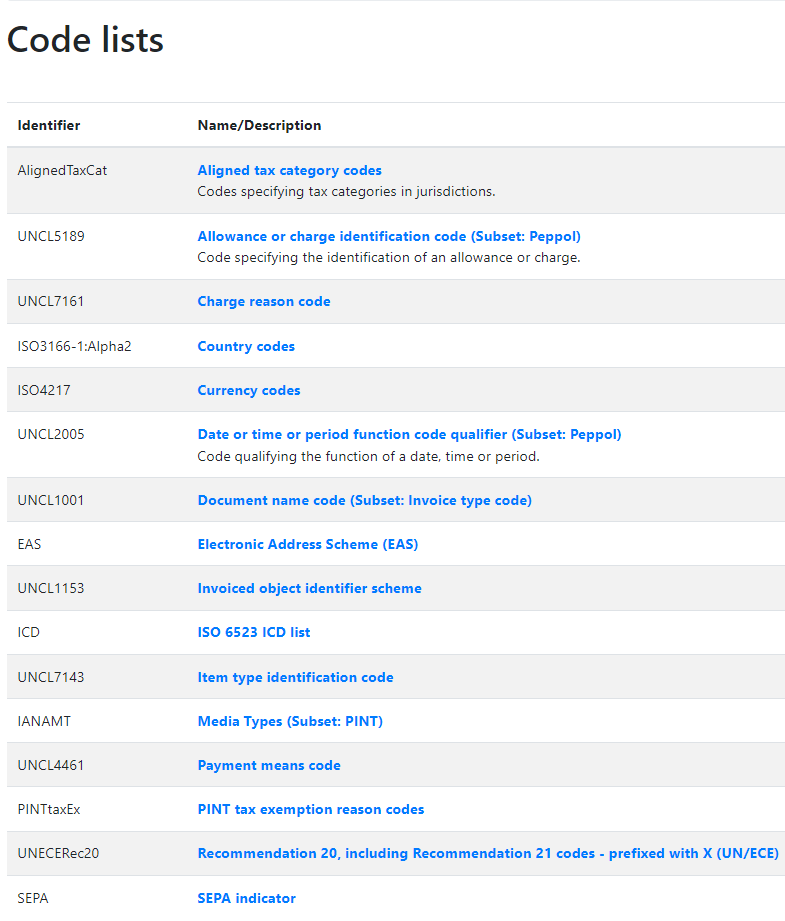
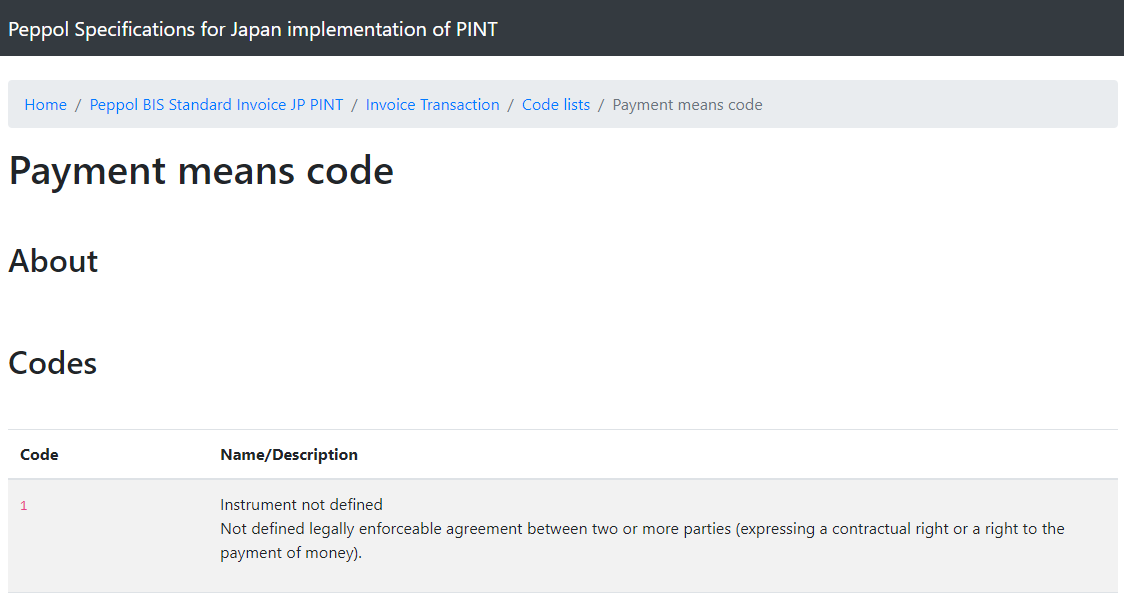
このページで一覧表示されているコードには、Identifier UNCL4461と表記されていますが、よく分かりません。
そこでで BIS Billing 3.0の説明を確認してみます。
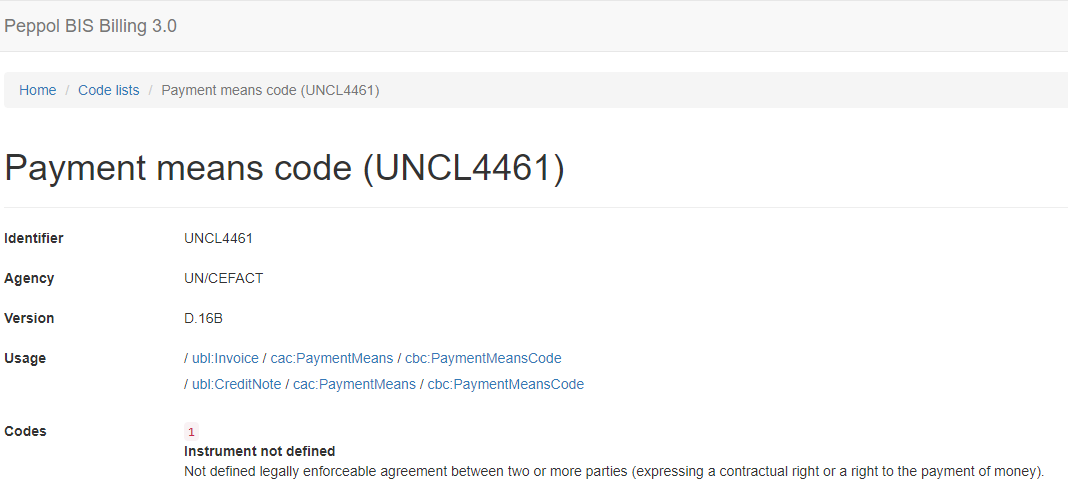
ようやくコードを発行している機関が UN/CEFACTで、コードのバージョンがD.16Bだと分かります。UNCL 4461 のページは、次の内容です。

30 Credit transfer
Payment by credit movement of funds from one account to another.
ibt-082 Payment means text 支払手段内容説明 を使用するとコードだけでなく文章での説明も記載できます。
@name Payment means text
A textual description of the means/methods by which the payment is expected to be or has been settled
Peppol Specifications for Japan implementation of PINT
残念ながら、ibt-178 Payment Instructions ID 支払指示ID については、PINTで新たに追加されたビジネス用語のようですが、どの機関が発行するどういった趣旨のコード表か全くわかりません。
b. 入金消込
デジタルインボイスとZEDIなどの銀行振込のデータ連携では、次の項目 ibt-083 Remittance information 送金情報 も重要です。
次の記事 link:https://www.sambuichi.jp/?p=8230『デジタルインボイス自動処理』 もご確認ください。
Remittance information
A textual value used for payment routing or to establish a link between the payment and the Invoice.
Peppol Specifications for Japan implementation of PINT
c. 支払カード情報
| XPath | 構文での繰返し | 論理モデルでの繰返し | ID | ビジネス用語 (備考) |
|---|---|---|---|---|
|
/ Invoice / cac:PaymentMeans / cac:CardAccount |
0..1 |
0..1 |
ibg-18 |
• • PAYMENT CARD INFORMATION |
|
/ Invoice / cac:PaymentMeans / cac:CardAccount / cbc:PrimaryAccountNumberID |
1..1 |
1..1 |
ibt-087 |
• • • Payment card primary account number |
|
/ Invoice / cac:PaymentMeans / cac:CardAccount / cbc:NetworkID |
1..1 |
(カード発行会社) |
||
|
/ Invoice / cac:PaymentMeans / cac:CardAccount / cbc:HolderName |
0..1 |
0..1 |
ibt-088 |
• • • Payment card holder name |
ibt-087 Payment card primary account number 支払カード番号の説明は、次の通りですが、
Payment card primary account number
The Primary Account Number (PAN) of the card used for payment.
Peppol Specifications for Japan implementation of PINT
EN 16931-1 の Usage Note では、次の説明があります。
In accordance with card payments security standards an invoice should never include a full card primary account number. At the moment PCI Security Standards Council has defined that the first 6 digits and last 4 digits are the maximum number of digits to be shown.
カード決済のセキュリティ基準に従い、請求書に完全なカード番号を含めてはなりません。 現在、PCI Security Standards Council は、最初の 6 桁と最後の 4 桁が最大表示桁数であると定義しています。
スキーマトロンでも、次のようなチェックが Alignedルールで定義されていますので、カード番号をすべて含まないようにしてください。このビジネス用語は、前払いですでに代金が支払われているビジネスプロセス P4 に対応しています。
<rule context="cac:PaymentMeans/cac:CardAccount"> <assert id="aligned-ibrp-017" flag="fatal" test="string-length(cbc:PrimaryAccountNumberID)>=4 and string-length(cbc:PrimaryAccountNumberID)<=6">[aligned-ibrp-017]-The last 4 to 6 digits of the Payment card primary account number (ibt-87) MUST be present if Payment card information (ibg-18) is provided in the Invoice.</assert> </rule>
メッセージの一部がEN 16931-1からの転記ミスか”the first 6 digits and last 4 digits”でなく”The last 4 to 6 digit”となっています。
なお、ビジネス用語が定義されていませんが、cbc:NetworkID(カード発行会社)は、UBL 2.1では必須項目なので、この要素を定義しないとXMLスキーマ検証エラーとなってデジタルインボイスが送信できませんので注意してください。
<xsd:complexType name="CardAccountType"> <xsd:annotation> <xsd:documentation> <ccts:Component> <ccts:ComponentType>ABIE</ccts:ComponentType> <ccts:DictionaryEntryName>Card Account. Details</ccts:DictionaryEntryName> <ccts:Definition>A class to define a credit card, debit card, or charge card account.</ccts:Definition> <ccts:ObjectClass>Card Account</ccts:ObjectClass> </ccts:Component> </xsd:documentation> </xsd:annotation> <xsd:sequence> <xsd:element ref="cbc:PrimaryAccountNumberID" minOccurs="1" maxOccurs="1"> <xsd:annotation> <xsd:documentation> <ccts:Component> <ccts:ComponentType>BBIE</ccts:ComponentType> <ccts:DictionaryEntryName>Card Account. Primary_ Account Number. Identifier</ccts:DictionaryEntryName> <ccts:Definition>An identifier of the card (e.g., the Primary Account Number (PAN)).</ccts:Definition> <ccts:Cardinality>1</ccts:Cardinality> <ccts:ObjectClass>Card Account</ccts:ObjectClass> <ccts:PropertyTermQualifier>Primary</ccts:PropertyTermQualifier> <ccts:PropertyTerm>Account Number</ccts:PropertyTerm> <ccts:RepresentationTerm>Identifier</ccts:RepresentationTerm> <ccts:DataType>Identifier. Type</ccts:DataType> <ccts:Examples>4558 XXXX XXXX XXXX (a real card number)</ccts:Examples> </ccts:Component> </xsd:documentation> </xsd:annotation> </xsd:element> <xsd:element ref="cbc:NetworkID" minOccurs="1" maxOccurs="1"> <xsd:annotation> <xsd:documentation> <ccts:Component> <ccts:ComponentType>BBIE</ccts:ComponentType> <ccts:DictionaryEntryName>Card Account. Network. Identifier</ccts:DictionaryEntryName> <ccts:Definition>An identifier for the financial service network provider of the card.</ccts:Definition> <ccts:Cardinality>1</ccts:Cardinality> <ccts:ObjectClass>Card Account</ccts:ObjectClass> <ccts:PropertyTerm>Network</ccts:PropertyTerm> <ccts:RepresentationTerm>Identifier</ccts:RepresentationTerm> <ccts:DataType>Identifier. Type</ccts:DataType> <ccts:Examples>VISA, MasterCard, American Express</ccts:Examples> </ccts:Component> </xsd:documentation> </xsd:annotation> </xsd:element> <xsd:element ref="cbc:CardTypeCode" minOccurs="0" maxOccurs="1"> <xsd:annotation> <xsd:documentation> <ccts:Component> <ccts:ComponentType>BBIE</ccts:ComponentType> <ccts:DictionaryEntryName>Card Account. Card Type Code. Code</ccts:DictionaryEntryName> <ccts:Definition>A mutually agreed code signifying the type of card. Examples of types are "debit", "credit" and "purchasing"</ccts:Definition> <ccts:Cardinality>0..1</ccts:Cardinality> <ccts:ObjectClass>Card Account</ccts:ObjectClass> <ccts:PropertyTerm>Card Type Code</ccts:PropertyTerm> <ccts:RepresentationTerm>Code</ccts:RepresentationTerm> <ccts:DataType>Code. Type</ccts:DataType> <ccts:Examples>Debit Card, Credit Card, Procurement Card</ccts:Examples> </ccts:Component> </xsd:documentation> </xsd:annotation> </xsd:element> <xsd:element ref="cbc:ValidityStartDate" minOccurs="0" maxOccurs="1"> <xsd:annotation> <xsd:documentation> <ccts:Component> <ccts:ComponentType>BBIE</ccts:ComponentType> <ccts:DictionaryEntryName>Card Account. Validity Start Date. Date</ccts:DictionaryEntryName> <ccts:Definition>The date from which the card is valid.</ccts:Definition> <ccts:Cardinality>0..1</ccts:Cardinality> <ccts:ObjectClass>Card Account</ccts:ObjectClass> <ccts:PropertyTerm>Validity Start Date</ccts:PropertyTerm> <ccts:RepresentationTerm>Date</ccts:RepresentationTerm> <ccts:DataType>Date. Type</ccts:DataType> </ccts:Component> </xsd:documentation> </xsd:annotation> </xsd:element> <xsd:element ref="cbc:ExpiryDate" minOccurs="0" maxOccurs="1"> <xsd:annotation> <xsd:documentation> <ccts:Component> <ccts:ComponentType>BBIE</ccts:ComponentType> <ccts:DictionaryEntryName>Card Account. Expiry Date. Date</ccts:DictionaryEntryName> <ccts:Definition>The date on which the card expires.</ccts:Definition> <ccts:Cardinality>0..1</ccts:Cardinality> <ccts:ObjectClass>Card Account</ccts:ObjectClass> <ccts:PropertyTerm>Expiry Date</ccts:PropertyTerm> <ccts:RepresentationTerm>Date</ccts:RepresentationTerm> <ccts:DataType>Date. Type</ccts:DataType> </ccts:Component> </xsd:documentation> </xsd:annotation> </xsd:element> <xsd:element ref="cbc:IssuerID" minOccurs="0" maxOccurs="1"> <xsd:annotation> <xsd:documentation> <ccts:Component> <ccts:ComponentType>BBIE</ccts:ComponentType> <ccts:DictionaryEntryName>Card Account. Issuer. Identifier</ccts:DictionaryEntryName> <ccts:Definition>An identifier for the institution issuing the card.</ccts:Definition> <ccts:Cardinality>0..1</ccts:Cardinality> <ccts:ObjectClass>Card Account</ccts:ObjectClass> <ccts:PropertyTerm>Issuer</ccts:PropertyTerm> <ccts:RepresentationTerm>Identifier</ccts:RepresentationTerm> <ccts:DataType>Identifier. Type</ccts:DataType> </ccts:Component> </xsd:documentation> </xsd:annotation> </xsd:element> <xsd:element ref="cbc:IssueNumberID" minOccurs="0" maxOccurs="1"> <xsd:annotation> <xsd:documentation> <ccts:Component> <ccts:ComponentType>BBIE</ccts:ComponentType> <ccts:DictionaryEntryName>Card Account. Issue Number. Identifier</ccts:DictionaryEntryName> <ccts:Definition>An identifier for the card, specified by the issuer.</ccts:Definition> <ccts:Cardinality>0..1</ccts:Cardinality> <ccts:ObjectClass>Card Account</ccts:ObjectClass> <ccts:PropertyTerm>Issue Number</ccts:PropertyTerm> <ccts:RepresentationTerm>Identifier</ccts:RepresentationTerm> <ccts:DataType>Identifier. Type</ccts:DataType> </ccts:Component> </xsd:documentation> </xsd:annotation> </xsd:element> <xsd:element ref="cbc:CV2ID" minOccurs="0" maxOccurs="1"> <xsd:annotation> <xsd:documentation> <ccts:Component> <ccts:ComponentType>BBIE</ccts:ComponentType> <ccts:DictionaryEntryName>Card Account. CV2. Identifier</ccts:DictionaryEntryName> <ccts:Definition>An identifier for the Card Verification Value (often found on the reverse of the card itself).</ccts:Definition> <ccts:Cardinality>0..1</ccts:Cardinality> <ccts:ObjectClass>Card Account</ccts:ObjectClass> <ccts:PropertyTerm>CV2</ccts:PropertyTerm> <ccts:RepresentationTerm>Identifier</ccts:RepresentationTerm> <ccts:DataType>Identifier. Type</ccts:DataType> </ccts:Component> </xsd:documentation> </xsd:annotation> </xsd:element> <xsd:element ref="cbc:CardChipCode" minOccurs="0" maxOccurs="1"> <xsd:annotation> <xsd:documentation> <ccts:Component> <ccts:ComponentType>BBIE</ccts:ComponentType> <ccts:DictionaryEntryName>Card Account. Card Chip Code. Code</ccts:DictionaryEntryName> <ccts:Definition>A mutually agreed code to distinguish between CHIP and MAG STRIPE cards.</ccts:Definition> <ccts:Cardinality>0..1</ccts:Cardinality> <ccts:ObjectClass>Card Account</ccts:ObjectClass> <ccts:PropertyTerm>Card Chip Code</ccts:PropertyTerm> <ccts:RepresentationTerm>Code</ccts:RepresentationTerm> <ccts:DataTypeQualifier>Chip</ccts:DataTypeQualifier> <ccts:DataType>Chip_ Code. Type</ccts:DataType> </ccts:Component> </xsd:documentation> </xsd:annotation> </xsd:element> <xsd:element ref="cbc:ChipApplicationID" minOccurs="0" maxOccurs="1"> <xsd:annotation> <xsd:documentation> <ccts:Component> <ccts:ComponentType>BBIE</ccts:ComponentType> <ccts:DictionaryEntryName>Card Account. Chip_ Application. Identifier</ccts:DictionaryEntryName> <ccts:Definition>An identifier on the chip card for the application that provides the quoted information; an AID (application ID).</ccts:Definition> <ccts:Cardinality>0..1</ccts:Cardinality> <ccts:ObjectClass>Card Account</ccts:ObjectClass> <ccts:PropertyTermQualifier>Chip</ccts:PropertyTermQualifier> <ccts:PropertyTerm>Application</ccts:PropertyTerm> <ccts:RepresentationTerm>Identifier</ccts:RepresentationTerm> <ccts:DataType>Identifier. Type</ccts:DataType> </ccts:Component> </xsd:documentation> </xsd:annotation> </xsd:element> <xsd:element ref="cbc:HolderName" minOccurs="0" maxOccurs="1"> <xsd:annotation> <xsd:documentation> <ccts:Component> <ccts:ComponentType>BBIE</ccts:ComponentType> <ccts:DictionaryEntryName>Card Account. Holder. Name</ccts:DictionaryEntryName> <ccts:Definition>The name of the cardholder.</ccts:Definition> <ccts:Cardinality>0..1</ccts:Cardinality> <ccts:ObjectClass>Card Account</ccts:ObjectClass> <ccts:PropertyTerm>Holder</ccts:PropertyTerm> <ccts:RepresentationTerm>Name</ccts:RepresentationTerm> <ccts:DataType>Name. Type</ccts:DataType> </ccts:Component> </xsd:documentation> </xsd:annotation> </xsd:element> </xsd:sequence> </xsd:complexType>
d. 銀行振込
| XPath | 構文での繰返し | 論理モデルでの繰返し | ID | ビジネス用語 (備考) |
|---|---|---|---|---|
|
/ Invoice / cac:PaymentMeans / cac:PayeeFinancialAccount |
0..1 |
0..1 |
ibg-17 |
• • CREDIT TRANSFER |
|
/ Invoice / cac:PaymentMeans / cac:PayeeFinancialAccount / cbc:ID |
1..1 |
1..1 |
ibt-084 |
• • • Payment account identifier |
|
/ Invoice / cac:PaymentMeans / cac:PayeeFinancialAccount / cbc:ID / @schemeID |
0..1 |
0..1 |
ibt-084-1 |
• • • Payment account identifier Scheme identifier |
|
/ Invoice / cac:PaymentMeans / cac:PayeeFinancialAccount / cbc:Name |
0..1 |
0..1 |
ibt-085 |
• • • Payment account name |
|
/ Invoice / cac:PaymentMeans / cac:PayeeFinancialAccount / cac:FinancialInstitutionBranch |
0..1 |
(ibt-086の親要素) |
||
|
/ Invoice / cac:PaymentMeans / cac:PayeeFinancialAccount / cac:FinancialInstitutionBranch / cbc:ID |
1..1 |
0..1 |
ibt-086 |
• • • Payment service provider identifier |
|
/ Invoice / cac:PaymentMeans / cac:PayeeFinancialAccount / cac:FinancialInstitutionBranch / cac:Address |
0..1 |
0..1 |
ibg-34 |
• • FINANCIAL INSTITUTION ADDRESS |
|
/ Invoice / cac:PaymentMeans / cac:PayeeFinancialAccount / cac:FinancialInstitutionBranch / cac:Address / cbc:StreetName |
0..1 |
0..1 |
ibt-169 |
• • • Account address line 1 |
|
/ Invoice / cac:PaymentMeans / cac:PayeeFinancialAccount / cac:FinancialInstitutionBranch / cac:Address / cbc:AdditionalStreetName |
0..1 |
0..1 |
ibt-170 |
• • • Account address line 2 |
|
/ Invoice / cac:PaymentMeans / cac:PayeeFinancialAccount / cac:FinancialInstitutionBranch / cac:Address / cbc:CityName |
0..1 |
0..1 |
ibt-171 |
• • • Account city |
|
/ Invoice / cac:PaymentMeans / cac:PayeeFinancialAccount / cac:FinancialInstitutionBranch / cac:Address / cbc:PostalZone |
0..1 |
0..1 |
ibt-172 |
• • • Account post code |
|
/ Invoice / cac:PaymentMeans / cac:PayeeFinancialAccount / cac:FinancialInstitutionBranch / cac:Address / cbc:CountrySubentity |
0..1 |
0..1 |
ibt-173 |
• • • Account country subdivision |
|
/ Invoice / cac:PaymentMeans / cac:PayeeFinancialAccount / cac:FinancialInstitutionBranch / cac:Address / cac:AddressLine |
0..1 |
(ibt-174の親要素) |
||
|
/ Invoice / cac:PaymentMeans / cac:PayeeFinancialAccount / cac:FinancialInstitutionBranch / cac:Address / cac:AddressLine / cbc:Line |
1..1 |
0..1 |
ibt-174 |
• • • Account address line 3 |
|
/ Invoice / cac:PaymentMeans / cac:PayeeFinancialAccount / cac:FinancialInstitutionBranch / cac:Address / cac:Country |
0..1 |
(ibt-175の親要素) |
||
|
/ Invoice / cac:PaymentMeans / cac:PayeeFinancialAccount / cac:FinancialInstitutionBranch / cac:Address / cac:Country / cbc:IdentificationCode |
1..1 |
0..1 |
ibt-175 |
• • • Account country code |
ibt-084 Payment account identifier 支払先口座ID に支払先の口座番号を
ibt-085 Payment account name 支払先口座名義人名 に半角カタカナで記載します。
その他の項目は、通常使用しません。
e. 自動口座引落
| XPath | 構文での繰返し | 論理モデルでの繰返し | ID | ビジネス用語 (備考) |
|---|---|---|---|---|
|
/ Invoice / cac:PaymentMeans / cac:PaymentMandate |
0..1 |
0..1 |
ibg-19 |
• • DIRECT DEBIT |
|
/ Invoice / cac:PaymentMeans / cac:PaymentMandate / cbc:ID |
0..1 |
0..1 |
ibt-089 |
• • • Mandate reference identifier |
|
/ Invoice / cac:PaymentMeans / cac:PaymentMandate / cac:PayerFinancialAccount |
0..1 |
(ibt-091の親要素) |
||
|
/ Invoice / cac:PaymentMeans / cac:PaymentMandate / cac:PayerFinancialAccount / cbc:ID |
1..1 |
0..1 |
ibt-091 |
• • • Debited account identifier |
f. 支払手段の拡張
UBL 2.1では、cac:PaymentMeansTypeは次のように定義されています。
<xsd:complexType name="PaymentMeansType"> <xsd:sequence> <xsd:element ref="cbc:ID" minOccurs="0" maxOccurs="1"/> <xsd:element ref="cbc:PaymentMeansCode" minOccurs="1" maxOccurs="1"/> <xsd:element ref="cbc:PaymentDueDate" minOccurs="0" maxOccurs="1"/> <xsd:element ref="cbc:PaymentChannelCode" minOccurs="0" maxOccurs="1"/> <xsd:element ref="cbc:InstructionID" minOccurs="0" maxOccurs="1"/> <xsd:element ref="cbc:InstructionNote" minOccurs="0" maxOccurs="unbounded"/> <xsd:element ref="cbc:PaymentID" minOccurs="0" maxOccurs="unbounded"/> <xsd:element ref="cac:CardAccount" minOccurs="0" maxOccurs="1"/> <xsd:element ref="cac:PayerFinancialAccount" minOccurs="0" maxOccurs="1"/> <xsd:element ref="cac:PayeeFinancialAccount" minOccurs="0" maxOccurs="1"/> <xsd:element ref="cac:CreditAccount" minOccurs="0" maxOccurs="1"/> <xsd:element ref="cac:PaymentMandate" minOccurs="0" maxOccurs="1"/> <xsd:element ref="cac:TradeFinancing" minOccurs="0" maxOccurs="1"/> </xsd:sequence> </xsd:complexType>
紙での手形が電子記録債権となり、スマホ決済が普及するなど、新しい支払手段になったときにも対応できるように検討が必要です。
15. 支払条件
<cac:PaymentTerms> <!-- IBG-33 INVOICE TERMS --> <!-- cbc:PaymentMeansID, IBT-187 Terms payment instructions ID --> <cbc:Note>月末締め翌月20日払い, 銀行手数料振込人負担</cbc:Note> <!-- IBT-020 Payment terms --> <!-- cbc:Amount, IBT-176 Terms amount--> <!-- cbc:InstallmentDueDate, IBT-177 Terms installment due date --> </cac:PaymentTerms>
| XPath | 構文での繰返し | 論理モデルでの繰返し | ID | ビジネス用語 (備考) |
|---|---|---|---|---|
|
/ Invoice / cac:PaymentTerms |
0..n |
0..n |
ibg-33 |
• INVOICE TERMS |
|
/ Invoice / cac:PaymentTerms / cbc:PaymentMeansID |
0..1 |
0..1 |
ibt-187 |
• • Terms payment instructions ID |
|
/ Invoice / cac:PaymentTerms / cbc:Note |
0..1 |
0..1 |
ibt-020 |
• • Payment terms |
|
/ Invoice / cac:PaymentTerms / cbc:Amount |
0..1 |
0..1 |
ibt-176 |
• • Terms amount |
|
/ Invoice / cac:PaymentTerms / cbc:InstallmentDueDate |
0..1 |
0..1 |
ibt-177 |
• • Terms installment due date |
16. 請求書レベルの返金
請求書全体について請求金額から差し引かれる金額について記載するビジネス用語が「返金」です。
<cac:AllowanceCharge> <!-- IBG-20 DOCUMENT LEVEL ALLOWANCES --> <cbc:ChargeIndicator>false</cbc:ChargeIndicator> <cbc:AllowanceChargeReasonCode>95</cbc:AllowanceChargeReasonCode> <!-- IBT-098 Document level allowance reason code --> <cbc:AllowanceChargeReason>値引</cbc:AllowanceChargeReason> <!-- IBT-097 Document level allowance reason --> <!-- cbc:MultiplierFactorNumeric, IBT-094 Document level allowance percentage --> <cbc:Amount currencyID="JPY">179</cbc:Amount> <!-- IBT-092 Document level allowance amount --> <!-- cbc:BaseAmount, IBT-093 Document level allowance base amount --> <cac:TaxCategory> <cbc:ID>S</cbc:ID> <!-- IBT-095 Document level allowance TAX category code --> <cbc:Percent>10</cbc:Percent> <!-- IBT-096 Document level allowance TAX rate --> <cac:TaxScheme> <cbc:ID>VAT</cbc:ID> <!-- IBT-095, qualifier --> </cac:TaxScheme> </cac:TaxCategory> </cac:AllowanceCharge>
| XPath | 構文での繰返し | 論理モデルでの繰返し | ID | ビジネス用語 (備考) |
|---|---|---|---|---|
|
/ Invoice / cac:AllowanceCharge [ cbc:ChargeIndicator = false() ] |
0..n |
0..n |
ibg-20 |
• DOCUMENT LEVEL ALLOWANCES |
|
/ Invoice / cac:AllowanceCharge [ cbc:ChargeIndicator = false() ] / cbc:ChargeIndicator |
1..1 |
(ibg-20のqualifier 固定値 ‘false’) |
||
|
/ Invoice / cac:AllowanceCharge [ cbc:ChargeIndicator = false() ] / cbc:AllowanceChargeReasonCode |
0..1 |
0..1 |
ibt-098 |
• • Document level allowance reason code |
|
/ Invoice / cac:AllowanceCharge [ cbc:ChargeIndicator = false() ] / cbc:AllowanceChargeReason |
0..1 |
0..1 |
ibt-097 |
• • Document level allowance reason |
|
/ Invoice / cac:AllowanceCharge [ cbc:ChargeIndicator = false() ] / cbc:MultiplierFactorNumeric |
0..1 |
0..1 |
ibt-094 |
• • Document level allowance percentage |
|
/ Invoice / cac:AllowanceCharge [ cbc:ChargeIndicator = false() ] / cbc:Amount |
1..1 |
1..1 |
ibt-092 |
• • Document level allowance amount |
|
/ Invoice / cac:AllowanceCharge [ cbc:ChargeIndicator = false() ] / cbc:BaseAmount |
0..1 |
0..1 |
ibt-093 |
• • Document level allowance base amount |
|
/ Invoice / cac:AllowanceCharge [ cbc:ChargeIndicator = false() ] / cac:TaxCategory |
1..1 |
(ibt-095他の親要素) |
||
|
/ Invoice / cac:AllowanceCharge [ cbc:ChargeIndicator = false() ] / cac:TaxCategory / cbc:ID |
1..1 |
1..1 |
ibt-095 |
• • Document level allowance TAX category code |
|
/ Invoice / cac:AllowanceCharge [ cbc:ChargeIndicator = false() ] / cac:TaxCategory / cbc:Percent |
0..1 |
0..1 |
ibt-096 |
• • Document level allowance TAX rate |
|
/ Invoice / cac:AllowanceCharge [ cbc:ChargeIndicator = false() ] / cac:TaxCategory / cac:TaxScheme |
1..1 |
(ibt-095のqualifierの親要素) |
||
|
/ Invoice / cac:AllowanceCharge [ cbc:ChargeIndicator = false() ] / cac:TaxCategory / cac:TaxScheme / cbc:ID |
1..1 |
(ibt-095のqualifier 固定値 ‘VAT’) |
17. 請求書レベルの追加請求
請求書全体について請求金額に追加される金額が「追加請求」です。
<cac:AllowanceCharge> <!-- IBG-21 DOCUMENT LEVEL CHARGES --> <cbc:ChargeIndicator>true</cbc:ChargeIndicator> <cbc:AllowanceChargeReasonCode>FC</cbc:AllowanceChargeReasonCode> <!-- IBT-105 Document level charge reason code --> <cbc:AllowanceChargeReason>配送サービス</cbc:AllowanceChargeReason> <!-- IBT-104 Document level charge reason --> <!-- cbc:MultiplierFactorNumeric, IBT-101 Document level charge percentage --> <cbc:Amount currencyID="JPY">7679</cbc:Amount> <!-- IBT-099 Document level charge amount --> <!-- cbc:BaseAmount, IBT-100 Document level charge base amount --> <cac:TaxCategory> <cbc:ID>S</cbc:ID> <!-- IBT-102 Document level charge TAX category code --> <cbc:Percent>10</cbc:Percent> <!-- IBT-103 Document level charge TAX rate --> <cac:TaxScheme> <cbc:ID>VAT</cbc:ID> <!-- IBT-102, qualifier --> </cac:TaxScheme> </cac:TaxCategory> </cac:AllowanceCharge>
| XPath | 構文での繰返し | 論理モデルでの繰返し | ID | ビジネス用語 (備考) |
|---|---|---|---|---|
|
/ Invoice / cac:AllowanceCharge [ cbc:ChargeIndicator = true() ] |
0..n |
0..n |
ibg-21 |
• DOCUMENT LEVEL CHARGES |
|
/ Invoice / cac:AllowanceCharge [ cbc:ChargeIndicator = true() ] / cbc:AllowanceChargeReasonCode / cbc:ChargeIndicator |
1..1 |
(ibg-21のqualifier 固定値 ‘true’) |
||
|
/ Invoice / cac:AllowanceCharge [ cbc:ChargeIndicator = true() ] / cbc:AllowanceChargeReasonCode |
0..1 |
0..1 |
ibt-105 |
• • Document level charge reason code |
|
/ Invoice / cac:AllowanceCharge [ cbc:ChargeIndicator = true() ] / cbc:AllowanceChargeReason |
0..1 |
0..1 |
ibt-104 |
• • Document level charge reason |
|
/ Invoice / cac:AllowanceCharge [ cbc:ChargeIndicator = true() ] / cbc:MultiplierFactorNumeric |
0..1 |
0..1 |
ibt-101 |
• • Document level charge percentage |
|
/ Invoice / cac:AllowanceCharge [ cbc:ChargeIndicator = true() ] / cbc:Amount |
1..1 |
1..1 |
ibt-099 |
• • Document level charge amount |
|
/ Invoice / cac:AllowanceCharge [ cbc:ChargeIndicator = true() ] / cbc:BaseAmount |
0..1 |
0..1 |
ibt-100 |
• • Document level charge base amount |
|
/ Invoice / cac:AllowanceCharge [ cbc:ChargeIndicator = true() ] / cac:TaxCategory |
1..1 |
(ibt-102他の親要素) |
||
|
/ Invoice / cac:AllowanceCharge [ cbc:ChargeIndicator = true() ] / cac:TaxCategory / cbc:ID |
1..1 |
1..1 |
ibt-102 |
• • Document level charge TAX category code |
|
/ Invoice / cac:AllowanceCharge [ cbc:ChargeIndicator = true() ] / cac:TaxCategory / cbc:Percent |
0..1 |
0..1 |
ibt-103 |
• • Document level charge TAX rate |
|
/ Invoice / cac:AllowanceCharge [ cbc:ChargeIndicator = true() ] / cac:TaxCategory / cac:TaxScheme |
1..1 |
(ibt-102のqualifierの親要素) |
||
|
/ Invoice / cac:AllowanceCharge [ cbc:ChargeIndicator = true() ] / cac:TaxCategory / cac:TaxScheme / cbc:ID |
1..1 |
(ibt-102のqualifier 固定値 ‘VAT’) |
18. 請求書消費税合計金額
/ Invoice / cac:TaxTotal には、請求書レベルでの消費税の総合計金額と課税分類毎の消費税額の合計が含まれていますが、ibt-110 Invoice total TAX amount 請求書消費税合計金額 は、セマンティックモデルでは ibg-22 DOCUMENT TOTALS 請求書総合計金額 のグループに含まれています。
<cac:TaxTotal> <cbc:TaxAmount currencyID="JPY">26000</cbc:TaxAmount> <!-- IBT-110 Invoice total TAX amount --> <cac:TaxSubtotal> <!-- IBG-23 TAX BREAKDOWN --> <cbc:TaxableAmount currencyID="JPY">260000</cbc:TaxableAmount> <!-- IBT-116 TAX category taxable amount --> <cbc:TaxAmount currencyID="JPY">26000</cbc:TaxAmount> <!-- IBT-117 TAX category tax amount --> <cac:TaxCategory> <cbc:ID>S</cbc:ID> <!-- IBT-118 TAX category code --> <cbc:Percent>10</cbc:Percent> <!-- IBT-119 TAX category rate --> <cac:TaxScheme> <cbc:ID>VAT</cbc:ID> <!-- IBT-118, qualifier --> </cac:TaxScheme> </cac:TaxCategory> </cac:TaxSubtotal> <cac:TaxSubtotal> <!-- IBG-23 TAX BREAKDOWN --> <cbc:TaxableAmount currencyID="JPY">3490</cbc:TaxableAmount> <!-- IBT-116 TAX category taxable amount --> <cbc:TaxAmount currencyID="JPY">0</cbc:TaxAmount> <!-- IBT-117 TAX category tax amount --> <cac:TaxCategory> <cbc:ID>E</cbc:ID> <!-- IBT-118 TAX category code --> <cbc:Percent>0</cbc:Percent> <!-- IBT-119 TAX category rate --> <cac:TaxScheme> <cbc:ID>VAT</cbc:ID> <!-- IBT-118, qualifier --> </cac:TaxScheme> </cac:TaxCategory> </cac:TaxSubtotal> </cac:TaxTotal>
| XPath | 構文での繰返し | 論理モデルでの繰返し | ID | ビジネス用語 (備考) |
|---|---|---|---|---|
|
/ Invoice / cac:TaxTotal [ cbc:TaxAmount / @currencyID = / ubl:Invoice / cbc:DocumentCurrencyCode ] |
0..1 |
(ibt-110他の親要素) |
||
|
/ Invoice / cac:TaxTotal [ cbc:TaxAmount / @currencyID = / ubl:Invoice / cbc:DocumentCurrencyCode ] / cbc:TaxAmount |
1..1 |
1..1 |
ibt-110 |
• • Invoice total TAX amount |
|
/ Invoice / cac:TaxTotal [ cbc:TaxAmount / @currencyID = / ubl:Invoice / cbc:DocumentCurrencyCode ] / cac:TaxSubtotal |
1..n |
1..n |
ibg-23 |
• TAX BREAKDOWN |
|
/ Invoice / cac:TaxTotal [ cbc:TaxAmount / @currencyID = / ubl:Invoice / cbc:DocumentCurrencyCode ] / cac:TaxSubtotal / cbc:TaxableAmount |
1..1 |
1..1 |
ibt-116 |
• • TAX category taxable amount |
|
/ Invoice / cac:TaxTotal [ cbc:TaxAmount / @currencyID = / ubl:Invoice / cbc:DocumentCurrencyCode ] / cac:TaxSubtotal / cbc:TaxAmount |
1..1 |
1..1 |
ibt-117 |
• • TAX category tax amount |
|
/ Invoice / cac:TaxTotal [ cbc:TaxAmount / @currencyID = / ubl:Invoice / cbc:DocumentCurrencyCode ] / cac:TaxSubtotal / cac:TaxCategory |
1..1 |
(ibt-118他の親要素) |
||
|
/ Invoice / cac:TaxTotal [ cbc:TaxAmount / @currencyID = / ubl:Invoice / cbc:DocumentCurrencyCode ] / cac:TaxSubtotal / cac:TaxCategory / cbc:ID |
1..1 |
1..1 |
ibt-118 |
• • TAX category code |
|
/ Invoice / cac:TaxTotal [ cbc:TaxAmount / @currencyID = / ubl:Invoice / cbc:DocumentCurrencyCode ] / cac:TaxSubtotal / cac:TaxCategory / cbc:Percent |
0..1 |
0..1 |
ibt-119 |
• • TAX category rate |
|
/ Invoice / cac:TaxTotal [ cbc:TaxAmount / @currencyID = / ubl:Invoice / cbc:DocumentCurrencyCode ] / cac:TaxSubtotal / cac:TaxCategory / cac:TaxScheme |
1..1 |
(ibt-118のqualifierの親要素) |
||
|
/ Invoice / cac:TaxTotal [ cbc:TaxAmount / @currencyID = / ubl:Invoice / cbc:DocumentCurrencyCode ] / cac:TaxSubtotal / cac:TaxCategory / cac:TaxScheme / cbc:ID |
1..1 |
(ibt-118のqualifier 固定値 ‘VAT’) |
ここで、課税分類を定義している cac:TaxCategory の定義を確認しておく。cac:TaxCategory では、cac:TaxScheme が必須要素です。cac:TaxScheme には、必須項目はありませんが cac:TaxScheme / cbc:ID を必須としており、固定値 ‘VAT’を必ず定義してください。
<xsd:complexType name="TaxCategoryType"> <xsd:sequence> <xsd:element ref="cbc:ID" minOccurs="0" maxOccurs="1"/> <xsd:element ref="cbc:Name" minOccurs="0" maxOccurs="1"/> <xsd:element ref="cbc:Percent" minOccurs="0" maxOccurs="1"/> <xsd:element ref="cbc:BaseUnitMeasure" minOccurs="0" maxOccurs="1"/> <xsd:element ref="cbc:PerUnitAmount" minOccurs="0" maxOccurs="1"/> <xsd:element ref="cbc:TaxExemptionReasonCode" minOccurs="0" maxOccurs="1"/> <xsd:element ref="cbc:TaxExemptionReason" minOccurs="0" maxOccurs="unbounded"/> <xsd:element ref="cbc:TierRange" minOccurs="0" maxOccurs="1"/> <xsd:element ref="cbc:TierRatePercent" minOccurs="0" maxOccurs="1"/> <xsd:element ref="cac:TaxScheme" minOccurs="1" maxOccurs="1"/> </xsd:sequence> </xsd:complexType> <xsd:complexType name="TaxSchemeType"> <xsd:sequence> <xsd:element ref="cbc:ID" minOccurs="0" maxOccurs="1"/> <xsd:element ref="cbc:Name" minOccurs="0" maxOccurs="1"/> <xsd:element ref="cbc:TaxTypeCode" minOccurs="0" maxOccurs="1"/> <xsd:element ref="cbc:CurrencyCode" minOccurs="0" maxOccurs="1"/> <xsd:element ref="cac:JurisdictionRegionAddress" minOccurs="0" maxOccurs="unbounded"/> </xsd:sequence> </xsd:complexType>
課税分類毎の消費税額を求める際のまるめ計算は、課税分類毎に1回だけとされています。まるめ計算は、切り上げ / 切り下げ / 四捨五入 のいづれでも良いとされていますので、日本固有のまるめ計算の検証ルールがスキーマトロンで定義されています。
Alignedルールでは、課税分類コードが ‘O’のときには、その税率も税額もゼロでなければならないが、その他のときには、税額計算結果を丸めた税額がスキーマトロンの処理時に計算した値と比較してその金額の切り捨て値と切り上げ地の間にあることとされています。なお、定義文中の <= および >= は、それぞれ ⇐ >= のエスケープ表記です。
<rule context="cac:TaxSubtotal[cbc:TaxAmount/@currencyID=/ubl:Invoice/cbc:DocumentCurrencyCode/text()]"> <assert id="aligned-ibrp-045" flag="fatal" test=" exists(cbc:TaxableAmount) ">[aligned-ibrp-045]-Each tax breakdown (ibg-23) MUST have a tax category taxable amount (ibt-116).</assert> <assert id="aligned-ibrp-051-jp" flag="fatal" test=" ( (cac:TaxCategory/normalize-space(upper-case(cbc:ID)) != 'O') and ( ( round(cac:TaxCategory/xs:decimal(cbc:Percent)) != 0 and ( xs:decimal(cbc:TaxAmount) >= floor(xs:decimal(cbc:TaxableAmount) * (cac:TaxCategory/xs:decimal(cbc:Percent) div 100)) ) and ( xs:decimal(cbc:TaxAmount) <= ceiling(xs:decimal(cbc:TaxableAmount) * (cac:TaxCategory/xs:decimal(cbc:Percent) div 100)) ) ) or ( round(cac:TaxCategory/xs:decimal(cbc:Percent)) = 0 and (xs:decimal(cbc:TaxAmount) = 0) ) ) ) or ( not(cac:TaxCategory/cbc:Percent) and (cac:TaxCategory/normalize-space(upper-case(cbc:ID)) = 'O') and (xs:decimal(cbc:TaxAmount) = 0) )">[aligned-ibrp-051-jp]-Tax category tax amount (ibt-117) = tax category taxable amount (ibt-116) x (tax category rate (ibt-119) / 100), rounded to integer. The rounded result amount shall be between the floor and the ceiling.</assert> </rule>
19. 会計通貨での請求書消費税合計金額
Japan PINT Invoice UBL Example.xmlには、含まれていませんが、論理モデル定義を次に示します。ibg-38 TAX BREAKDOWN IN ACCOUNTING CURRENCY 会計通貨での税内訳情報 には、課税分類毎の課税基準額は含まれておらず課税分類毎の消費税額だけです。まるめ計算のチェックも行われません。
| XPath | 構文での繰返し | 論理モデルでの繰返し | ID | ビジネス用語 (備考) |
|---|---|---|---|---|
|
/ Invoice / cac:TaxTotal [ cbc:TaxAmount / @currencyID = / ubl:Invoice / cbc:TaxCurrencyCode ] |
0..1 |
0..1 |
ibg-37 |
• DOCUMENT TOTALS IN TAX ACCOUNTING CURRENCY |
|
/ Invoice / cac:TaxTotal [ cbc:TaxAmount / @currencyID = / ubl:Invoice / cbc:TaxCurrencyCode ] / cbc:TaxAmount |
1..1 |
0..1 |
ibt-111 |
• • Invoice total TAX amount in tax accounting currency |
|
/ Invoice / cac:TaxTotal [ cbc:TaxAmount / @currencyID = / ubl:Invoice / cbc:TaxCurrencyCode ] / cac:TaxSubtotal |
1..n |
1..n |
ibg-38 |
• • TAX BREAKDOWN IN ACCOUNTING CURRENCY |
|
/ Invoice / cac:TaxTotal [ cbc:TaxAmount / @currencyID = / ubl:Invoice / cbc:TaxCurrencyCode ] / cac:TaxSubtotal / cbc:TaxAmount |
1..1 |
0..1 |
ibt-190 |
• • • TAX category tax amount in accounting currency |
|
/ Invoice / cac:TaxTotal [ cbc:TaxAmount / @currencyID = / ubl:Invoice / cbc:TaxCurrencyCode ] / cac:TaxSubtotal / cac:TaxCategory |
1..1 |
(ibt-192他の親要素) |
||
|
/ Invoice / cac:TaxTotal [ cbc:TaxAmount / @currencyID = / ubl:Invoice / cbc:TaxCurrencyCode ] / cac:TaxSubtotal / cac:TaxCategory / cbc:ID |
1..1 |
1..1 |
ibt-192 |
• • • TAX category code for tax category tax amount in accounting currency |
|
/ Invoice / cac:TaxTotal [ cbc:TaxAmount / @currencyID = / ubl:Invoice / cbc:TaxCurrencyCode ] / cac:TaxSubtotal / cac:TaxCategory / cbc:Percent |
0..1 |
0..1 |
ibt-193 |
• • • TAX category rate for tax category tax amount in accounting currency |
|
/ Invoice / cac:TaxTotal [ cbc:TaxAmount / @currencyID = / ubl:Invoice / cbc:TaxCurrencyCode ] / cac:TaxSubtotal / cac:TaxCategory / cac:TaxScheme |
1..1 |
(ibt-192のqualifierの親要素) |
||
|
/ Invoice / cac:TaxTotal [ cbc:TaxAmount / @currencyID = / ubl:Invoice / cbc:TaxCurrencyCode ] / cac:TaxSubtotal / cac:TaxCategory / cac:TaxScheme / cbc:ID |
1..1 |
(ibt-192のqualifier 固定値 ‘VAT’) |
20. 請求書総合計金額
<cac:LegalMonetaryTotal> <!-- IBG-22 DOCUMENT TOTALS --> <cbc:LineExtensionAmount currencyID="JPY">255990</cbc:LineExtensionAmount> <!-- IBT-106 Sum of Invoice line net amount --> <cbc:TaxExclusiveAmount currencyID="JPY">263490</cbc:TaxExclusiveAmount> <!-- IBT-109 Invoice total amount without TAX --> <cbc:TaxInclusiveAmount currencyID="JPY">289490</cbc:TaxInclusiveAmount> <!-- IBT-112 Invoice total amount with TAX --> <cbc:AllowanceTotalAmount currencyID="JPY">179</cbc:AllowanceTotalAmount> <!-- IBT-107 Sum of allowances on document level --> <cbc:ChargeTotalAmount currencyID="JPY">7679</cbc:ChargeTotalAmount> <!-- IBT-108 Sum of charges on document level --> <cbc:PrepaidAmount currencyID="JPY">0</cbc:PrepaidAmount> <!-- IBT-113 Paid amount --> <cbc:PayableRoundingAmount currencyID="JPY">0</cbc:PayableRoundingAmount> <!-- IBT-114 Rounding amount --> <cbc:PayableAmount currencyID="JPY">289490</cbc:PayableAmount> <!-- IBT-115 Amount due for payment --> </cac:LegalMonetaryTotal>
| XPath | 構文での繰返し | 論理モデルでの繰返し | ID | ビジネス用語 (備考) |
|---|---|---|---|---|
|
/ Invoice / cac:LegalMonetaryTotal |
1..1 |
1..1 |
ibg-22 |
• DOCUMENT TOTALS |
|
/ Invoice / cac:LegalMonetaryTotal / cbc:LineExtensionAmount |
1..1 |
1..1 |
ibt-106 |
• • Sum of Invoice line net amount |
|
/ Invoice / cac:LegalMonetaryTotal / cbc:TaxExclusiveAmount |
1..1 |
1..1 |
ibt-109 |
• • Invoice total amount without TAX |
|
/ Invoice / cac:LegalMonetaryTotal / cbc:TaxInclusiveAmount |
1..1 |
1..1 |
ibt-112 |
• • Invoice total amount with TAX |
|
/ Invoice / cac:LegalMonetaryTotal / cbc:AllowanceTotalAmount |
0..1 |
0..1 |
ibt-107 |
• • Sum of allowances on document level |
|
/ Invoice / cac:LegalMonetaryTotal / cbc:ChargeTotalAmount |
0..1 |
0..1 |
ibt-108 |
• • Sum of charges on document level |
|
/ Invoice / cac:LegalMonetaryTotal / cbc:PrepaidAmount |
0..1 |
0..1 |
ibt-113 |
• • Paid amount |
|
/ Invoice / cac:LegalMonetaryTotal / cbc:PayableRoundingAmount |
0..1 |
0..1 |
ibt-114 |
• • Rounding amount |
|
/ Invoice / cac:LegalMonetaryTotal / cbc:PayableAmount |
1..1 |
1..1 |
ibt-115 |
• • Amount due for payment |
請求書全体での金額の内訳が記載されます。ibt-107 Sum of allowances on document level 請求書レベルの返金の合計 および ibt-108 Sum of charges on document level 請求書レベルの追加請求の合計 がどの個所に記載されたデータを対象とするか、Allowances および Charges が文書レベルと明細行レベルにもあるので分かりづらいのですが、
ibt-107は、ibt-092 Document level allowance amount 請求書レベルの返金金額(税抜き)の合計
ibt-108は、ibt-099 Document level charge amount 請求書レベルの追加請求金額(税抜き)の合計です。
明細行レベルの ibt-136 Invoice line allowance amount 請求書明細行の返金金額(税抜き)および ibt-141 Invoice line charge amount 請求書明細行の追加請求金額(税抜き) は、ibt-131 Invoice line net amount 値引後請求書明細行金額(税抜き)に集計済の額が記載されているので、その合計金額である ibt-106 Sum of Invoice line net amount 値引後請求書明細行金額の合計 に含まれています。
ibt-114 Rounding amount 丸めるための金額 は、海外の通貨の場合最小通貨単位が 1セントでない場合もあるので、合計計算の金額を請求金額の単位にまるめるために使用される金額です。次のスキーマトロンファイルの抜粋に示されているように記載された金額は、計算結果を 100倍してその値を四捨五入し、その値を 100で割って求めた値と比較すして評価しています。
金額に小数点以下の桁数がないときには、計算結果に影響はありませんが、小数点以下の桁数に数値があるときにはどうでしょうか。
<rule context="cac:LegalMonetaryTotal"> <assert id="ibr-co-10" flag="fatal" test="(xs:decimal(cbc:LineExtensionAmount) = (round(sum(//(cac:InvoiceLine|cac:CreditNoteLine)/xs:decimal(cbc:LineExtensionAmount)) * 10 * 10) div 100))"> [ibr-co-10]-Sum of Invoice line net amount (ibt-106) = Σ Invoice line net amount (ibt-131).</assert> <assert id="ibr-co-11" flag="fatal" test="xs:decimal(cbc:AllowanceTotalAmount) = (round(sum(../cac:AllowanceCharge[cbc:ChargeIndicator=false()]/xs:decimal(cbc:Amount)) * 10 * 10) div 100) or (not(cbc:AllowanceTotalAmount) and not(../cac:AllowanceCharge[cbc:ChargeIndicator=false()]))"> [ibr-co-11]-Sum of allowances on document level (ibt-107) = Σ Document level allowance amount (ibt-092).</assert> <assert id="ibr-co-12" flag="fatal" test="xs:decimal(cbc:ChargeTotalAmount) = (round(sum(../cac:AllowanceCharge[cbc:ChargeIndicator=true()]/xs:decimal(cbc:Amount)) * 10 * 10) div 100) or (not(cbc:ChargeTotalAmount) and not(../cac:AllowanceCharge[cbc:ChargeIndicator=true()]))"> [ibr-co-12]-Sum of charges on document level (ibt-108) = Σ Document level charge amount (ibt-099).</assert> <assert id="ibr-co-13" flag="fatal" test="((cbc:ChargeTotalAmount) and (cbc:AllowanceTotalAmount) and (xs:decimal(cbc:TaxExclusiveAmount) = round((xs:decimal(cbc:LineExtensionAmount) + xs:decimal(cbc:ChargeTotalAmount) - xs:decimal(cbc:AllowanceTotalAmount)) * 10 * 10) div 100)) or (not(cbc:ChargeTotalAmount) and (cbc:AllowanceTotalAmount) and (xs:decimal(cbc:TaxExclusiveAmount) = round((xs:decimal(cbc:LineExtensionAmount) - xs:decimal(cbc:AllowanceTotalAmount)) * 10 * 10 ) div 100)) or ((cbc:ChargeTotalAmount) and not(cbc:AllowanceTotalAmount) and (xs:decimal(cbc:TaxExclusiveAmount) = round((xs:decimal(cbc:LineExtensionAmount) + xs:decimal(cbc:ChargeTotalAmount)) * 10 * 10 ) div 100)) or (not(cbc:ChargeTotalAmount) and not(cbc:AllowanceTotalAmount) and (xs:decimal(cbc:TaxExclusiveAmount) = xs:decimal(cbc:LineExtensionAmount)))"> [ibr-co-13]-Invoice total amount without Tax (ibt-109) = Σ Invoice line net amount (ibt-131) - Sum of allowances on document level (ibt-107) + Sum of charges on document level (ibt-108).</assert> <assert id="ibr-co-16" flag="fatal" test="(xs:decimal(cbc:PrepaidAmount) and not(xs:decimal(cbc:PayableRoundingAmount)) and (xs:decimal(cbc:PayableAmount) = (round((xs:decimal(cbc:TaxInclusiveAmount) - xs:decimal(cbc:PrepaidAmount)) * 10 * 10) div 100))) or (not(xs:decimal(cbc:PrepaidAmount)) and not(xs:decimal(cbc:PayableRoundingAmount)) and xs:decimal(cbc:PayableAmount) = xs:decimal(cbc:TaxInclusiveAmount)) or (xs:decimal(cbc:PrepaidAmount) and xs:decimal(cbc:PayableRoundingAmount) and ((round((xs:decimal(cbc:PayableAmount) - xs:decimal(cbc:PayableRoundingAmount)) * 10 * 10) div 100) = (round((xs:decimal(cbc:TaxInclusiveAmount) - xs:decimal(cbc:PrepaidAmount)) * 10 * 10) div 100))) or (not(xs:decimal(cbc:PrepaidAmount)) and xs:decimal(cbc:PayableRoundingAmount) and ((round((xs:decimal(cbc:PayableAmount) - xs:decimal(cbc:PayableRoundingAmount)) * 10 * 10) div 100) = xs:decimal(cbc:TaxInclusiveAmount)))"> [ibr-co-16]-Amount due for payment (ibt-115) = Invoice total amount with Tax (ibt-112) - Paid amount (ibt-113) + Rounding amount (ibt-114).</assert> </rule>
21. EN 16931 コアインボイスのセマンティック データ モデル
| id | level | card | Business Term | Description | Usage Note | Req. | Datatype |
|---|---|---|---|---|---|---|---|
|
BT-1 |
+ |
1..1 |
Invoice number |
A unique identification of the Invoice. |
The sequential number required in Article 226(2) of the directive 2006/112/EC [2], to uniquely identify the Invoice within the business context, time-frame, operating systems and records of the Seller. |
R56 |
Identifier |
|
BT-2 |
+ |
1..1 |
Invoice issue date |
The date when the Invoice was issued. |
R56 |
Date |
|
|
BT-3 |
+ |
1..1 |
Invoice type code |
A code specifying the functional type of the Invoice. |
Commercial invoices and credit notes are defined according the entries in UNTDID 1001 [6]. |
R44 |
Code |
|
BT-5 |
+ |
1..1 |
Invoice currency code |
The currency in which all Invoice amounts are given, except for the Total VAT amount in accounting currency. |
Only one currency shall be used in the Invoice, except for the Invoice total VAT amount in accounting currency (BT-111] in accordance with article 230 of Directive 2006/112/EC on VAT [2]. |
R54, |
Code |
|
BT-6 |
+ |
0..1 |
VAT accounting currency code |
The currency used for VAT accounting and reporting purposes as accepted or required in the country of the Seller. |
Shall be used in combination with the Invoice total VAT amount in accounting currency (BT-111) when the VAT accounting currency code differs from the Invoice currency code. |
R54 |
Code |
|
BT-7 |
+ |
0..1 |
Value added tax point date |
The date when the VAT becomes accountable for the Seller and for the Buyer in so far as that date can be determined and differs from the date of issue of the invoice, according to the VAT directive. |
The tax point is usually the date goods were supplied or services completed (the ‘basic tax point’). |
R45, |
Date |
|
BT-8 |
+ |
0..1 |
Value added tax point date code |
The code of the date when the VAT becomes accountable for the Seller and for the Buyer. |
The code shall distinguish between the following entries of UNTDID 2005 [6]: – Invoice document issue date – Delivery date, actual – Paid to dateThe Value added tax point date code is used if the Value added tax point date is not known when the invoice is issued. |
R45, |
Code |
|
BT-9 |
+ |
0..1 |
Payment due date |
The date when the payment is due. |
The payment due date reflects the due date of the net payment. |
R60 |
Date |
|
BT-10 |
+ |
0..1 |
Buyer reference |
An identifier assigned by the Buyer used for internal routing purposes. |
The identifier is defined by the Buyer (e.g. |
R8 |
Text |
|
BT-11 |
+ |
0..1 |
Project reference |
The identification of the project the invoice refers to |
R44 |
Document reference |
|
|
BT-12 |
+ |
0..1 |
Contract reference |
The identification of a contract. |
The contract identifier should be unique in the context of the specific trading relationship and for a defined time period. |
R7 |
Document reference |
|
BT-13 |
+ |
0..1 |
Purchase order reference |
An identifier of a referenced purchase order, issued by the Buyer. |
R5, |
Document reference |
|
|
BT-14 |
+ |
0..1 |
Sales order reference |
An identifier of a referenced sales order, issued by the Seller. |
R41 |
Document reference |
|
|
BT-15 |
+ |
0..1 |
Receiving advice reference |
An identifier of a referenced receiving advice. |
RIO, |
Document reference |
|
|
BT-16 |
+ |
0..1 |
Despatch advice reference |
An identifier of a referenced despatch advice. |
R9, |
Document reference |
|
|
BT-17 |
+ |
0..1 |
Tender or lot reference |
The identification of the call for tender or lot the invoice relates to. |
In some countries a reference to the call for tender that has led to the contract shall be provided. |
R7, |
Document reference |
|
BT-18 |
+ |
0..10..1 |
Invoiced object identifier Scheme identifier |
An identifier for an object on which the invoice is based, given by the Seller. |
It may be a subscription number, telephone number, meter point, vehicle, person etc., as applicable. |
R33 |
Identifier |
|
BT-19 |
+ |
0..1 |
Buyer accounting reference |
A textual value that specifies where to book the relevant data into the Buyer’s financial accounts. |
R2, |
Text |
|
|
BT-20 |
+ |
0..1 |
Payment terms |
A textual description of the payment terms that apply to the amount due for payment (Including description of possible penalties). |
This element may contain multiple lines and multiple terms. |
R60 |
Text |
|
BG-1 |
+ |
0..n |
INVOICE NOTE |
A group of business terms providing textual notes that are relevant for the invoice, together with an indication of the note subject. |
R56 |
||
|
BT-21 |
++ |
0..1 |
Invoice note subject code |
The subject of the textual note in BT-22. |
To be chosen from the entries in UNTDID 4451 [6]. |
R56 |
Code |
|
BT-22 |
++ |
1..1 |
Invoice note |
A textual note that gives unstructured information that is relevant to the Invoice as a whole. |
Such as the reason for any correction or assignment note in case the invoice has been factored |
R56 |
Text |
|
BG-2 |
+ |
1..1 |
PROCESS CONTROL |
A group of business terms providing information on the business process and rules applicable to the Invoice document. |
R44 |
||
|
BT-23 |
++ |
0..1 |
Business process type |
Identifies the business process context in which the transaction appears, to enable the Buyer to process the Invoice in an appropriate way. |
To be specified by the Buyer. |
R44 |
Text |
|
BT-24 |
++ |
1..1 |
Specification identifier |
An identification of the specification containing the total set of rules regarding semantic content, cardinalities and business rules to which the data contained in the instance document conforms. |
This identifies compliance or conformance to this document. |
R44 |
Identifier |
|
BG-3 |
+ |
0..n |
PRECEDING INVOICE REFERENCE |
A group of business terms providing information on one or more preceding Invoices. |
To be used in case: – a preceding invoice is corrected – preceding partial invoices are referred to from a final invoice -preceding pre-payment invoices are referred to from a final invoice |
R11, |
|
|
BT-25 |
++ |
1..1 |
Preceding Invoice reference |
The identification of an Invoice that was previously sent by the Seller. |
R11, |
Document reference |
|
|
BT-26 |
++ |
0..1 |
Preceding Invoice issue date |
The date when the Preceding Invoice was issued. |
The Preceding Invoice issue date shall be provided in case the Preceding Invoice identifier is not unique. |
R11, |
Date |
|
BG-4 |
+ |
1..1 |
SELLER |
A group of business terms providing information about the Seller. |
R48 |
||
|
BT-27 |
++ |
1..1 |
Seller name |
The full formal name by which the Seller is registered in the national registry of legal entities or as a Taxable person or otherwise trades as a person or persons. |
R48 |
Text |
|
|
BT-28 |
++ |
0..1 |
Seller trading name |
A name by which the Seller is known, other than Seller name (also known as Business name]. |
This may be used if different from the Seller name. |
R48 |
Text |
|
BT-29 |
++ |
0..n0..1 |
Seller identifier Scheme identifier |
An identification of the Seller. |
For many systems, the Seller identifier is a key piece of information. |
R57 |
Identifier |
|
BT-30 |
++ |
0..10..1 |
Seller legal registration identifier Scheme identifier |
An identifier issued by an official registrar that identifies the Seller as a legal entity or person. |
If no identification scheme is specified, it should be known by Buyer and Seller. |
R52 |
Identifier |
|
BT-31 |
++ |
0..1 |
Seller VAT identifier |
The Seller’s VAT identifier (also known as Seller VAT identification number). |
VAT number prefixed by a country code. |
R52 |
Identifier |
|
BT-32 |
++ |
0..1 |
Seller tax registration identifier |
The local identification (defined by the Seller’s address) of the Seller for tax purposes or a reference that enables the Seller to state his registered tax status. |
This information may affect how the Buyer settles the payment (such as for social security fees). |
R47 |
Identifier |
|
BT-33 |
++ |
0..1 |
Seller additional legal information |
Additional legal information relevant for the Seller. |
Such as share capital. |
R47 |
Text |
|
BT-34 |
++ |
0..11..1 |
Seller electronic address Scheme identifier |
Identifies the Seller’s electronic address to which the application level response to the invoice may be delivered. |
The scheme identifier shall be chosen from a list to be maintained by the Connecting Europe Facility. |
R13, |
Identifier |
|
BG-5 |
++ |
1..1 |
SELLER POSTAL ADDRESS |
A group of business terms providing information about the address of the Seller. |
Sufficient components of the address are to be filled to comply with legal requirements. |
R53 |
|
|
BT-35 |
+ |
0..1 |
Seller address line 1 |
The main address line in an address. |
Usually the street name and number or post office box. |
R53 |
Text |
|
BT-36 |
+ |
0..1 |
Seller address line 2 |
An additional address line in an address that can be used to give further details supplementing the main line. |
R53 |
Text |
|
|
BT-162 |
+ |
0..1 |
Seller address line 3 |
An additional address line in an address that can be used to give further details supplementing the main line. |
R53 |
Text |
|
|
BT-37 |
+ |
0..1 |
Seller city |
The common name of the city, town or village, where the Seller address is located. |
R53 |
Text |
|
|
BT-38 |
+ |
0..1 |
Seller post code |
The identifier for an addressable group of properties according to the relevant postal service. |
Such as a ZIP code or a post code. |
R53 |
Text |
|
BT-39 |
+ |
0..1 |
Seller country subdivision |
The subdivision of a country. |
Such as a region, a county, a state, a province, etc. |
R53 |
Text |
|
BT-40 |
+ |
1..1 |
Seller country code |
A code that identifies the country. |
If no tax representative is specified, this is the country where VAT is liable. |
R53 |
Code |
|
BG-6 |
++ |
0..1 |
SELLER CONTACT |
A group of business terms providing contact information about the Seller. |
R57 |
||
|
BT-41 |
+ |
0..1 |
Seller contact point |
A contact point for a legal entity or person. |
Such as person name, contact identification, department or office identification. |
R57 |
Text |
|
BT-42 |
+ |
0..1 |
Seller contact telephone number |
A phone number for the contact point. |
R57 |
Text |
|
|
BT-43 |
+ |
0..1 |
Seller contact email address |
An e-mail address for the contact point. |
R57 |
Text |
|
|
BG-7 |
+ |
1..1 |
BUYER |
A group of business terms providing information about the Buyer. |
R57 |
||
|
BT-44 |
++ |
1..1 |
Buyer name |
The full name of the Buyer. |
R57 |
Text |
|
|
BT-45 |
++ |
0..1 |
Buyer trading name |
A name by which the Buyer is known, other than Buyer name (also known as Business name). |
This may be used if different from the Buyer name. |
R57 |
Text |
|
BT-46 |
++ |
0..10..1 |
Buyer identifier Scheme identifier |
An identifier of the Buyer. |
If no scheme is specified, it should be known by Buyer and Seller, e.g. |
R57 |
Identifier |
|
BT-47 |
++ |
0..10..1 |
Buyer legal registration identifier Scheme identifier |
An identifier issued by an official registrar that identifies the Buyer as a legal entity or person. |
If no identification scheme is specified, it should be known by Buyer and Seller, e.g. |
R47, |
Identifier |
|
BT-48 |
++ |
0..1 |
Buyer VAT identifier |
The Buyer’s VAT identifier (also known as Buyer VAT identification number). |
VAT number prefixed by a country code based on EN ISO 3166-1 ‘Codes for the representation of names of countries and their subdivisions’ |
R45, |
Identifier |
|
BT-49 |
++ |
0..11..1 |
Buyer electronic address Scheme identifier |
Identifies the Buyer’s electronic address to which the invoice is delivered. |
The scheme identifier shall be chosen from a list to be maintained by the Connecting Europe Facility. |
R13, |
Identifier |
|
BG-8 |
++ |
1..1 |
BUYER POSTAL ADDRESS |
A group of business terms providing information about the postal address for the Buyer. |
Sufficient components of the address are to be filled to comply with legal requirements. |
R53 |
|
|
BT-50 |
+ |
0..1 |
Buyer address line 1 |
The main address line in an address. |
Usually the street name and number or post office box. |
R53 |
Text |
|
BT-51 |
+ |
0..1 |
Buyer address line 2 |
An additional address line in an address that can be used to give further details supplementing the main line. |
R53 |
Text |
|
|
BT-163 |
+ |
0..1 |
Buyer address line 3 |
An additional address line in an address that can be used to give further details supplementing the main line. |
R53 |
Text |
|
|
BT-52 |
+ |
0..1 |
Buyer city |
The common name of the city, town or village, where the Buyer’s address is located. |
R53 |
Text |
|
|
BT-53 |
+ |
0..1 |
Buyer post code |
The identifier for an addressable group of properties according to the relevant postal service. |
Such as a ZIP code or a post code. |
R53 |
Text |
|
BT-54 |
+ |
0..1 |
Buyer country subdivision |
The subdivision of a country. |
Such as a region, a county, a state, a province, etc. |
R53 |
Text |
|
BT-55 |
+ |
1..1 |
Buyer country code |
A code that identifies the country. |
The lists of valid countries are registered with the EN ISO 3166-1 Maintenance agency, ‘Codes for the representation of names of countries and their subdivisions’. |
R53 |
Code |
|
BG-9 |
++ |
0..1 |
BUYER CONTACT |
A group of business terms providing contact information relevant for the Buyer. |
Contact details can be given by the Buyer at the time of the ordering or as master data exchanged prior to ordering. |
R57 |
|
|
BT-56 |
+ |
0..1 |
Buyer contact point |
A contact point for a legal entity or person. |
Such as person name, contact identification, department or office identification. |
R57 |
Text |
|
BT-57 |
+ |
0..1 |
Buyer contact telephone number |
A phone number for the contact point. |
R57 |
Text |
|
|
BT-58 |
+ |
0..1 |
Buyer contact email address |
An e-mail address for the contact point. |
R57 |
Text |
|
|
BG-10 |
+ |
0..1 |
PAYEE |
A group of business terms providing information about the Payee, i.e. |
The role of Payee may be fulfilled by another party than the Seller, e.g. |
R1.R57 |
|
|
BT-59 |
++ |
1..1 |
Payee name |
The name of the Payee. |
Shall be used when the Payee is different from the Seller. |
R1.R57 |
Text |
|
BT-60 |
++ |
0..10..1 |
Payee identifier Scheme identifier |
An identifier for the Payee. |
If no scheme is specified, it should be known by Buyer and Seller, e.g. |
R1.R57 |
Identifier |
|
BT-61 |
++ |
0..10..1 |
Payee legal registration identifier Scheme identifier |
An identifier issued by an official registrar that identifies the Payee as a legal entity or person. |
If no scheme is specified, it should be known by Buyer and Seller, e.g. |
R1 |
Identifier |
|
BG-11 |
+ |
0..1 |
SELLER TAX REPRESENTATIVE PARTY |
A group of business terms providing information about the Seller’s tax representative. |
R57 |
||
|
BT-62 |
++ |
1..1 |
Seller tax representative name |
The full name of the Seller’s tax representative party. |
R57 |
Text |
|
|
BT-63 |
++ |
1..1 |
Seller tax representative VAT identifier |
The VAT identifier of the Seller’s tax representative party. |
VAT number prefixed by a country code based on EN ISO 3166-1 ‘Codes for the representation of names of countries and their subdivisions’. |
R52 |
Identifier |
|
BG-12 |
++ |
1..1 |
SELLER TAX REPRESENTATIVE POSTAL ADDRESS |
A group of business terms providing information about the postal address for the tax representative party. |
The Seller tax representative name/postal address shall be provided in the invoice, if the Seller has a tax representative who is liable to pay the VAT due. |
R53 |
|
|
BT-64 |
+ |
0..1 |
Tax representative address line 1 |
The main address line in an address. |
Usually the street name and number post office box. |
R53 |
Text |
|
BT-65 |
+ |
0..1 |
Tax representative address line 2 |
An additional address line in an address that can be used to give further details supplementing the main line. |
R53 |
Text |
|
|
BT-164 |
+ |
0..1 |
Tax representative address line 3 |
An additional address line in an address that can be used to give further details supplementing the main line. |
R53 |
Text |
|
|
BT-66 |
+ |
0..1 |
Tax representative city |
The common name of the city, town or village, where the tax representative address is located. |
R53 |
Text |
|
|
BT-67 |
+ |
0..1 |
Tax representative post code |
The identifier for an addressable group of properties according to the relevant postal service. |
Such as a ZIP code or a post code. |
R53 |
Text |
|
BT-68 |
+ |
0..1 |
Tax representative country subdivision |
The subdivision of a country. |
Such as a region, a county, a state, a province, etc. |
R53 |
Text |
|
BT-69 |
+ |
1..1 |
Tax representative country code |
A code that identifies the country. |
Country where VAT is liable. |
R53 |
Code |
|
BG-13 |
+ |
0..1 |
DELIVERY INFORMATION |
A group of business terms providing information about where and when the goods and services invoiced are delivered. |
R31, |
||
|
BT-70 |
++ |
0..1 |
Deliver to party name |
The name of the party to which the goods and services are delivered. |
Shall be used if the Deliver to party is different from the Buyer. |
R57 |
Text |
|
BT-71 |
++ |
0..10..1 |
Deliver to location identifier Scheme identifier |
An identifier for the location at which the goods and services are delivered. |
If no scheme is specified, it should be known by Buyer and Seller, e.g. |
R32 |
Identifier |
|
BT-72 |
++ |
0..1 |
Actual delivery date |
the date on which the supply of goods or services was made or completed. |
R31 |
Date |
|
|
BG-14 |
++ |
0..1 |
INVOICING PERIOD |
A group of business terms providing information on the invoice period. |
Used to indicate when the period covered by the invoice starts and when it ends. |
R34 |
|
|
BT-73 |
+ |
0..1 |
Invoicing period start date |
The date when the Invoice period starts. |
The initial date of delivery of goods or services. |
R34 |
Date |
|
BT-74 |
+ |
0..1 |
Invoicing period end date |
The date when the Invoice period ends. |
The date on which the delivery of goods or services was completed. |
R34 |
Date |
|
BG-15 |
++ |
0..1 |
DELIVER TO ADDRESS |
A group of business terms providing information about the address to which goods and services invoiced were or are delivered. |
In the case of pick-up, the deliver to address is the pick-up address. |
R32 |
|
|
BT-75 |
+ |
0..1 |
Deliver to address line 1 |
The main address line in an address. |
Usually the street name and number. |
R32 |
Text |
|
BT-76 |
+ |
0..1 |
Deliver to address line 2 |
An additional address line in an address that can be used to give further details supplementing the main line. |
R32 |
Text |
|
|
BT-165 |
+ |
0..1 |
Deliver to address line 3 |
An additional address line in an address that can be used to give further details supplementing the main line. |
R32 |
Text |
|
|
BT-77 |
+ |
0..1 |
Deliver to city |
The common name of the city, town or village, where the deliver to address is located. |
R32 |
Text |
|
|
BT-78 |
+ |
0..1 |
Deliver to post code |
The identifier for an addressable group of properties according to the relevant postal service. |
Such as a ZIP code or a post code. |
R32 |
Text |
|
BT-79 |
+ |
0..1 |
Deliver to country subdivision |
The subdivision of a country. |
Such as a region, a county, a state, a province, etc. |
R32 |
Text |
|
BT-80 |
+ |
1..1 |
Deliver to country code |
A code that identifies the country. |
The lists of valid countries are registered with the EN ISO 3166-1 Maintenance agency, ‘Codes for the representation of names of countries and their subdivisions’. |
R32 |
Code |
|
BG-16 |
+ |
0..1 |
PAYMENT INSTRUCTIONS |
A group of business terms providing information about the payment. |
R58 |
||
|
BT-81 |
++ |
1..1 |
Payment means type code |
The means, expressed as code, for how a payment is expected to be or has been settled. |
Entries from the UNTDID 4461 code list [6] shall be used. |
R58 |
Code |
|
BT-82 |
++ |
0..1 |
Payment means text |
The means, expressed as text, for how a payment is expected to be or has been settled. |
Such as cash, credit transfer, direct debit, credit card, etc. |
R58 |
Text |
|
BT-83 |
++ |
0..1 |
Remittance information |
A textual value used to establish a link between the payment and the Invoice, issued by the Seller. |
Used for creditor’s critical reconciliation information. |
R56, |
Text |
|
BG-17 |
++ |
0..n |
CREDIT TRANSFER |
A group of business terms to specify credit transfer payments. |
R58 |
||
|
BT-84 |
+ |
1..1 |
Payment account identifier |
A unique identifier of the financial payment account, at a payment service provider, to which payment should be made. |
Such as IBAN (in case of a SEPA payment) or a national account number. |
R61, |
Identifier |
|
BT-85 |
+ |
0..1 |
Payment account name |
The name of the payment account, at a payment service provider, to which payment should be made. |
R61, |
Text |
|
|
BT-86 |
+ |
0..1 |
Payment service provider identifier |
An identifier for the payment service provider where a payment account is located. |
Such as a BIC or a national clearing code where required. |
R61, |
Identifier |
|
BG-18 |
++ |
0..1 |
PAYMENT CARD INFORMATION |
A group of business terms providing information about card used for payment contemporaneous with invoice issuance. |
Only used if the Buyer had opted to pay by using a payment card such as a credit or debit card. |
R64 |
|
|
BT-87 |
+ |
1..1 |
Payment card primary account number |
The Primary Account Number (PAN) of the card used for payment. |
In accordance with card payments security standards an invoice should never include a full card primary account number. |
R64 |
Text |
|
BT-88 |
+ |
0..1 |
Payment card holder name |
The name of the payment card holder. |
R64 |
Text |
|
|
BG-19 |
++ |
0..1 |
DIRECT DEBIT |
A group of business terms to specify a direct debit. |
This group may be used to give prior notice in the invoice that payment will be made through a SEPA or other direct debit initiated by the Seller, in accordance with the rules of the SEPA or other direct debit scheme. |
R69 |
|
|
BT-89 |
+ |
0..1 |
Mandate reference identifier |
Unique identifier assigned by the Payee for referencing the direct debit mandate. |
Used in order to pre-notify the Buyer of a SEPA direct debit. |
R69 |
Identifier |
|
BT-90 |
+ |
0..1 |
Bank assigned creditor identifier |
Unique banking reference identifier of the Payee or Seller assigned by the Payee or Seller bank. |
Used in order to pre-notify the Buyer of a SEPA direct debit. |
R69 |
Identifier |
|
BT-91 |
+ |
0..1 |
Debited account identifier |
The account to be debited by the direct debit. |
R69 |
Identifier |
|
|
BG-20 |
+ |
0..n |
DOCUMENT LEVEL ALLOWANCES |
A group of business terms providing information about allowances applicable to the Invoice as a whole. |
Deductions, such as withheld tax may also be specified in this group. |
R15 |
|
|
BT-92 |
++ |
1..1 |
Document level allowance amount |
The amount of an allowance, without VAT. |
R15, |
Amount |
|
|
BT-93 |
++ |
0..1 |
Document level allowance base amount |
The base amount that may be used, in conjunction with the document level allowance percentage, to calculate the document level allowance amount. |
R15, |
Amount |
|
|
BT-94 |
++ |
0..1 |
Document level allowance percentage |
The percentage that may be used, in conjunction with the document level allowance base amount, to calculate the document level allowance amount. |
R15, |
Percentage |
|
|
BT-95 |
++ |
1..1 |
Document level allowance VAT category code |
A coded identification of what VAT category applies to the document level allowance. |
The following entries of UNTDID 5305 [6] are used (further clarification between brackets): – Standard rate (Liable for VAT in a standard way) – Zero rated goods (Liable for VAT with a percentage rate of zero) – Exempt from tax (VAT/IGIC/IPSI) – VAT Reverse Charge (Reverse charge VAT/IGIC/IPSI rules apply) – VAT exempt for intra community supply of goods (VAT/IGIC/IPSI not levied due to Intra-community supply rules) – Free export item, tax not charged (VAT/IGIC/IPSI not levied due to export outside of the EU) – Services outside scope of tax (Sale is not subject to VAT/IGIC/IPSI) – Canary Islands General Indirect Tax (Liable for IGIC tax) – Liable for IPSI (Ceuta/Melilla tax) |
R15, |
Code |
|
BT-96 |
++ |
0..1 |
Document level allowance VAT rate |
The VAT rate, represented as percentage that applies to the document level allowance. |
R15, |
Percentage |
|
|
BT-97 |
++ |
0..1 |
Document level allowance reason |
The reason for the document level allowance, expressed as text |
R15 |
Text |
|
|
BT-98 |
++ |
0..1 |
Document level allowance reason code |
The reason for the document level allowance, expressed as a code. |
Use entries of the UNTDID 5189 code list [6]. |
R15 |
Code |
|
BG-21 |
+ |
0..n |
DOCUMENT LEVEL CHARGES |
A group of business terms providing information about charges and taxes other than VAT, applicable to the Invoice as a whole. |
R15 |
||
|
BT-99 |
++ |
1..1 |
Document level charge amount |
The amount of a charge, without VAT. |
R15, |
Amount |
|
|
BT-100 |
++ |
0..1 |
Document level charge base amount |
The base amount that may be used, in conjunction with the document level charge percentage, to calculate the document level charge amount. |
R15, |
Amount |
|
|
BT-101 |
++ |
0..1 |
Document level charge percentage |
The percentage that may be used, in conjunction with the document level charge base amount, to calculate the document level charge amount |
R15, |
Percentage |
|
|
BT-102 |
++ |
1..1 |
Document level charge VAT category code |
A coded identification of what VAT category applies to the document level charge. |
The following entries of UNTDID 5305 [6] are used (further clarification between brackets): – Standard rate (Liable for VAT in a standard way) – Zero rated goods (Liable for VAT with a percentage rate of zero) – Exempt from tax (VAT/IGIC/1PS1) – VAT Reverse Charge (Reverse charge VAT/IGIC/IPSI rules apply) – VAT exempt for intra community supply of goods (VAT/IGIC/IPSI not levied due to Intra-community supply rules) – Free export item, tax not charged (VAT/IGIC/IPSI not levied due to export outside of the EU) – Services outside scope of tax (Sale is not subject to VAT/IGIC/IPSI) – Canary Islands General Indirect Tax (Liable for IGIC tax) – Liable for IPSI (Ceuta/Melilla tax) |
R15, |
Code |
|
BT-103 |
++ |
0..1 |
Document level charge VAT rate |
The VAT rate, represented as percentage that applies to the document level charge. |
R15, |
Percentage |
|
|
BT-104 |
++ |
0..1 |
Document level charge reason |
The reason for the document level charge, expressed as text. |
R15, |
Text |
|
|
BT-105 |
++ |
0..1 |
Document level charge reason code |
The reason for the document level charge, expressed as a code. |
Use entries of the UNTDID 7161 code list [6]. |
R15, |
Code |
|
BG-22 |
+ |
1..1 |
DOCUMENT TOTALS |
A group of business terms providing the monetary totals for the Invoice. |
R40 |
||
|
BT-106 |
++ |
1..1 |
Sum of Invoice line net amount |
Sum of all Invoice line net amounts in the Invoice. |
R40 |
Amount |
|
|
BT-107 |
++ |
0..1 |
Sum of allowances on document level |
Sum of all allowances on document level in the Invoice. |
Allowances on line level are included in the Invoice line net amount which is summed up into the Sum of Invoice line net amount. |
R19, |
Amount |
|
BT-108 |
++ |
0..1 |
Sum of charges on document level |
Sum of all charges on document level in the Invoice. |
Charges on line level are included in the Invoice line net amount which is summed up into the Sum of Invoice line net amount. |
R19, |
Amount |
|
BT-109 |
++ |
1..1 |
Invoice total amount without VAT |
The total amount of the Invoice without VAT. |
The Invoice total amount without VAT is the Sum of Invoice line net amount minus Sum of allowances on document level plus Sum of charges on document level. |
R40 |
Amount |
|
BT-110 |
++ |
0..1 |
Invoice total VAT amount |
The total VAT amount for the Invoice. |
The Invoice total VAT amount is the sum of all VAT category tax amounts. |
R40, |
Amount |
|
BT-111 |
++ |
0..1 |
Invoice total VAT amount in accounting currency |
The VAT total amount expressed in the accounting currency accepted or required in the country of the Seller. |
To be used when the VAT accounting currency (BT-6] differs from the Invoice currency code (BT-5) in accordance with article 230 of Directive 2006/112 / EC on VAT. |
R54 |
Amount |
|
BT-112 |
++ |
1..1 |
Invoice total amount with VAT |
The total amount of the Invoice with VAT. |
The Invoice total amount with VAT is the Invoice total amount without VAT plus the Invoice total VAT amount. |
R40, |
Amount |
|
BT-113 |
++ |
0..1 |
Paid amount |
The sum of amounts which have been paid in advance. |
This amount is subtracted from the invoice total amount with VAT to calculate the amount due for payment. |
R40, |
Amount |
|
BT-114 |
++ |
0..1 |
Rounding amount |
The amount to be added to the invoice total to round the amount to be paid. |
R40 |
Amount |
|
|
BT-115 |
++ |
1..1 |
Amount due for payment |
The outstanding amount that is requested to be paid. |
This amount is the Invoice total amount with VAT minus the paid amount that has been paid in advance. |
R40, |
Amount |
|
BG-23 |
+ |
l..n |
VAT BREAKDOWN |
A group of business terms providing information about VAT breakdown by different categories, rates and exemption reasons |
R38, |
||
|
BT-116 |
++ |
1..1 |
VAT category taxable amount |
Sum of all taxable amounts subject to a specific VAT category code and VAT category rate (if the VAT category rate is applicable]. |
The sum of Invoice line net amount minus allowances plus charges on document level which are subject to a specific VAT category code and VAT category rate (if the VAT category rate is applicable). |
R50 |
Amount |
|
BT-117 |
++ |
1..1 |
VAT category tax amount |
The total VAT amount for a given VAT category. |
Calculated by multiplying the VAT category taxable amount with the VAT category rate for the relevant VAT category. |
R49 |
Amount |
|
BT-118 |
++ |
1..1 |
VAT category code |
Coded identification of a VAT category. |
The following entries of UNTDID 5305 [6] are used image/(further clarification between brackets): – Standard rate (Liable for VAT in a standard way) – Zero rated goods (Liable for VAT with a percentage rate of zero) – Exempt from tax (VAT/IGIC/1PSI) – VAT Reverse Charge (Reverse charge VAT/IGIC/IPSI rules apply) – VAT exempt for intra community supply of goods (VAT/IGIC/IPSI not levied due to Intra-community supply rules) – Free export item, tax not charged (VAT/IGIC/IPSI not levied due to export outside of the EU) – Services outside scope of tax (Sale is not subject to VAT/IGIC/IPSI) – Canary Islands General Indirect Tax (Liable for IGIC tax) – Liable for IPSI (Ceuta/Melilla tax) |
R38, |
Code |
|
BT-119 |
++ |
0..1 |
VAT category rate |
The VAT rate, represented as percentage that applies for the relevant VAT category. |
The VAT category code and the VAT category rate shall be consistent. |
R38, |
Percentage |
|
BT-120 |
++ |
0..1 |
VAT exemption reason text |
A textual statement of the reason why the amount is exempted from VAT or why no VAT is being charged |
Articles 226 items 11 to 15 Directive 2006/112/EC [2]. |
R48, |
Text |
|
BT-121 |
++ |
0..1 |
VAT exemption reason code |
A coded statement of the reason for why the amount is exempted from VAT. |
Code list issued and maintained by the Connecting Europe Facility. |
R48, |
Code |
|
BG-24 |
+ |
0..n |
ADDITIONAL SUPPORTING DOCUMENTS |
A group of business terms providing information about additional supporting documents substantiating the claims made in the Invoice. |
The additional supporting documents can be used for both referencing a document number which is expected to be known by the receiver, an external document (referenced by a URL) or as an embedded document (such as a time report in pdf). |
R36 |
|
|
BT-122 |
++ |
1..1 |
Supporting document reference |
An identifier of the supporting document. |
R36 |
Document reference |
|
|
BT-123 |
++ |
0..1 |
Supporting document description |
A description of the supporting document |
Such as: timesheet, usage report etc. |
R36 |
Text |
|
BT-124 |
++ |
0..1 |
External document location |
The URL (Uniform Resource Locator) that identifies where the external document is located. |
A means of locating the resource including its primary access mechanism, e.g. |
R36 |
Text |
|
BT-125 |
++ |
0..1 |
Attached document |
An attached document embedded as binary object or sent together with the invoice. |
Attached document is used when documentation shall be stored with the Invoice for future reference or audit purposes. |
R35 |
Binaryobject” |
|
BT-125 |
1..1 |
Attached document Mime code |
The mime code of the attached document. |
Allowed mime codes: – application/pdf – image/png – image/jpeg – text/csv – application/vnd.openxmlformats-officedocument.spreadsheetml.sheet – application/vnd.oasis.opendocument.spreadsheet |
|||
|
BT-125 |
1..1 |
Attached document Filename |
The file name of the attached document |
||||
|
BG-25 |
+ |
l..n |
INVOICE LINE |
A group of business terms providing information on individual Invoice lines. |
R17, |
||
|
BT-126 |
++ |
1..1 |
Invoice line identifier |
A unique identifier for the individual line within the Invoice. |
R44 |
Identifier |
|
|
BT-127 |
++ |
0..1 |
Invoice line note |
A textual note that gives unstructured information that is relevant to the Invoice line. |
R28 |
Text |
|
|
BT-128 |
++ |
0..1 |
Invoice line object identifier |
An identifier for an object on which the invoice line is based, given by the Seller. |
It may be a subscription number, telephone number, meter point etc., as applicable. |
R33 |
Identifier |
|
BT-128 |
0..1 |
Scheme identifier |
The identification scheme identifier of the Invoice line object identifier. |
If it may be not clear for the receiver what scheme is used for the identifier, a conditional scheme identifier should be used that shall be chosen from the UNTDID 1153 code list [6] entries. |
|||
|
BT-129 |
++ |
1..1 |
Invoiced quantity |
The quantity of items (goods or services) that is charged in the Invoice line. |
R39, |
Quantity |
|
|
BT-130 |
++ |
1..1 |
Invoiced quantity unit of measure code |
The unit of measure that applies to the invoiced quantity. |
The unit of measure shall be chosen from the lists in UN/ECE Recommendation N°. 20 ‘Codes for Units of Measure Used in International Trade’ [7] and UN/ECE Recommendation N° 21 ‘Codes for Passengers, Types of Cargo, Packages and Packaging Materials (with Complementary Codes for Package Names)’ [19] applying the method described in UN/ECE Rec N° 20 Intro 2.a). |
R14, |
Code |
|
BT-131 |
++ |
1..1 |
Invoice line net amount |
The total amount of the Invoice line. |
The amount is ‘net’ without VAT, i.e. |
R39, |
Amount |
|
BT-132 |
++ |
0..1 |
Referenced purchase order line reference |
An identifier for a referenced line within a purchase order, issued by the Buyer. |
The purchase order identifier is referenced on document level. |
R6 |
Document reference |
|
BT-133 |
++ |
0..1 |
Invoice line Buyer accounting reference |
A textual value that specifies where to book the relevant data into the Buyer’s financial accounts. |
If required, this reference shall be provided by the Buyer to the Seller prior to the issuing of the Invoice. |
R3 |
Text |
|
BG-26 |
++ |
0..1 |
INVOICE LINE PERIOD |
A group of business terms providing information about the period relevant for the Invoice line. |
Is also called Invoice line delivery period. |
R30 |
|
|
BT-134 |
+ |
0..1 |
Invoice line period start date |
The date when the Invoice period for this Invoice line starts. |
The date is the first day of the period. |
R30 |
Date |
|
BT-135 |
+ |
0..1 |
Invoice line period end date |
The date when the Invoice period for this Invoice line ends. |
The date is the last day of the period. |
R30 |
Date |
|
BG-27 |
++ |
0..n |
INVOICE LINE ALLOWANCES |
A group of business terms providing information about allowances applicable to the individual Invoice line. |
R15 |
||
|
BT-136 |
+ |
1..1 |
Invoice line allowance amount |
The amount of an allowance, without VAT. |
R15, |
Amount |
|
|
BT-137 |
+ |
0..1 |
Invoice line allowance base amount |
The base amount that may be used, in conjunction with the Invoice line allowance percentage, to calculate the Invoice line allowance amount. |
R15, |
Amount |
|
|
BT-138 |
+ |
0..1 |
Invoice line allowance percentage |
The percentage that may be used, in conjunction with the Invoice line allowance base amount, to calculate the Invoice line allowance amount |
R15, |
Percentage |
|
|
BT-139 |
+ |
0..1 |
Invoice line allowance reason |
The reason for the Invoice line allowance, expressed as text. |
R15 |
Text |
|
|
BT-140 |
+ |
0..1 |
Invoice line allowance reason code |
The reason for the Invoice line allowance, expressed as a code. |
Use entries of the UNTDID 5189 code list [6]. |
R15 |
Code |
|
BG-28 |
++ |
0..n |
INVOICE LINE CHARGES |
A group of business terms providing information about charges and taxes other than VAT applicable to the individual Invoice line. |
All charges and taxes are assumed to be liable to the same VAT rate as the Invoice line. |
R18 |
|
|
BT-141 |
+ |
1..1 |
Invoice line charge amount |
The amount of a charge, without VAT. |
R19 |
Amount |
|
|
BT-142 |
+ |
0..1 |
Invoice line charge base amount |
The base amount that may be used, in conjunction with the Invoice line charge percentage, to calculate the Invoice line charge amount. |
R42 |
Amount |
|
|
BT-143 |
+ |
0..1 |
Invoice line charge percentage |
The percentage that may be used, in conjunction with the Invoice line charge base amount, to calculate the Invoice line charge amount. |
R42 |
Percentage |
|
|
BT-144 |
+ |
0..1 |
Invoice line charge reason |
The reason for the Invoice line charge, expressed as text. |
R18 |
Text |
|
|
BT-145 |
+ |
0..1 |
Invoice line charge reason code |
The reason for the Invoice line charge, expressed as a code. |
Use entries of the UNTDID 7161 code list [6]. |
R18 |
Code |
|
BG-29 |
++ |
1..1 |
PRICE DETAILS |
A group of business terms providing information about the price applied for the goods and services invoiced on the Invoice line. |
R14 |
||
|
BT-146 |
+ |
1..1 |
Item net price |
The price of an item, exclusive of VAT, after subtracting item price discount. |
The Item net price has to be equal with the Item gross price less the Item price discount. |
R14 |
Unit price amount |
|
BT-147 |
+ |
0..1 |
Item price discount |
The total discount subtracted from the Item gross price to calculate the Item net price. |
Only applies if the discount is provided per unit and if it is not included in the Item gross price. |
R14 |
Unit price amount |
|
BT-148 |
+ |
0..1 |
Item gross price |
The unit price, exclusive of VAT, before subtracting Item price discount. |
R14 |
Unit price amount |
|
|
BT-149 |
+ |
0..1 |
Item price base quantity |
The number of item units to which the price applies. |
R14 |
Quantity |
|
|
BT-150 |
+ |
0..1 |
Item price base quantity unit of measure code |
The unit of measure that applies to the Item price base quantity. |
The Item price base quantity unit of measure shall be the same as the Invoiced quantity unit of measure (BT-130). |
R14 |
Code |
|
BG-30 |
++ |
1..1 |
LINE VAT INFORMATION |
A group of business terms providing information about the VAT applicable for the goods and services invoiced on the Invoice line. |
R45, |
||
|
BT-151 |
+ |
1..1 |
Invoiced item VAT category code |
The VAT category code for the invoiced item. |
The following entries of UNTDID 5305 [6] are used (further clarification between brackets): – Standard rate (Liable for VAT in a standard way) – Zero rated goods (Liable for VAT with a percentage rate of zero) – Exempt from tax (VAT/IGIC/IPSI) – VAT Reverse Charge (Reverse charge VAT/IGIC/IPSI rules apply) – VAT exempt for intra community supply of goods (VAT/IGIC/IPSI not levied due to Intra-community supply rules) – Free export item, tax not charged (VAT/IGIC/IPSI not levied due to export outside of the EU) – Services outside scope of tax (Sale is not subject to VAT/IGIC/IPSI) – Canary Islands General Indirect Tax (Liable for IGIC tax) – Liable for IPSI (Ceuta/Melilla tax) |
R37, |
Code |
|
BT-152 |
+ |
0..1 |
Invoiced item VAT rate |
The VAT rate, represented as percentage that applies to the invoiced item. |
R37, |
Percent |
|
|
BG-31 |
++ |
1..1 |
ITEM INFORMATION |
A group of business terms providing information about the goods and services invoiced. |
R20, |
||
|
BT-153 |
+ |
1..1 |
Item name |
A name for an item. |
R20, |
Text |
|
|
BT-154 |
+ |
0..1 |
Item description |
A description for an item. |
The Item description allows for describing the item and its features in more detail than the Item name. |
R20, |
Text |
|
BT-155 |
+ |
0..1 |
Item Seller’s identifier |
An identifier, assigned by the Seller, for the item. |
R21, |
Identifier |
|
|
BT-156 |
+ |
0..1 |
Item Buyer’s identifier |
An identifier, assigned by the Buyer, for the item. |
R21, |
Identifier |
|
|
BT-157 |
+ |
0..1 |
Item standard identifier |
An item identifier based on a registered scheme. |
R23, |
Identifier |
|
|
BT-157 |
1..1 |
Scheme identifier |
The identification scheme identifier of the Item standard identifier |
The identification scheme shall be identified from the entries of the list published by the ISO/IEC 6523 maintenance agency. |
|||
|
BT-158 |
+ |
0..n |
Item classification identifier |
A code for classifying the item by its type or nature. |
Classification codes are used to allow grouping of similar items for a various purposes e.g. |
R24 |
Identifier |
|
BT-158 |
1..1 |
Scheme identifier |
The identification scheme identifier of the Item classification identifier |
The identification scheme shall be chosen from the entries in UNTDID 7143 [6]. |
|||
|
BT-158 |
0..1 |
Scheme version identifier |
The version of the identification scheme. |
||||
|
BT-159 |
+ |
0..1 |
Item country of origin |
The code identifying the country from which the item originates. |
The lists of valid countries are registered with the EN ISO 3166-1 Maintenance agency, ‘Codes for the representation of names of countries and their subdivisions’. |
R29 |
Code |
|
BG-32 |
+ |
0..n |
ITEM ATTRIBUTES |
A group of business terms providing information about properties of the goods and services invoiced. |
R28 |
||
|
BT-160 |
1..1 |
Item attribute name |
The name of the attribute or property of the item. |
Such as ‘Colour’. |
R28 |
Text |
|
|
BT-161 |
1..1 |
Item attribute value |
The value of the attribute or property of the item. |
Such as ‘Red’. |
R28 |
Text |
